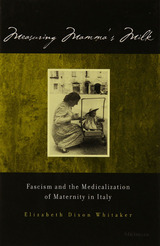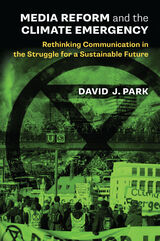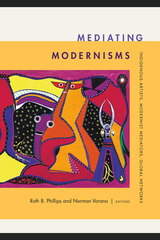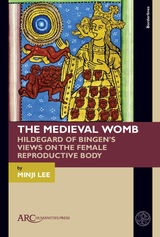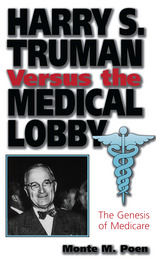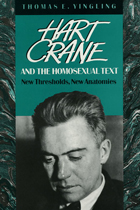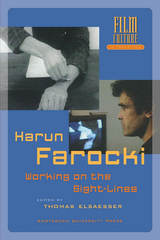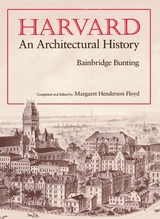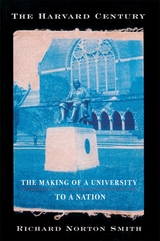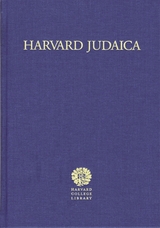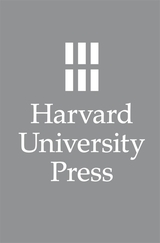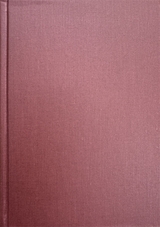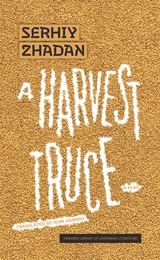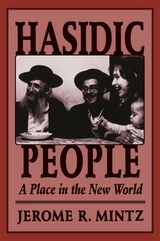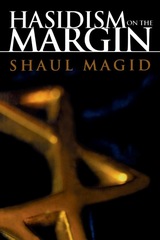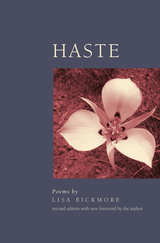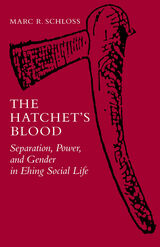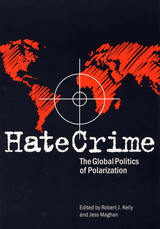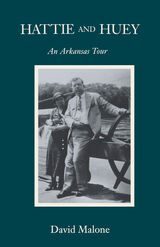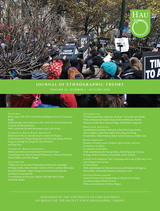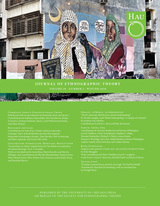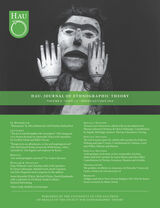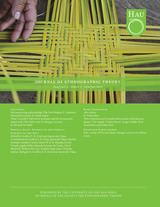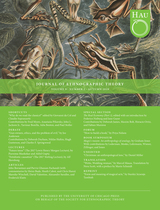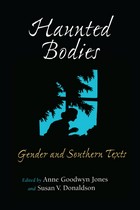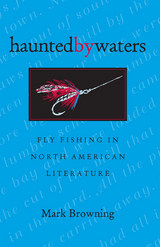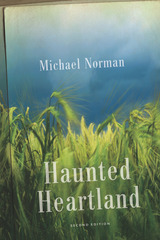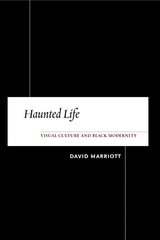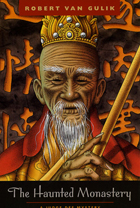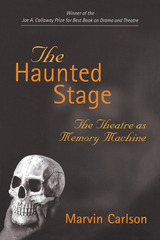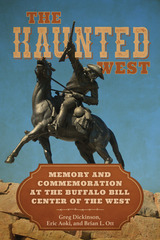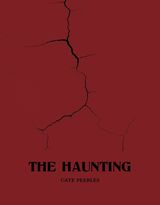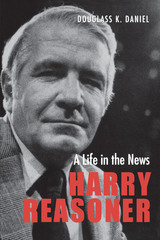 Harry Reasoner: A Life in the News
By Douglass K. Daniel
University of Texas Press, 2007 Harry Reasoner was one of the most trusted and well-liked journalists of the golden age of network television news. Whether anchoring the evening newscast on CBS in the 1960s or on ABC in the 1970s, providing in-depth reporting on 60 Minutes, or hosting numerous special programs covering civil rights struggles, the Vietnam War, and Watergate, Reasoner had "that almost mystical quality it seems to take for good television reporting, exuding this atmosphere of truth and believability," in the words of Walter Cronkite. Yet his reassuring manner and urbane, often witty, on-air persona masked a man who was far more complex and contradictory. Though gifted with the intelligence and drive to rise to the top of his profession, Reasoner was regarded by many colleagues as lazy and self-indulgent, a man who never achieved his full potential despite his many accomplishments. Harry Reasoner: A Life in the News covers the entire sweep of this enigmatic journalist's life and career. Douglass K. Daniel opens with Reasoner's Depression-era Midwestern upbringing and follows him through his early work in newspapers and radio before he joined CBS in 1956. Focusing on Reasoner's thirty-five-year tenure in television news, Daniel presents fascinating, behind-the-scenes accounts of Reasoner's key role in founding the top-rated newsmagazine 60 Minutes. He also explores Reasoner's highly publicized move to ABC in 1970, where he anchored the nightly newscast, first with Howard K. Smith and later with Barbara Walters—a disastrous pairing from which Reasoner's career never fully recovered. Based on scores of interviews and unpublished letters, memos, and other primary sources, this first biography of the man once rated second in credibility only to Walter Cronkite illuminates an entire era in broadcast journalism, as well as many of the unique personalities, from Andy Rooney to Mike Wallace, who made that era distinctive.
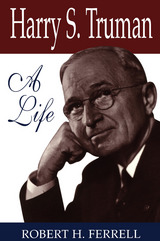 Harry S. Truman: A Life
Robert H. Ferrell
University of Missouri Press, 1995 Few U.S. presidents have captured the imagination of the American people as has Harry S. Truman, “the man from Missouri.” In this major new biography, Robert H. Ferrell, widely regarded as an authority on the thirty-third president, challenges the popular characterization of Truman as a man who rarely sought the offices he received, revealing instead a man who—with modesty, commitment to service, and basic honesty—moved with method and system toward the presidency. Truman was ambitious in the best sense of the word. His powerful commitment to service was accompanied by a remarkable shrewdness and an exceptional ability to judge people. He regarded himself as a consummate politician, a designation of which he was proud. While in Washington, he never succumbed to the “Potomac fever” that swelled the heads of so many officials in that city. A scrupulously honest man, Truman exhibited only one lapse when, at the beginning of 1941, he padded his Senate payroll by adding his wife and later his sister. From his early years on the family farm through his pivotal decision to use the atomic bomb in World War II, Truman’s life was filled with fascinating events. Ferrell’s exhaustive research offers new perspectives on many key episodes in Truman’s career, including his first Senate term and the circumstances surrounding the Truman Doctrine and the Marshall Plan. In addition, Ferrell taps many little-known sources to relate the intriguing story of the machinations by which Truman gained the vice presidential nomination in 1944, a position which put him a heartbeat away from the presidency. No other historian has ever demonstrated such command over the vast amounts of material that Robert Ferrell brings to bear on the unforgettable story of Truman’s life. Based upon years of research in the Truman Library and the study of many never-before-used primary sources, Harry S. Truman is destined to become the authoritative account of the nation’s favorite president.
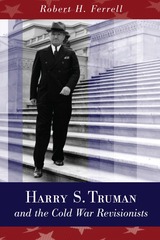 Harry S. Truman and the Cold War Revisionists
Robert H. Ferrell
University of Missouri Press, 2006 The idea of revising what is known of the past constitutes an essential procedure in historical scholarship, but revisionists are often hasty and argumentative in their judgments. Such, argues Robert H. Ferrell, has been the case with assessments of the presidency of Harry S. Truman, who was targeted by historians and political scientists in the 1960s and ’70s for numerous failings in both domestic and foreign policy, including launching the cold war—perceptions that persist to the present day. Widely acknowledged as today’s foremost Truman scholar, Ferrell turns the tables on the revisionists in this collection of classic essays. He goes below the surface appearances of history to examine how situations actually developed and how Truman performed sensibly—even courageously—in the face of unforeseen crises. While some revisionists see Truman as consumed by a blind hatred of the Soviet Union and adopting an unrestrainedly militant stance, Ferrell convincingly shows that Truman wished to get along with the Soviets and was often bewildered by their actions. He interprets policies such as the Truman Doctrine, the Marshall Plan, and support for NATO as prudent responses to perceived threats and credits the Truman administration for the ways in which it dealt with unprecedented problems. What emerges most vividly from Ferrell’s essays is a sense of how weak a hand the United States held from 1945 to1950, with its conventional forces depleted by the return of veterans to civil pursuits after the war and with its capacity for delivery of nuclear weapons in a sorry state. He shows that Truman regarded the atomic bomb as a weapon of last resort, not an instrument of policy, and that he took America into a war in Korea for the good of the United States and its allies. Although Truman has been vindicated on many of these issues, there still remains a lingering controversy over the use of atomic weapons in Japan—a decision that Ferrell argues is understandable in light of what Truman faced at the start of his presidency. Ferrell argues that the revisionists who attacked Truman understood neither the times nor the man—one of the most clearheaded, farsighted presidents ever to occupy the Oval Office. Harry S. Truman and the Cold War Revisionists shows us that Truman’s was indeed a remarkable presidency, as it cautions historians against too quickly appraising the very recent past.
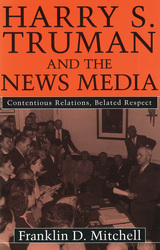 Harry S. Truman and the News Media: Contentious Relations, Belated Respect
Franklin D. Mitchell
University of Missouri Press, 1998
Based upon extensive research in the papers of President Harry S. Truman and in several journalistic collections, Harry S. Truman and the News Media recounts the story of a once unpopular chief executive who overcame the censure of the news media to ultimately win both the public's and the press's affirmation of his personal and presidential greatness.
Franklin D. Mitchell traces the major contours of journalism during the lifetime and presidency of Truman. Although newspapers and newsmagazines are given the most emphasis, reporters and columnists of the Washington news corps also figure prominently for their role in the president's news conferences and their continuing coverage of Truman and his family. Broadcast journalism's expanding coverage of the president is also explored through chapters dealing with radio and television.
President Truman's advocacy of a liberal Fair Deal for all Americans and a prudent and visible role for the nation in world affairs drew fire from the anti-administration news media, particularly the publishing empire of William Randolph Hearst, the McCormick-Patterson newspapers, the Scripps-Howard chain, and the Time-Life newsmagazines of Henry R. Luce. Despite press opposition and the almost universal prediction of defeat in the 1948 election, Truman was victorious in the greatest miscalled presidential election in journalistic history.
During his full term, Truman's relations with the news media became contentious over such matters as national security in the Cold War, the conduct of the Korean War, and the continuing charges of communism and corruption in the administration. Although Truman's career in politics was based on honesty and the welfare of the people, his early political alliance with Thomas Pendergast, Kansas City's notorious political boss, provided the opportunity for a portion of the press to charge Truman with subservience to Pendergast's own agenda of corrupt government.
The history and the dynamics of the Truman presidency and the American news media, combined with biographical and institutional sketches of key individuals and news organizations, make Harry S. Truman and the News Media a captivating and original investigation of an American president. Well written and researched, this book will be of great value to Truman scholars, journalists, and anyone interested in American history or presidential studies.
Harry S. Truman versus the Medical Lobby: The Genesis of Medicare
Monte M. Poen
University of Missouri Press, 1996 “I have some bitter disappointments as President,” reflected Harry Truman after leaving office, “but the one that has troubled me the most , in a personal way, has been the failure to defeat organized opposition to a national compulsory health-insurance program.” Harry S. Truman versus the Medical Lobby is a study of one aspect of Harry Truman’s domestic leadership and the political conflict it produced. In the book, author Monte Poen examines Truman’s quest for national health insurance in the light of the ongoing debate on the subject in this century. It reveals why Truman was the first president to advocate government-financed health care and why he repeatedly took the idea to Congress, despite insurmountable political obstacles.
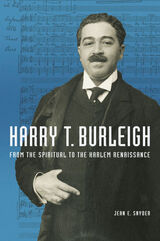 Harry T. Burleigh: From the Spiritual to the Harlem Renaissance
Jean E. Snyder
University of Illinois Press, 2021 Harry T. Burleigh (1866-1949) played a leading role in American music and culture in the twentieth century. Celebrated for his arrangements of spirituals, Burleigh was also the first African American composer to create a significant body of art song. An international roster of opera and recital singers performed his works and praised them as among the best of their time. Jean E. Snyder traces Burleigh's life from his Pennsylvania childhood through his fifty-year tenure as soloist at St. George's Episcopal Church in Manhattan. As a composer, Burleigh's pioneering work preserved and transformed the African American spiritual; as a music editor, he facilitated the work of other black composers; as a role model, vocal coach, and mentor, he profoundly influenced American song; and in private life he was friends with AntonÃn Dvořák, Marian Anderson, Will Marion Cook, and other America luminaries. Snyder provides rich historical, social, and political contexts that explore Burleigh's professional and personal life within an era complicated by changes in race relations, class expectations, and musical tastes.
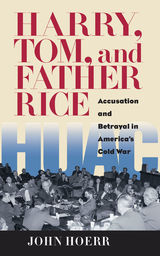 Harry, Tom, and Father Rice: Accusation and Betrayal in America’s Cold War
John Hoerr
University of Pittsburgh Press, 2007
John Hoerr tells the story of three men—his uncle, Congressman Harry Davenport, union leader Tom Quinn, and Father Charles Owen Rice—whose lives became intertwined during the anti-Communist witch hunts of the McCarthy Era. The story helps illuminate one of the more repressive periods in American history, when thousands of Americans guilty only of enlisting in leftist causes were caught up in dragnets cast by overzealous Communist hunters on behalf of the House Un-American Activities Committee and other bodies. Much has been written about well-known cultural figures (the Hollywood Ten), and prominent writers (Arthur Miller and Lillian Hellman) who contended with HUAC. Hoerr tells of mostly ordinary Americans who were largely unknown at the time, but whose stories are nonetheless remarkable.
Writing from personal experience with the title characters, as well as archival research, Hoerr recreates the events of the 1949 HUAC hearings, where rigged testimony by a few workers cast suspicion on their union brothers. The results would echo through the years, causing people to lose jobs, marriages, and self-respect. Hoerr traces the paths followed by Harry, Tom, and Father Rice and relates their individual experiences to the great conflict between anti-Communist and Communist forces in the American labor movement, leading to the eventual demise of the CIO (Congress of Industrial Organizations).
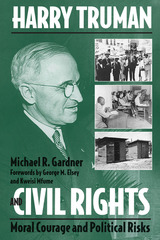 Harry Truman and Civil Rights: Moral Courage and Political Risks
Michael R. Gardner. Forewords by George M. Elsey and Kweisi Mfume
Southern Illinois University Press, 2002 Given his background, President Truman was an unlikely champion of civil rights. Where he grew up—the border state of Missouri—segregation was accepted and largely unquestioned. Both his maternal and paternal grandparents had owned slaves, and his mother, victimized by Yankee forces, railed against Abraham Lincoln for the remainder of her ninety-four years. When Truman assumed the presidency on April 12, 1945, Michael R. Gardner points out, Washington, DC, in many ways resembled Cape Town, South Africa, under apartheid rule circa 1985. Truman’s background notwithstanding, Gardner shows that it was Harry Truman—not Franklin D. Roosevelt, Dwight D. Eisenhower, or John F. Kennedy—who energized the modern civil rights movement, a movement that basically had stalled since Abraham Lincoln had freed the slaves. Gardner recounts Truman’s public and private actions regarding black Americans. He analyzes speeches, private conversations with colleagues, the executive orders that shattered federal segregation policies, and the appointments of like-minded civil rights activists to important positions. Among those appointments was the first black federal judge in the continental United States. One of Gardner’s essential and provocative points is that the Frederick Moore Vinson Supreme Court—a court significantly shaped by Truman—provided the legal basis for the nationwide integration that Truman could not get through the Congress. Challenging the myth that the civil rights movement began with Brown v. Board of Education under Chief Justice Earl Warren, Gardner contends that the life-altering civil rights rulings by the Vinson Court provided the necessary legal framework for the landmark Brown v. Board of Education decision. Gardner characterizes Truman’s evolution from a man who grew up in a racist household into a president willing to put his political career at mortal risk by actively supporting the interests of black Americans.
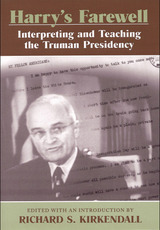 Harry's Farewell: Interpreting and Teaching the Truman Presidency
Edited & Intro by Richard S. Kirkendall
University of Missouri Press, 2004
Harry’s Farewell confronts the biggest issue of Truman historiography: the historical significance of Harry S. Truman’s presidency. Exploring the subject from the point of view of Truman’s Farewell Address of January 15, 1953, the book begins by describing the preparation of the address itself by the president and his closest advisers. In it, they challenged the negative view of his presidency that prevailed as he prepared to leave the White House. The book goes on to appraise the presidency in terms of the topics included in the address: the president and the people, the economy, civil rights, the bomb, Containment, Korea, and the end of the Cold War. Four essays follow that cover key topics that Truman did not mention in his speech: the Red Scare, women’s rights, ethnicity, and the environment. The book ends with essays by two major Truman biographers who present their own interpretations of his historical significance.
In addition to interpreting the Truman presidency, the book also deals with the needs of teachers who must bring this subject into their classrooms. Reflecting the importance of education for the Truman Library’s mission, Harry’s Farewell began as a conference at the library that brought researchers and teachers together for four days of conversation about interpretation and teaching. As a result, this book offers documents that teachers can use in their classes and includes an essay, based on the conversations, on ways of teaching the Truman presidency. In addition to being of great value to researchers and teachers, this book provides the general reader with a clearly focused collection of informative and provocative essays on Harry Truman, a man now widely regarded as a great American president.
 Hart Crane - American Writers 47: University of Minnesota Pamphlets on American Writers
Monroe K. Spears
University of Minnesota Press, 1965 Hart Crane - American Writers 47 was first published in 1965. Minnesota Archive Editions uses digital technology to make long-unavailable books once again accessible, and are published unaltered from the original University of Minnesota Press editions. The University of Minnesota Pamphlets on American Writers series provides concise, stimulating introductions to American writers of all periods. The pamphlet authors are critics and writers recognized for their competence in their particular fields. Each pamphlet devoted to a single writer contains biographical information, a discussion and critical evaluation of his work, and a selected bibliography. Teachers of American literature, both in the United States and abroad, in colleges, universities, and secondary schools find the pamphlets ideal for their students' use. For general readers and librarians they are equally useful and interesting.
 Hart Crane: A Re-Introduction
Warner Berthoff
University of Minnesota Press, 1989 Hart Crane was first published in 1989. Minnesota Archive Editions uses digital technology to make long-unavailable books once again accessible, and are published unaltered from the original University of Minnesota Press editions. More than half a century after his death, the work of Hart Crane (1899–1932) remains central to our understanding of twentieth-century American poetry. During his short life, Crane's contemporaries had difficulty seeing past the "roaring boy" who drank too much and hurled typewriters from windows; in recent years, he has come to be seen as a kind of "last poet" whose only theme is self-destruction, and who himself exemplifies the breakdown of poetry in the modern age. Taking as a point of departure Robert Lowell's 1961 valuation of Crane and his power to speak from "the center of things," Warner Berthoff in this book reappraises the essential character and force of Crane's still problematic achievement. Though he takes into account the substantial body of commentary on Crane's work, his primary intent is to look afresh at the poems themselves, and at the poet's clear-eyed (and brilliant) letters. This approach enables Berthoff, first, to track the emergence and development of Crane's lyric style—an art that recreates, in compact form, the turbulence of the modern city. He then explores the background and historical community that nourished Crane's creative imagination, and he evaluates Crane's conception of the ideal modern poetic: a poetry of ecstasy created with architectural craft. His final chapter is devoted to The Bridge, the ambitious lyric suite that proved to be the climax and terminus of Crane's work. Berthoff's emphasis throughout is on the beauty and power of individual poems, and on the sanity, shrewdness, and sense of purpose that informed Crane's working intelligence.
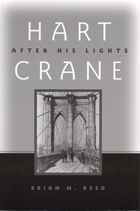 Hart Crane: After His Lights
Brian M. Reed
University of Alabama Press, 2006 A critical reassessment of the life’s work of a major American poet. With his suicide in 1932, Hart Crane left behind a small body of work—White Buildings (1926) and The Bridge (1930). Yet, Crane’s poetry was championed and debated publicly by many of the most eminent literary and cultural critics of his day, among them Van Wyck Brooks, Kenneth Burke, Robert Graves, Allen Tate, and Edmund Wilson. The Bridge appears in its entirety in the Norton Anthology of American Literature, and Crane himself has been the subject two recent biographies.
In Hart Crane: After His Lights, Brian Reed undertakes a study of Crane’s poetic output that takes into account, but also questions, the post-structural and theoretical developments in humanities scholarship of the last decade that have largely approached Crane in a piecemeal way, or pigeonholed him as represen-tative of his class, gender, or sexual orientation. Reed examines Crane’s career from his juvenilia to his posthumous critical reception and his impact on practicing poets following World War II. The first part of the study tests common rubrics of literary theory—nationality, sexuality, period—against Crane’s poetry, and finds that these labels, while enlightening, also obfuscate the origin and character of the poet’s work. The second part examines Crane’s poetry through the process of its composition, sources, and models, taking up questions of style, genealogy, and genre. The final section examines Crane’s influence on subsequent generations of American poets, especially by avant-garde literary circles like the New American poets, the Black Mountain School, the New York School, and the Beats.
The result is a study that complicates and enriches our understandings of Crane’s poetry and contributes to the ongoing reassessment of literary modernism’s origins, course, and legacy.
Hart Crane and the Homosexual Text: New Thresholds, New Anatomies
Thomas E. Yingling
University of Chicago Press, 1990 "Canonized for being insufficiently American although he took America as his subject, chastised for obscurity by readers who would not allow or would not read homosexual meanings, Crane embodies many understandings of America, and of the predicament of the gay writer."—Voice Literary Supplement
"A brilliant critical model for understanding how textuality and sexuality can produce pervasive effects on each other in the writing of a figure like Crane."—Michael Moon, Duke University
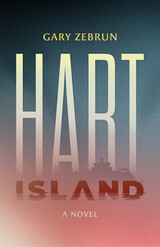 Hart Island
Gary Zebrun
University of Wisconsin Press, 2024 Hart Island has served as a potter’s field for more than a century, holding over a million indigent, unclaimed, or unknown New Yorkers’ bodies—and yet it is little-known even among locals. In this absorbing and elegiac story, on this island shaped like a miniature boot of Italy, Gary Zebrun explores overlapping connections of family, crime, sexuality, and human decency.
Driven out of the Coast Guard during the days of “Don’t Ask, Don’t Tell,” Sal Cusumano hauls coffins to Hart Island with a burial crew of Rikers Island inmates and guards. Only there can he fully leave his family troubles on Staten Island behind: Justin, his adopted brother and lover; his mother, Ida, slipping rapidly into dementia; the memory of Francesco, his father, a bookie gunned down on his stoop; and his brother Antony, a Manhattan homicide detective moonlighting with the mob. But the island ceases to be his sanctuary after Antony ensnares him—and others—in a crime that involves a nocturnal visit to the potter’s field.
This compelling and intricately plotted novel moves through the shadows as its characters yearn for belonging and forgiveness. Set on the eve of the COVID pandemic, it is part love story, part crime novel, and part mystery.
Harun Farocki: Working the Sight-lines
Edited by Thomas Elsaesser
Amsterdam University Press, 2004 Filmmaker, film essayist, installation artist, writer: the Berlin artist Harun Farocki has devoted his life to the power of images. Over the thirty-plus years of his career, Farocki has explored not the images of life but rather the life of images that surrounds us in newspapers, cinema, books, television, and advertising. Harun Farocki examines, from different critical perspectives, his vast oeuvre, which includes three feature films, critical media pieces, children’s television features, “learning films” in the tradition of Brecht, and installation pieces. Interviews, a selection of Farocki’s own writings, and an annotated filmography complete a valuable biography of this pioneering artist and his legendary career.
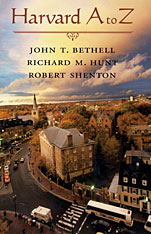 Harvard A to Z
John T. Bethell, Richard M. Hunt, and Robert Shenton
Harvard University Press, 2004 Open this book and step into the storied corridors of the nation’s oldest university; encounter the historic landmarks and curiosities; and among them, meet the famous dropouts and former students, the world-class scholars, eccentrics, and prodigies who have given the institution its incomparable character.
An alphabetical compendium of short but substantial essays about Harvard University—its undergraduate college and nine professional schools—this volume traverses the gamut of Harvardiana from Aab and Admissions to X Cage and Z Closet. In between are some two hundred entries written by three Harvard veterans who bring to the task over 125 years of experience within the university. The entries range from essential facts to no less interesting ephemera, from the Arnold Arboretum designed by Frederick Law Olmsted to the peculiar medical specimens of the Warren Museum; from Arts and Athletics to Towers and Tuition: from the very real environs (Cambridge, Charles River, and Quincy Street) to the Harvard of Hollywood and fiction.
Harvard A to Z is a browser’s delight, offering readers the chance to dip into the history and lore, the character and culture of America’s foremost institution of higher learning.
Harvard: An Architectural History
Bainbridge Bunting
Harvard University Press Here is an incisive and fully illustrated history of Harvard’s architecture told by the distinguished architectural historian Bainbridge Bunting, author of Houses of Boston’s Back Bay. The book examines the Federal architecture of Charles Bulfinch, H. H. Richardson’s Romanesque buildings, the Imperial manner reflected in Widener Library, as well as the work of such esteemed architects as Charles McKim, Gropius, and Le Corbusier—and it shows us how they all come together to form an amazingly coherent whole. This lively story of a university campus is a veritable microcosm of American architectural experience.
 The Harvard Biographical Dictionary of Music
Don Michael Randel
Harvard University Press, 1996 An incomparable guide to the thousands of characters, from humble artisan to lofty genius, who people the unfolding history of music, this volume brings together all the pertinent biographical information about composers, performers, music theorists, and instrument makers from the days of praise chants to the bop and pop of today. A long-awaited companion to The Harvard Dictionary of Music, and compiled with the same meticulous scholarship and delight in detail, this biographical dictionary emphasizes classical and art music, but also gives ample attention to jazz and blues, rock and pop, and hymns and show tunes across the ages—with unusual care devoted to coverage of the twentieth century.
That the Belgian composer Jean Absil was professor of fugue at the Brussels Conservatory is a little-known fact. And few are aware that Roy Acuff began his country-and-western career in medicine shows. The writings of the seventeenth-century organist Jakob Adlung may be obscure, while Theodor Adorno’s are widely read and studied. But they can all be found in the As, along with 218 more entries, from Herb Alpert and the Andrews Sisters to Carl Friedrich Abel and Emanuel Ax. And this is only the beginning.
Here then is the information you need about 5,500 figures in the world of music—the major, the minor, the famous, the nearly forgotten, from Bach and Beethoven to Irving Berlin, Benny Goodman, and Bruce Springsteen—capsule summaries of the lives and careers behind the music enjoyed in every era. The volume is enlivened with illustrations, some revelations in themselves. A compendium that no music lover should be without, this rich volume, along with The Harvard Dictionary of Music, constitutes the standard reference work for the musically inclined, the curious, the informed, and the expert.
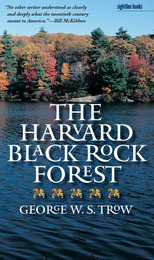 The Harvard Black Rock Forest
George W.S. Trow
University of Iowa Press, 2004 Originally published in the June 11, 1984, New Yorker, this lengthy essay is a sharp-edged inquiry into the generational institutions of our national life. With the same iconoclastic spirit and multilayered prose that he interwove in his classic Within the Context of No Context, George Trow tells the story of upstate New York’s Black Rock Forest—a thirty-eight-hundred-acre site overlooking the Hudson River—through the lives of the men who were connected to it and through the larger histories of Harvard University, U.S. conservation policies, and physics and biology. The men: banker James Stillman; his son, Ernest Stillman, a medical doctor who inherited the land that would become the Black Rock Forest in 1928 and who wanted to make it healthy and useful; the legendary Gifford Pinchot, appointed chief forester of the U.S. in 1898; and Richard Thornton Fisher, for many years the head of the Harvard Forest and the man who suggested to Ernest Stillman that he turn his inherited land into another demonstration forest. Harvard University: a more financially focused, less collegial environment than the one that had accepted the gift of the forest in 1949, now looking to shed responsibility for the forest without shedding the money its sale would bring. The challenge: How to manage, how to value, a wilderness area of great biological diversity. In his brilliantly elastic fashion, Trow maneuvers images, symbols, ambiguities, ethics, journalistic wordplay, advertising tricks, and corporate doublespeak to create an intensely perceptive analysis of the cultural, political, and scientific communities. His richly developed story of the Harvard Black Rock Forest is ultimately a symbolic tale that bears upon some of the most significant institutions, professions, and legacies in contemporary American life. A publisher’s note reveals the fate of the forest.
 The Harvard Book of Contemporary American Poetry
Helen Vendler
Harvard University Press, 1985 Join Professor Helen Vendler in her course lecture on the Yeats poem "Among School Children". View her insightful and passionate analysis along with a condensed reading and student comments on the course.
The poetry collected in this volume reveals the range and power of the contemporary American imagination. The verve, freedom, and boldness of American English are combined with the new harmonies of modern cadence. Here are distillations of twentieth-century perception, feeling, and thought, and reflections of changing social realities, scientific and psychoanalytic insights, and the strong voices of feminism and black consciousness. This is a book for those who value fresh and original poetry and for readers worldwide who are curious about contemporary American experience.
Helen Vendler relies on her own taste and judgment in singling out excellent poems, beginning with the late modernist flowering of Wallace Stevens and continuing to the present. Her wide-ranging Introduction places recent American poetry in its aesthetic and social contexts. The anthology provides an extensive offering of the work of major poets and introduces many writers who are only now beginning to make their reputation. Thirty-five poets are included, with a representative selection from the earlier to later work of each and a significant number of long poems. Brief biographies of the poets are appended.
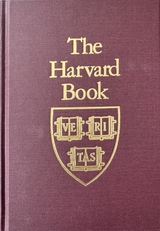 The Harvard Book: Selections from Three Centuries, Revised Edition
William Bentinck-Smith
Harvard University Press, 1982 If Harvard can be said to have a literature all its own, then few universities can equal it in scope. Here lies the reason for this anthology—a collection of what Harvard men (teachers, students, graduates) have written about Harvard in the more than three centuries of its history. The emphasis is upon entertainment, upon readability; and the selections have been arranged to show something of the many variations of Harvard life.
For all Harvard men—and that part of the general public which is interested in American college life—here is a rich treasury. In such a Harvard collection one may expect to find the giants of Harvard’s last 75 years—Eliot, Lowell, and Conant—attempting a definition of what Harvard means. But there are many other familiar names—Henry Dunster, Oliver Wendell Holmes, James Russell Lowell, Henry Adams, Charles M. Flandrau, William and Henry James, Owen Wister, Thomas Wolfe, John P. Marquaud. Here is Mistress Eaton’s confession about the bad fish served to the wretched students of Harvard’s early years; here too is President Holyoke’s account of the burning of Harvard Hall; a student’s description of his trip to Portsmouth with that aged and Johnsonian character, Tutor Henry Flynt; Cleveland Amory’s retelling of the murder of Dr. George Parkman; Mayor Quiney’s story of what happened in Cambridge when Andrew Jackson came to get an honorary degree; Alistair Cooke’s commentary on the great Harvard–Yale cricket match of 1951. There are many sorts of Harvard men in this book—popular fellows like Hammersmith, snobs like Bertie and Billy, the sensitive and the lonely like Edwin Arlington Robinson and Thomas Wolfe, and independent thinkers like John Reed. Teachers and pupils, scholars and sports, heroes and rogues pass across the Harvard stage through the struggles and the tragedies to the moments of triumph like the Bicentennial or the visit of Winston Churchill.
And speaking of visits, there are the visitors too—the first impressions of Harvard set down by an assortment of travelers as various as Dickens, Trollope, Rupert Brooke, Harriet Martineau, and Francisco de Miranda, the “precursor of Latin American independence.”
For the Harvard addict this volume is indispensable. For the general reader it is the sort of book that goes with a good living-room fire or the blissful moments of early to bed.
The Harvard Century: The Making of a University to a Nation
Richard Norton Smith
Harvard University Press The Harvard Century tells the story of how Harvard, America’s oldest and foremost institution of higher learning, has become synonymous with the nation, their goals and standards reflecting each other, each setting the other’s agenda. It is also a colorful and intimate narrative of the individual achievements of its leaders and of the intense power struggles that have shaped Harvard as it pioneered in setting the priorities that have served as exemplars for the nation’s educational establishment.
 Harvard College in the Seventeenth Century
Samuel Eliot Morison
Harvard University Press Interesting though the first volume of Professor Morison’s tercentenary history of Harvard was, this second volume is even more so from many points of view. There are, for instance, a chapter which takes the student through his day from rising bell and morning bever to dinner, supper, and bed; another on college amusements, brawls, and pranks of the century; still another on student life at the end of the century, with an amusing account of the excursion of Tutors Leverett and Brattle with their pupils to Manhattan. The most important contribution to educational history consists in seven chapters on the curriculum, which give for the first time a detailed account of methods, subjects, and books. The financial history of the College is continued with notes on some of the important benefactions. Much attention is paid to the personality of the Presidents: Dunster, Chauncy, Hoar, Oakes, and Increase Mather.
 The Harvard College Observatory: The First Four Directorships
Bessie Zaban Jones and Lyle Gifford Boyd
Harvard University Press, 1971 Since its founding in 1839, the Harvard College Observatory has pioneered in the development of modern astronomy. Its first directors early recognized the potential of spectroscopy in revealing the constitution of the stars, and of photography in determining the positions and motions of celestial objects; the library of photographic plates made under their direction provides an invaluable history of the stellar universe for the period. The Observatory also pioneered in using the talents of women, several of whom became noted astronomers, and their monumental classification of stars from spectral records constitutes a fundamental contribution to astronomical knowledge.
The authors vividly portray the genesis, growth, and achievements of a major scientific institution and its relations with other observatories. Through the use of photographs and correspondence they also portray the men and women who played essential roles in the development of astronomy in the nineteenth and early twentieth centuries.
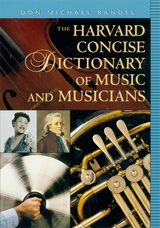 The Harvard Concise Dictionary of Music and Musicians
Don Michael Randel
Harvard University Press, 1999 This new compact guide to the history and performance of music is both authoritative and a pleasure to use. With entries drawn and condensed from the widely acclaimed The New Harvard Dictionary of Music and its companion The Harvard Biographical Dictionary of Music, it is a dependable reference for home and classroom and for professional and amateur musicians.
This concise dictionary offers definitions of musical terms; succinct characterizations of the various forms of musical composition; entries that identify individual operas, oratorios, symphonic poems, and other works; illustrated descriptions of instruments; and capsule summaries of the lives and careers of composers, performers, and theorists. Like its distinguished parent volumes, The Harvard Concise Dictionary of Music and Musicians provides information on all periods in music history, with particularly comprehensive coverage of the twentieth century.
Clearly written and based on vast expertise, The Harvard Concise Dictionary of Music and Musicians is an invaluable handbook for everyone who cares about music.
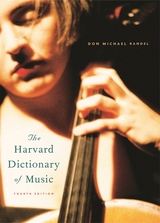 The Harvard Dictionary of Music: Fourth Edition
Don Michael Randel
Harvard University Press, 2003 This classic reference work, the best one-volume music dictionary available, has been brought completely up to date in this new edition. Combining authoritative scholarship and lucid, lively prose, the Fourth Edition of The Harvard Dictionary of Music is the essential guide for musicians, students, and everyone who appreciates music.
The Harvard Dictionary of Music has long been admired for its wide range as well as its reliability. This treasure trove includes entries on all the styles and forms in Western music; comprehensive articles on the music of Africa, Asia, Latin America, and the Near East; descriptions of instruments enriched by historical background; and articles that reflect today’s beat, including popular music, jazz, and rock. Throughout this Fourth Edition, existing articles have been fine-tuned and new entries added so that the dictionary fully reflects current music scholarship and recent developments in musical culture.
Encyclopedia-length articles by notable experts alternate with short entries for quick reference, including definitions and identifications of works and instruments. More than 220 drawings and 250 musical examples enhance the text. This is an invaluable book that no music lover can afford to be without.
 Harvard Dictionary of Music: Second Edition, Revised and Enlarged
Willi Apel
Harvard University Press, 1969 A classic and invaluable reference work. Soon after its initial publication, the Harvard Dictionary of Music by Willi Apel was firmly established as a standard and essential resource for everyone concerned with music. The product of exceptional scholarship, it was praised as being comprehensive, concise, authoritative, scholarly, and enjoyable. Leopold Stokowski wrote, “I so often consult your dictionary of music, and with such never failing enlightenment, that I must offer you my thanks for your unique book, so profound and so broad in scope… The vast scholarship…is of immeasurable value to the whole world of music.”
For this second edition the dictionary has been thoroughly revised, updated, and substantially enlarged. Apel and eighty-eight other eminent music scholars have contributed new articles and revised old ones completely. The already comprehensive list of accurate definitions has grown measurably and it now even includes nothus, pyiba, and merengue.
In the greatly expanded coverage of ethnomusicology, cumbia—an Afro-Panamanian dance form—and Vietnam are only two of the new entries. Additionally, all the general information about individual countries has been revised and the discussion of both theory and history has been amply increased. Developments of the last two decades are given special attention with particular emphasis on compositional techniques, including electronic music and serial music. Individual compositions, representative of every type from every era, are described. The bibliography following each article, a unique feature of the first edition, has been updated and expanded. There are fifty percent more illustrations than in the first edition, including explicit drawings of instruments, clear music examples, diagrams, charts and a full-page outline of the history of music.
An extensive list of the most important music libraries and collections throughout the world with summaries of their significant musical holdings is a valuable part of the dictionary. The section on historical editions now lists fifty-three collections of music and briefly describes each volume within each collection.
The Harvard Dictionary of Music, Second Edition, Revised and Enlarged, is the result of imaginative, specialized, modern, and reliable music scholarship. Containing nearly 1,000 pages of precise and accessible information on all musical subjects, it offers over fifty percent more material than the first edition. It is essential not only to the scholar of music, the professional performer, and the practicing amateur, but to everyone who has ever anticipated the pleasure of a weekly musical broadcast, purchased a favorite recording, or truly enjoyed a concert.
 Harvard Encyclopedia of American Ethnic Groups
Stephan Thernstrom, EditorAnn Orlov, Managing EditorOscar Handlin, Consulting Editor
Harvard University Press, 1980 From Acadians to Zoroastrians-Asians, American Indians, East Indians, West Indians, Europeans, Latin Americans, Afro-Americans, and Mexican Americans—the Harvard Encyclopedia of American Ethnic Groups provides the first comprehensive and systematic review of the many peoples of this country. It should excite all Americans about their nation.
Informative and entertaining, this volume is an indispensable reference work for home, library and office. It establishes a foundation for the burgeoning field of ethnic studies; it will satisfy and stimulate the popular interest in ancestry and heritage. It is a guide to the history, culture, and distinctive characteristics of the more than 100 ethnic groups who live in the United States.
Each ethnic group is described in detail. The origins, history and present situation of the familiar as well as the virtually unknown are presented succinctly and objectively. Not only the immigrants and refugees who came voluntarily but also those already in the New World when the first Europeans arrived, those whose ancestors came involuntarily as slaves, and those who became part of the American population as a result of conquest or purchase and subsequent annexation figure in these pages. The English and the Estonians, the Germans and the Gypsies, the Swedes and the Serbs are interestingly juxtaposed. Even entries about relatively well-known groups offer new material and fresh interpretations. The articles on less well-known groups are the product of intensive research in primary sources; many provide the first scholarly discussion to appear in English. One hundred and twenty American and European contributors have been involved in this effort, writing either on individual groups or on broad themes relating to many.
The group entries are at the heart of the book, but it contains, in addition, a series of thematic essays that illuminate the key facets of ethnicity. Some of these are comparative; some philosophical; some historical; others focus on current policy issues or relate ethnicity to major subjects such as education, religion, and literature. American identity and Americanization, immigration policy and experience, and prejudice and discrimination in U.S. history are discussed at length. Several essays probe the complex interplay between assimilation and pluralism—perhaps the central theme in American history—and the complications of race and religion.
Numerous cross-references and brief identifications will aid the reader with unfamiliar terms and alternative group names. Eighty-seven maps, especially commissioned, show where different groups have originated. Annotated bibliographies contain suggestions for further reading and research. Appendix I, on methods of estimating the size of groups, leads the reader through a maze of conflicting statistics. Appendix II reproduces, in facsimile, hard-to-locate census and immigration materials, beginning with the first published report on the nativities of the population in 1850.
 Harvard Guide to American History, Volumes I and II: Revised Edition
Frank Freidel
Harvard University Press, 1974 The Harvard Guide has a long and distinguished history in the annals of reference works. First prepared in 1896 by Albert Bushnell Hart and Edward Channing, it was a unique scholarly tool. Revised in 1912 by Hart, Channing, and Frederick Jackson Turner, the Guide carried its entries through 1910 and became the standard text.
In 1954 the Harvard Guide to American History appeared, prepared and edited by members of the History Department of Harvard: Oscar Handlin, Arthur Meier Schlesinger, Samuel Eliot Morison, Frederick Merk, Arthur Meier Schlesinger, Jr., and Paul Herman Buck. A one-volume compendium, the Guide became a classic in historical studies and won a place in every important library—both public and private—of American history.
With its revised republication in 1974, Frank Freidel and Richard K. Showman have made the Guide the most essential reference book for historians. Their work was sponsored by the Charles Warren Center for Studies in American History at Harvard. This thoroughly revised, comprehensive guide to American history reflects the explosive growth in historical publications and materials, and the expanding interests of American historians. About one third of the entries are new. These not only represent the surge of books and articles, but also reflect new areas of history. The brief topical sections in the last edition have grown into a 300-page coverage of economic, social, and intellectual history. Demography, social structure, ethnicity, and the new urban and cultural dimensions of history find a place. Colonial history receives both topical and chronological treatment in an all-inclusive section. United States history since 1759, primarily political and diplomatic, appears in the familiar chronological form.
Enlarged and up-to-date sections cover research methods and material. There are practical suggestions on research, writing, and publication, and extensive citation of finding aids and bibliographies to introduce the user to collections of printed materials, public documents, microform, manuscripts, and archives. The section on care and editing of manuscripts, long standard on the subject, appears unchanged; other sections, such as those on automated data retrieval, quantitative techniques, and oral history, reflect innovations in the historian’s craft. The new Guide has been recast in columnar form to make it easier to locate references and includes cross-reference by pages and sections to facilitate faster use.
 The Harvard Guide to Psychiatry: Third Edition
Armand M. Nicholi Jr., M.D.
Harvard University Press, 1999 Four years in the making, this entirely revised edition of a classic text provides a lucid and erudite review of the state of psychiatry today. Since the publication of the last edition in 1988, remarkable advances have been made in laboratory and clinical psychiatric research; the fourth edition of the Diagnostic and Statistical Manual of Mental Disorders (DSM-IV) has been published; managed care has radically altered the provision of all medical care; and the profession of psychiatry has come to a sophisticated new understanding of the interplay between psychiatric knowledge and issues in the larger society.
All these changes are reflected in the new text. Of particular interest are the masterful and lucid reviews of current knowledge in the neurobiology of mental disorders, in the section on brain and behavior. The section on psychopathology clarifies newly emerging diagnostic categories and offers new insight into addictions, anxiety disorders, and disorders of cognition.
Like its predecessors, The Harvard Guide To Psychiatry focuses throughout on the relationship between the physician and the patient. Its unspoken motto is that the art of psychiatry is as important as the science. For this recognition of what is relevant clinically as well as technically, this book will be an essential reference and support for both the new and the experienced psychiatrist.
This new edition includes up-to-date discussions of:DSM-IVManaged careImprovements in neuroimagingThe increased use of psychoactive drugsRecent advances in molecular biologyResearch on the biology of schizophrenia, depression, anxiety, and addictive disorders
The Harvard Guide to Women’s Health
Karen J. Carlson M.D.; Stephanie A. Eisenstat, M.D.; Terra Ziporyn, Ph.D.
Harvard University Press, 1996 THIS EDITION HAS BEEN REPLACED BY A NEWER 2004 EDITION.
With the publication of The Harvard Guide to Women's Health, women will have access to the combined expertise of physicians from three of the world's most prestigious medical institutions: Harvard Medical School, Massachusetts General Hospital, and Brigham and Women's Hospital. For complete information on women's health concerns, physical and psychological, this A to Z reference book will be the definitive resource.
The Harvard List of Books in Psychology: Fourth Edition
The Psychologists in Harvard University
Harvard University Press The Harvard List of Books in Psychology was first compiled in the 1930s, when each student in the department enjoyed the luxury of an individual tutorial. Together tutor and student could map out a course of reading. By 1938, the list had proved so useful that its 349 titles were annotated and printed, though mainly for local consumption. Growth of an outside demand from students, librarians, and the reading public led to a supplement in 1944 and a number of successive editions bearing the present title. The present edition updates the List without expanding it beyond useful size: for each new title the compilers have faithfully tried to delete one, and new entries account for almost half of the present total of 744. Each title is annotated with descriptive and evaluative material.
 Harvard Observed: An Illustrated History of the University in the Twentieth Century
John T. Bethell
Harvard University Press, 1998 In the early years of the twentieth century, President Charles William Eliot fought to keep Harvard from becoming a refuge for “the stupid sons of the rich.” A. Lawrence Lowell, a tireless builder, gave the modern University its physical structure. James Conant helped forge a wartime alliance of universities, industry, and government that sustained an astonishingly prosperous postwar epoch.
Their successors saw Harvard through the turbulent 1960s and 1970s, adapting the University’s programs and policies to the needs of a rapidly changing society, strengthening longstanding bonds with international institutions, and creating new ties to the cultures of Japan, China, and other Eastern nations.
In words and pictures, Harvard Observed documents the shaping of the singular institution that poet and essayist David McCord, a former Harvard Alumni Bulletin editor, called “the haven of scholars and teachers, the laboratory of scientists and technicians, the church of the theologian, the crow’s nest of the visionary, the courtroom of the law, the forum of the public servant. It is gallery, concert hall, and stage; the out-patient ward for the medical student, counting-house of the businessman, classroom of the nation, lecture platform for the visitor, library to the world; and…‘on of the great achievements of American democracy.’”
Depicting the evolution of twentieth-century Harvard in the broader context of national and world events, Harvard Observed has much to say and show about the academic rites, intellectual arguments, sexual mores, fads, and folklore that became touchstones for successive generations of Harvardians. Photographs, drawings, and paintings from the University’s vast archival collections and museums add a compelling visual dimension.
Harvard Portraits: A Catalogue of Portrait Paintings at Harvard University. Compiled by Laura M. Huntsinger under the direction of Edward Waldo Forbes.
Harvard University
Harvard University Press Except for the collection of legal portraits in the Harvard Law School and the collection of Indian portraits in the Peabody Museum, this catalogue lists and describes 390 of the many portraits scattered through the buildings of Harvard University. The portraits were not donated or purchased wholly from the art collector’s point of view. The emphasis rests, rather, on the personalities of Harvard men, the great majority of the portraits representing officers of the University, prominent graduates, benefactors, and leaders in science and government. Nevertheless the volume presents a compendium of tastes in portraiture from the middle of the eighteenth century down to the present. It is accordingly an invaluable guide both for the collector and for the student of Harvard history.
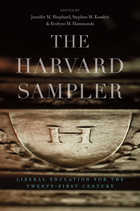 The Harvard Sampler: Liberal Education for the Twenty-First Century
Jennifer M. Shephard
Harvard University Press, 2011 From Harvard University, one of the world’s preeminent institutions of
liberal education, comes a collection of essays sampling topics at the forefront of academia in the twenty-first century. Written by faculty members at the cutting edge of their fields, including such luminaries as Steven Pinker, Laurel Thatcher Ulrich, and Harry R. Lewis, these essays offer a clear and accessible overview of disciplines that are shaping the culture, and even the world.
The authors, among the most respected members of Harvard’s faculty, invite readers to explore subjects as diverse as religious literacy and Islam, liberty and security in cyberspace, medical science and epidemiology, energy resources, evolution, morality, human rights, global history, the dark side of the American Revolution, American literature and the environment, interracial literature, and the human mind. They summarize key developments in their fields in ways that will both entertain and edify those who seek an education beyond the confines of the classroom.
It is sometimes said that youth is wasted on the young. It could also be said that college, too often, is wasted on college students—that only after graduating does a former student come to appreciate learning. To those wishing to revisit the college classroom—as well as to those who never had the opportunity in the first place—this book gives a taste of the modern course at Harvard. The essays are stimulating and informative, and the annotated bibliographies accompanying each chapter provide invaluable guidance to the life-long learner who wants to pursue these fascinating topics in depth.
Harvard Slavic Studies, Volume 5
Horace G. Lunt
Harvard University Press The fifth volume in this series of long essays in the field of Slavic letters and intellectual history presents three studies. Thomas Butler has analyzed the attacks of Vuk Karadžić on the language of the popular novelist Milovan Vidaković. George Siegel discusses a theme of importance to many Russian writers in “The Fallen Woman in Nineteenth-Century Russian Literature.” And in “The Poetry of Georgij Ivanov,” Irina Agushi presents the first comprehensive analysis of one of the most gifted and successful of the emigré Russian poets.
 Harvard Studies in Classical Philology, Volume 100
Charles Segal
Harvard University Press This volume celebrates 100 years of Harvard Studies in Classical Philology. It contains essays by Harvard faculty, emeriti, currently enrolled graduate students, and most recent Ph.D.s. It displays the range and diversity of the study of the Classics at Harvard at the beginning of the twenty-first century.
Volume 100 includes: E. Badian, “Darius III”; D. R. Shackleton Bailey, “On Statius’ Thebaid”; Brian W. Breed, “Silenus and the Imago Vocis in Eclogue 6”; Wendell Clausen, “Propertius 2.32.35–36”; Kathleen Coleman, “Missio at Halicarnassus”; Stamatia Dova, “Who Is μακάρτατος in the Odyssey?”; Casey Dué, “Tragic History and Barbarian Speech in Sallust’s Jugurtha”; John Duffy and Dimiter Angelov, “Observations on a Byzantine Manuscript in Harvard College Library”; Mary Ebbott, “The List of the War Dead in Aeschylus’ Persians”; Gloria Ferrari, “The Ilioupersis in Athens”; José González, “Musai Hypophetores: Apollonius of Rhodes on Inspiration and Interpretation”; Albert Henrichs, “Drama and Dromena: Bloodshed, Violence, and Sacrificial Metaphor in Euripides”; Alexander Hollmann, “Epos as Authoritative Speech in Herodotos’ Histories”; Thomas E. Jenkins, “The Writing in (and of) Ovid’s Byblis Episode”; Christopher Jones, “Nero Speaking”; Prudence Jones, “Juvenal, the Niphates, and Trajan’s Column (Satire 6.407–412)”; Leah J. Kronenberg, “The Poet’s Fiction: Virgil’s Praise of the Farmer, Philosopher, and Poet at the End of Georgics 2”; Olga Levaniouk, “Aithôn, Aithon, and Odysseus”; Nino Luraghi, “Author and Audience in Thucydides’ Archaeology. Some Reflections”; Gregory Nagy, “‘Dream of a Shade’: Refractions of Epic Vision in Pindar’s Pythian 8 and Aeschylus’ Seven against Thebes”; Corinne Ondine Pache, “War Games: Odysseus at Troy”; David Petrain, “Hylas and Silva: Etymological Wordplay in Propertius 1.20”; Timothy Power, “The Parthenoi of Bacchylides 13”; Eric Robinson, “Democracy in Syracuse, 466–412 B.C.”; Charles Segal, “The Oracles of Sophocles’ Trachiniae: Convergence or Confusion?”; Zeph Stewart, “Plautus’ Amphitruo: Three Problems”; Sarolta A. Takàcs, “Politics and Religion in the Bacchanalian Affair of 186 B.C.E.”; R. J. Tarrant, “The Soldier in the Garden and Other Intruders in Ovid’s Metamorphoses”; Richard F. Thomas, “A Trope by Any Other Name: ‘Polysemy,’ Ambiguity, and Significatio in Virgil”; Michael A. Tueller, “Well-Read Heroes Quoting the Aetia in Aeneid 8”; and Calvert Watkins, “A Distant Anatolian Echo in Pindar: The Origin of the Aegis Again.”
 Harvard Studies in Classical Philology, Volume 101
Department of Classics Harvard University
Harvard University Press Volume 101 of Harvard Studies in Classical Philology includes the following contributions: Stephen Scully, “Reading the Shield of Achilles: Terror, Anger, Delight”; Hugh Lloyd-Jones, “Zeus, Prometheus, and Greek Ethics”; Robert W. Wallace, “An Early Fifth-Century Athenian Revolution in Aulos Music”; Lucia Athanassaki, “Transformations of Colonial Disruption into Narrative Continuity in Pindar’s Epinician Odes”; Christina Clark, “Minos’ Touch and Theseus’ Glare: Gestures in Bakkhylides 17”; Peter Grossardt, “The Title of Aeschylus’ Ostologoi”; John Gibert, “Apollo’s Sacrifice: The Limits of a Metaphor in Greek Tragedy”; Albert Henrichs, “Hieroi Logoi and Hierai Bibloi: The (Un)Written Margins of the Sacred in Ancient Greece”; David M. Engel, “Women’s Role in the Home and the State: Stoic Theory Reconsidered”; James J. Clauss, “Once upon a Time on Cos: A Banquet with Pan on the Side in Theocritus Idyll 7”; Alexander Sens, “Pleasures Recalled: A.R. 3.813–814, Asclepiades, and Homer”; Christopher S. Mackay, “Quaestiones Pisonianae: Procedural and Chronological Notes on the S.C. De Cn. Pisone Patre”; Alex Hardie, “The Pindaric Sources of Horace Odes 1.12”; Charles E. Murgia, “The Date of the Helen Episode”; Mark Toher, “Nicolaus and Herod in the Antiquitates Judaicae”; W. S. Watt,† “Notes on the Anthologia Latina”; D. R. Shackleton Bailey, “New Readings in Valerius Maximus”; and R. Sklenář, “The Cosm(et)ology of Claudian’s ‘In Sepulchrum Speciosae.’”
 Harvard Studies in Classical Philology, Volume 102
Albert Henrichs
Harvard University Press Volume 102 of Harvard Studies in Classical Philology includes the following contributions: Mika Kajava, “Hestia: Hearth, Goddess, and Cult”; Jonathan Burgess, “Untrustworthy Apollo and the Destiny of Achilles: Iliad 24.55–63”; Anna Bonifazi, “Relative Pronouns and Memory: Pindar beyond Syntax”; William Race, “Pindar’s Olympian 11 Re-Visited Post-Bundy”; Michael Clarke, “An Ox-Fronted River-God (Sophocles, Trachiniae 12–13)”; William Allan, “Religious Syncretism: The New Gods of Greek Tragedy”; Edward Harris, “Notes on a Lead Letter from the Athenian Agora”; Miriam Hecquet-Devienne, “A Legacy from the Library of the Lyceum? Inquiry into the Joint Transmission of Theophrastus’ and Aristotle’s Metaphysics Based on Evidence Provided by Manuscripts E and J”; Jordi Pàmias, “Dionysus and Donkeys on the Streets of Alexandria: Eratosthenes’ Criticism of Ptolemaic Ideology”; Craige B. Champion, “Polybian Demagogues in Political Context”; Marco Fantuzzi, “The Magic of (Some) Allusions: Philodemus AP 5.107 (GPh 3188 ff.; 23 Sider)”; Brian Krostenko, “Binary Phrases and the Middle Style as Social Code: Rhetorica ad Herennium”; Deborah Steiner, “Catullan Excavations: Pindar’s Olympian 10 and Catullus 68”; Andrew Dyck, “Cicero’s Devotio: The Rôles of Dux and Scape-Goat in His Post Reditum Rhetoric”; Mario Geymonat, “Capellae at the End of the Eclogues”; Sergio Casali, “Nisus and Euryalus: Exploiting the Contradictions in Virgil’s Doloneia”; Thomas Cole, “Ovid, Varro, and Castor of Rhodes: The Chronological Architecture of the Metamorphoses”; Niklas Holzberg, “Impersonating the Banished Philosopher: Pseudo-Seneca’s Liber Epigrammaton”; E. Courtney, “On Editing the Silvae”; and D. R. Shackleton Bailey, “On Editing the Silvae: A Response.”
 Harvard Studies in Classical Philology, Volume 103
Albert Henrichs
Harvard University Press Volume 103 of Harvard Studies in Classical Philology includes the following contributions: Renaud Gagné, “Winds and Ancestors: The Physika of Orpheus”; Jonas Grethlein, “The Poetics of the Bath in the Iliad”; Daniel Turkeltaub, “Perceiving Iliadic Gods”; Ruth Scodel, “The Gods’ Visit to the Ethiopians in Iliad 1”; Alberto Bernabé, “The Derveni Theogony: Many Questions and Some Answers”; Herbert Granger, “The Theologian Pherecydes of Syros and the Early Days of Natural Philosophy”; Olga Levaniouk, “The Toys of Dionysos”; Filippomaria Pontani, “Shocks, Lies, and Matricide: Some Thoughts on Aeschylus Choephoroi 653–718”; David Wolfsdorf, “φιλία in Plato’s Lysis”; Vayos Liapis, “How to Make a Monostichos: Strategies of Variation in the Sententiae Menandri”; Stanley Hoffer, “The Use of Adjective Interlacing (Double Hyperbaton) in Latin Poetry”; Alan Cameron, “The Imperial Pontifex”; Llewelyn Morgan, “Neither Fish nor Fowl? Metrical Selection in Martial’s Xenia”; Christina Kokkinia, “A Rhetorical Riddle: The Subject of Dio Chrysostom’s First Tarsian Oration”; Andrew Turner, “Frontinus and Domitian: Laus principis in the Strategemata”; Miriam Griffin, “The Younger Pliny’s Debt to Moral Philosophy”; Gregory Hays, “Further Notes on Fulgentius”; Wayne Hankey, “Re-evaluating E. R. Dodds’ Platonism”; Seán Hemingway and Henry Lie, “A Copper Alloy Cypriot Tripod at the Harvard University Art Museums”; and Maura Giles-Watson, “Odysseus and the Ram in Art and (Con)text: Arthur M. Sackler Museum 1994.8 and the Hero’s Escape from Polyphemos.”
 Harvard Studies in Classical Philology, Volume 104
Nino Luraghi
Harvard University Press Volume 104 of Harvard Studies in Classical Philology includes: Jeremy Rau, “Δ 384 Τυδῆ, Ο 339 Μηκιστῆ, and τ 136 Ὀδυσῆ”; Naomi Rood, “Craft Similes and the Construction of Heroes in the Iliad”; Yoav Rinon, “The Tragic Pattern of the Iliad”; Catherine Rubincam, “Herodotus and His Descendants: Numbers in Ancient and Modern Narratives of Xerxes’ Campaigns”; Chiara Thumiger, “Personal Pronouns as Identity Terms in Ancient Greek: The Surviving Tragedies and Euripides’ Bacchae”; Luis Andrés Bredlow Wenda, “Epicurus’ Letter to Herodotus: Some Textual Notes”; Ulrich Gotter, “Cultural Differences and Cross-Cultural Contact: Greek and Roman Concepts of Power”; Christopher Krebs, “Hebescere virtus (Sallust BC 12.1): Metaphorical Ambiguity”; Alexei A. Grishin, “Ludus in undis: An Acrostic in Eclogue 9”; Jackie Elliott, “Aeneas’ Generic Wandering and the Construction of the Latin Literary Past: Ennian Epic vs. Ennian Tragedy in the Language of the Aeneid”; Luis Rivero García, “Virgil Aeneid 6.445–446: A Critical Note”; Monika Asztalos, “The Poet’s Mirror: Horace’s Carmen 4.10”; Denis Rousset, “The City and Its Territory in the Province of Achaea and ‘Roman Greece’”; and Alexander Kirichenko, “Satire, Propaganda, and the Pleasure of Reading: Apuleius’ Stories of Curiosity in Context.”
 Harvard Studies in Classical Philology, Volume 105
Kathleen M. Coleman
Harvard University Press This volume includes Carolyn Higbie, “Divide and Edit: A Brief History of Book Divisions”; Ho Kim, “Aristotle’s Hamartia Reconsidered”; Andrew Faulkner, “Callimachus and His Allusive Virgins: Delos, Hestia, and the Homeric Hymn to Aphrodite”; José M. González, “Theokritos’ Idyll 16: The Χάριτες [Kharites] and Civic Poetry”; Matthew Leigh, “Boxing and Sacrifice: Apollonius, Vergil, and Valerius”; Sviatoslav Dmitriev, “The Rhodian Loss of Caunus and Stratonicea in the 160s”; Radosław Piętka, “Trina tempestas (Carmina Einsidlensia 2.33)”; James Uden, “The Vanishing Gardens of Priapus”; Maria Ypsilanti, “Trimalchio and Fortunata as Zeus and Hera: Quarrel in the Cena and Iliad 1”; Martin Korenjak, “Ps.-Dionysius Ars Rhetorica I–VII: One Complete Treatise”; Jarrett T. Welsh, “The Grammarian C. Iulius Romanus and the Fabula Togata”; Silvio Bär, “Quintus of Smyrna and the Second Sophistic”; and Simon Price, “The Road to Conversion: The Life and Work of A. D. Nock.”
 Harvard Studies in Classical Philology, Volume 106
Kathleen M. Coleman
Harvard University Press This volume includes Natasha Bershadsky, “A Picnic, a Tomb, and a Crow: Hesiod’s Cult in the Works and Days”; Alexander Dale, “Sapphica”; Andrew Faulkner, “Fast, Famine, and Feast: Food for Thought in Callimachus’ Hymn to Demeter”; Guillermo Galán Vioque, “A New Manuscript of Classical Authors in Spain”; Jarrett T. Welsh, “The Dates of the Dramatists of the Fabula Togata”; Andrea Cucchiarelli, “Ivy and Laurel: Divine Models in Virgil’s Eclogues”; John Henkel, “Nighttime Labor: A Metapoetic Vignette Alluding to Aratus at Georgics 1.291–296”; Salvatore Monda, “The Coroebus Episode in Virgil’s Aeneid”; Mark Toher, “Herod’s Last Days”; Bart Huelsenbeck, “The Rhetorical Collection of the Elder Seneca: Textual Tradition and Traditional Text”; Robert Cowan, “Lucan’s Thunder-Box: Scatology, Epic, and Satire in Suetonius’ Vita Lucani”; Erin Sebo, “Symphosius 93.2: A New Interpretation”; Christopher P. Jones, “Imaginary Athletics in Two Followers of John Chrysostom”; and William T. Loomis and Stephen V. Tracy, “The Sterling Dow Archive: Publications, Unfinished Scholarly Work, and Epigraphical Squeezes.”
 Harvard Studies in Classical Philology, Volume 107
Jeremy Rau
Harvard University Press This volume includes "Proemic Convention and Character Construction in Early Greek Epic" by Adrian Kelly and Sarah Harden; "Alcman's Nightscapes (Frs. 89 and 90 PMGF)" by Felix Budelmann; "Epicharmus, Tisias, and the Early History of Rhetoric" by Wilfred Major; "drakeís, dédorke and the Visualization of kléos in Pindar" by Timothy Barnes; "Dance, Deixis, and the Performance of Kyrenaic History in Pindar's Fifth Pythian" by Robert Sobak; "Of Chaos, Nobility and Double Entendres: The Etymology of xaîos and bathuxaîos (Ar. Lys. 90-91, 1157; Aesch. Supp. 858; Theoc. 7.3)" by Olga Tribulato; "Hercules, Cacus, and Evander's Myth-Making in Aeneid 8" by Davide Secci; "The Literary and Stylistic Qualities of a Plinian Letter" by Thomas Keeline; "Between Poetry and Politics: Horace and the East" by Giuseppe La Bua; "Nero's Cannibal (Suetonius Nero 37.2)" by Tristan Power; "Systems of Sophistry and Philosophy: The Case of the 'Second Sophistic'" by Jeroen Lauwers; "The Plagiarized Virgil in Donatus, Servius, and the Anthologia Latina" by Scott McGill; and "Textual Notes on Palladius Opus Agriculturae" by John Fitch.
 Harvard Studies in Classical Philology, Volume 108
Richard F. Thomas
Harvard University Press This volume includes Miguel Herrero de Jáuregui, “‘Trust the God’: Tharsein in Ancient Greek Religion”; Jordi Pàmias, “Acusilaus of Argos and the Bronze Tablets”; Karen Rosenbecker, “‘Just Desserts’: Reversals of Fortune, Feces, Flatus, and Food in Aristophanes’ Wealth”; Yosef Z. Liebersohn, “Crito’s Character in Plato’s Crito”; Alexandros Kampakoglou, “Staging the Divine: Epiphany and Apotheosis in Callimachus HE 1121–1124”; Christopher Eckerman, “Muses, Metaphor, and Metapoetics in Catullus 61”; Christopher P. Jones, “The Greek Letters Ascribed to Brutus”; Jefferds Huyck, “Another Sort of Misogyny: Aeneid 9.140–141”; Mark Heerink, “Hylas, Hercules, and Valerius Flaccus’ Metamorphosis of the Aeneid”; Lowell Edmunds, “Pliny the Younger on His Verse and Martial’s Non-Recognition of Pliny as a Poet”; Eleanor Cowan, “Caesar’s One Fatal Wound: Suetonius Divus Iulius 82.3”; Graeme Bourke, “Classical Sophism and Philosophy in Pseudo-Plutarch On the Training of Children”; Jarrett T. Welsh, “Verse Quotations from Festus”; Benjamin Garstad, “Rome in the Alexander Romance”; James N. Adams, “The Latin of the Magerius (Smirat) Mosaic”; Lucia Floridi, “The Construction of a Homoerotic Discourse in the Epigrams of Ausonius”; Massimilliano Vitiello, “Emperor Theodosius’ Liberty and the Roman Past”; and Thomas Keeline and Stuart M. McManus, “Benjamin Larnell, the Last Latin Poet at Harvard Indian College.”
 Harvard Studies in Classical Philology, Volume 109
Richard F. Thomas
Harvard University Press This volume includes: José Marcos Macedo, “Zeus as (Rider of) Thunderbolt”; Nikoloz Shamugia, “Bronze Relief with Caeneus and Centaurs from Olympia”; Hayden Pelliccia, “The Violation of Wackernagel’s Law at Pindar Pythian 3.1”; John Heath, “Corinna’s ‘Old Wives’ Tales’”; Maria Pavlou, “Lieux de Mémoire in the Plataean Speech (Thuc. 3.53–59)”; Robert Mayhew, “A Note on [Aristotle] Problemata 26.61”; Sam Hitchings, “The Date of [Demosthenes] XVII On the Treaty with Alexander”; John Walsh, “A Note on Diodorus 18.11.1, Arybbas, and the Lamian War”; Loukas Papadimitropoulos, “Charicleia’s Identity and the Structure of Heliodorus’ Aethiopica”; Ian Goh, “Kun-egonde”; Javier Uría, “Iulius Romanus’ Remark on Titinius (123 G.)”; Henry Spelman, “Borrowing Sappho’s Napkins”; Fabio Tutrone, “Granting Epicurean Wisdom at Rome”; Boris Kayachev, “He-Who-Must-Not-Be-Named”; Florence Klein, “Vergil’s ‘Posidippeanism’?”; Gianpero Rosati, “Evander’s Curse and the ‘Long Death’ of Mezentius (Verg. Aen. 8.483–488, 10.845–850)”; Fiachra Mac Góráin, “The Poetics of Vision in Virgil’s Aeneid”; Ioannis Ziogas, “Singing for Octavia”; Benjamin Victor, “Four Passages in Propertius’ Last Book of Elegies”; and David Greenwood, “Julian and Asclepius.”
 Harvard Studies in Classical Philology, Volume 110
Richard F. Thomas
Harvard University Press This volume includes: Rachel Zelnick-Abramovitz, “Half Slave, Half Free: Partial Manumission in the Ancient Near East and Beyond”; Chris Eckerman, “I Weave a Variegated Headband: Metaphors for Song and Communication in Pindar’s Odes”; Alexander Nikolaev, “Through the Thicket: The Text of Pindar Olympian 6.54 (βατιᾶι τ’ ἐν ἀπειράτωι)”; Tobias Joho, “Alcibiadean Mysteries and Longing for ‘Absent’ and ‘Invisible Things’ in Thucydides’ Account of the Sicilian Expedition”; Peter Barrios Lech, “Menander and Catullus 8—Revisited: Menander Misoumenos and Catullus Carmen 8”; Katharina Volk, “Varro and the Disorder of Things”; John T. Ramsey, “The Date of the Consular Elections in 63 and the Inception of Catiline’s Conspiracy”; Brian D. McPhee, “Erulus and the Moliones: An Iliadic Intertext in Aeneid 8.560–567”; Julia Scarborough, “Eridanus in Elysium: The Underground Poetics of Virgil’s Violent River”; Geert Roskam, “Providential Gods and Social Justice: An Ancient Controversy on Theonomous Ethics”; Rafael J. Gallé Cejudo, “Progymnasmatic Alteration in the Love Letters of Philostratus”; Moysés Marcos, “Callidior ceteris persecutor: The Emperor Julian and His Place in Christian Historiography”; Valéry Berlincourt, “Dea Roma and Mars: Intertext and Structure in Claudian’s Panegyric for the Consuls Olybrius and Probinus”; Fabio Stok, “What is the Spangenberg Fragment?”; George M. Hollenback, “Do Not Steal Seed: An Overlooked Double Entendre in Oracula Sibyllina 2.71”; and Paolo Pellegrini, “R. A. B. Mynors and Harvard: An Unpublished Letter to E. K. Rand (10.10.1944).”
 Harvard Studies in Classical Philology, Volume 111
Richard F. Thomas
Harvard University Press This volume includes: Daniel Kölligen, “Ὄρθος, The Watchdog”; Richard L. Phillips, “Invisibility and Sight in Homer: Some Aspects of A. S. Pease Reconsidered”; Antonio Tibiletti, “Pondering Pindaric Superlatives in Context”; Matthew Hiscock, “Αὐθέντης: A ‘Mot Fort’ in the Discourse of Classical Athens”; James T. Clark, “Off-Stage Cries? The Performance of Sophocles’ Philoctetes 201–218, Trachiniae 863–870, and Euripides’ Electra 747–760”; Giuseppe Pezzini, “Terence and the Speculum Vitae: ‘Realism’ and (Roman) Comedy”; Neil O’Sullivan, “Quotations from Epicurean Philosophy and Greek Tragedy in Three Letters of Cicero”; Ernesto Paparazzo, “A Study of Varro’s Account of Roman Civil Theology in the Antiquitates Rerum Divinarum and Its Reception by Augustine and Modern Readers”; Joseph P. Dexter and Pramit Chaudhuri, “Dardanio Anchisae: Hiatus, Homer, and Intermetricality in the Aeneid”; Michael A. Tueller, “Dido the Author: Epigram and the Aeneid”; Benjamin Victor, Nancy Duval, and Isabelle Chouinard, “Subordinating si and ni in Virgil: Some Characteristic Uses, with Remarks on Aeneid 6.882–883”; Richard Gaskin, “On Being Pessimistic about the End of the Aeneid”; Gregory R. Mellen, “Num Delenda est Karthago? Metrical Wordplay and the Text of Horace Odes 4.8”; Kyle Gervais, “Dominoque legere superstes? Epic and Empire at the End of the Thebaid”; D. Clint Burnett, “Temple Sharing and Throne Sharing: A Reconsideration of Σύνναος and Σύνθρονος in the Hellenistic and Roman Periods”; Charles H. Cosgrove, “Semi-Lyrical Reading of Greek Poetry in Late Antiquity”; Byron MacDougall, “Better Recognize: Anagnorisis in Gregory of Nazianzus’s First Invective against Julian”; Alan Cameron, “Jerome and the Historia Augusta”; Jessica H. Clark, “Adfirmare and Appeals to Authority in Servius Danielis”; and Jarrett T. Welsh, “Nonius Marcellus and the Source Called ‘Gloss. i.’”
 Harvard Studies in Classical Philology, Volume 112
Jan M. Ziolkowski
Harvard University Press This volume includes: Olga Levaniouk, “The Dreams of Barčin and Penelope”; Paul K. Hosle, “Bacchylides’ Theseus and Vergil’s Aristaeus”; Vayos Liapis, “Arion and the Dolphin: Apollo Delphinios and Maritime Networks in Herodotus”; Nino Luraghi, “The Peloponnesian Peace: Herodotus, Thucydides, and the Ideology of the Peace of Nikias”; Andrea Capra, “The Staging and Meaning of Aristophanes’ Assemblywomen”; Konstantine Panegyres, “Moses, Pharaoh, and the Waters of the Nile: Artapanus FGrHist 726 F 3”; Roy D. Kotansky, “Underworld and Celestial Eschatologies in the ‘Orphic’ Gold Leaves”; Vittorio Remo Danovi, “New Citations from the Libri Etruscorum and Varro in Vergilian Scholia”; T. H. M. Gellar-Goad, “Tears and Personified Nature in Juvenal 15.131–140 and Lucretius 3.931–962”; Tristan Power, “Textual Conjectures on Catullus 55.9-12”; Francesco Rotiroti, “From Beneficent God to Maddened Bull: The Shepherd of Men in the Works of Virgil”; J. S. C. Eidinow, “The Critic and the Farmer: Horace, Maecenas, and Virgil in Horace Carm. 1.1”; Shirley Werner, “The Rules of the Game: Imitation and Mimesis in Horace Epistles 1.19”; Francis Newton, “Ovid Met. 1: Jupiter’s Plebeians, the Titles of Augustus, and the Poet’s Exile”; Simona Martorana, “Omission and Allusion: When Statius’ Hypsipyle Reads Ovid’s Heroides 6”; Michael Zellmann-Rohrer, “The Chronokratores in Greek Astrology, in Light of a New Papyrus Text: Oxford, Bodl. MS Gr. Class. B 24 (P) 1–2”; Konstantine Panegyres, “ΒΟΜΒΟΣ: Heliodorus Aethiopica 9.17.1”; Andrew C. Johnston, “Aemilius and the Crown: Rome and the Hellenistic World of the Alexander Romance.”
Harvard Studies in Classical Philology, Volume 113
Jan M. Ziolkowski
Harvard University Press This volume includes: Andrew Merritt, “ἔρυμαι and ἐρύκω”; Georgios Kostopoulos, “Vowel Lengthening in Attic Primary Comparatives”; Christian Vassallo, “Xenophanes on the Soul: Another Chapter of Ancient Physics”; Guy Westwood, “Making a Martyr: Demosthenes and Euphraeus of Oreus (Third Philippic 59–62)”; Peter Osorio, “Trust and Persuasion: Testimony in [Plato], Demodocus”; James J. Clauss and Scott B. Noegel, “Near Eastern Poetics in Callimachus’s Hymn to Apollo”; Robert Cowan, “Ucalegon and the Gauls: Aeneid 2 and the Hymn to Delos Revisited”; Christoph Begass, “Aktia and Isaktioi Agones: Greek Contests and Roman Power”; and Chiara Meccariello, “Myth and Actuality at the School of Rhetoric: The Encomium on the Flower of Antinous in Its Cultural and Performative Context.”
 Harvard Studies in Classical Philology, Volume 114
Jan M. Ziolkowski
Harvard University Press This volume of Harvard Studies in Classical Philology includes: Eric Cullhed, “Odysseus’s Tears on Scheria and the Meaning of (Heroic) Life”; Ruobing Xian, “Narrative Design and Doublets: Democedes in Herodotus’s Histories”; Daniel Sutton, “Aristotle’s Rhetoric 2.20 and Thucydides 1.22.4”; Adalberto Magnavacca, “The Maiden and Her Words: Cicero Carmina Fr. 10 Blänsdorf Reconsidered”; K. F. B. Fletcher, “Hyginus Fabulae 220 (Cura): How Two Textual Issues Have Changed the Meaning of a Myth and Affected its Modern Reception”; Maxwell Hardy, “Emendationes Tibullianae II”; Giulio Celotto, “Persius’s Didactic Satire: Allusions to Vergil’s Georgics in Satires 1, 3, and 5”; Julia Hejduk, “The Solace of Evil: Punctuation and Paradox in Lucan BC 7.180–184”; Gary Vos, “Sex and Suffering: A New Acrostic and the Interpretation of Carmina Priapea 63”; Julia Mebane, “The Return of Viriathus: A Counterfactual History of the Iberian Wars in Punica 10.”
Harvard Studies in Classical Philology, Volume 71
Department of Classics Harvard University
Harvard University Press This volume offers an unusual diversity of articles by contributors from Europe, America, and the Far East. Among the articles are: “Politics and Early Attic Tragedy,” by John H. Finley, Jr.; “Pseudo-Xenophon,” by G. W. Bowersock; “Noctes Propertianae,” by G. P. Goold; “An Indo-European Construction in Greek and Latin,” by Calvert Watkins; “Notes on Ennian Tragedy,” by Otto Skutsch; and “The Consular Fasti of 23 B.C. and the Conspiracy of Varro Murena,” by Michael Swan.
Harvard Studies in Classical Philology, Volume 72
Department of Classics Harvard University
Harvard University Press The present volume in this distinguished series includes the essays “Homer as Oral Poet,” by Albert B. Lord; “Callimachus, Fragments 260–261,” by Hugh Lloyd-Jones and John Rea; “A King’s Notebooks,” by E. Badian; “Roman Policy in Spain before the Hannibalic War,” by G. V. Sumner; “The Proconsulate of Albus,” by G. W. Bowersock; “A Remark on Lachmann’s Law,” by J. Kuryłowicz; “Culex 59,” by O. Skutsch; “Maximianus a Satirist?” by Joseph Szövérffy; and other essays by Virginia Brown, R. D. Dawe, Sidney M. Goldstein, Mason Hammond, Nancy L. Hirschland, C. P. Jones, A. R. Littlewood, Charles E. Murgia, Carlo Pavese, and E. J. Weinrib.
 Harvard Studies in Classical Philology, Volume 73
Department of Classics Harvard University
Harvard University Press Included in this latest volume are: “A Structural Analysis of the Digressions in the Iliad and the Odyssey,” by Julia Haig Gaisser; “Bacchylides’ Ode 5: Imitation and Originality,” by Mary R. Lefkowitz; “Agamemnonea,” by Hugh Lloyd-Jones; “Euripides, Alcestis 1092–1098,” by Marylin A. Whitfield; “Ληκυθιον Απωλεσεν,” by Cedric H. Whitman; “Near Eastern Material in Hellenistic and Roman Literature,” by M. L. West; “Chrysalus and the Fall of Troy (Plautus, Bacchides 925–978),” by H. D. Jocelyn; “Symmetry and Sense in the Eclogues,” by Otto Skutsch; “Some Callimachean Influences on Propertius, Book 4,” by Hugh E. Pillinger; “Pliny the Procurator,” by Ronald Syme; “Seneca and Juvenal 10,” by Bernard F. Dick; “Theodosius the Great and the Regency of Stilico,” by Alan Cameron; “Architect and Engineer in Archaic Greece,” by R. Ross Holloway; and “A Terracotta Lamp in the McDaniel Collection,” by Sidney M. Goldstein.
Harvard Studies in Classical Philology, Volume 74
Department of Classics Harvard University
Harvard University Press Among the nineteen articles in this volume are “Hera’s Anvils,” by Cedric H. Whitman; “A Further Remark on Lachmann’s Law,” by Calvert Watkins; “Catullus and Callimachus,” by Wendell Clausen; “The Original Form of the Second Eclogue,” by Otto Skutsch; “Servius and the Helen Episode,” by G. P. Goold; “Notes on Ovid: III,” by E. J. Kenney; “Pulcher Claudius,” by T. P. Wiseman; “A Leading Family of Roman Thespiae,” by C. P. Jones; “The Truth about Velleius Paterculus: Prolegomena,” by G. V. Sumner; “Origen, Aquila, and Eusebius,” by T. D. Barnes; and “Three Papyri from Fourth-Century Karanis,” by Gerald M. Browne.
Harvard Studies in Classical Philology, Volume 75
Department of Classics Harvard University
Harvard University Press This volume includes fifteen articles by, among others, David M. Gunn; Wendell Clausen; G. W. Bowersock; Robert Renehan; George Leonidas Koniaris; Emilio Gabba; Herbert C. Youtie; Gerald M. Browne; and David Gordon Mitten and Gülden Yüğrüm.
Harvard Studies in Classical Philology, Volume 76
Department of Classics Harvard University
Harvard University Press Among the seventeen articles in this volume, dedicated to Walton Brooks McDaniel, are: “Language and Characterization in Homer,” by the late Adam Parry; “The Rhythm of Hesiod’s Works and Days,” by Charles Rowan Beye; “Pindar Fr. 169,” by Hugh Lloyd-Jones; “Nationality as a Factor in Roman History,” by F. W. Walbank; “Readings in Early Latin,” by Otto Skutsch; “On the Date of the First Eclogue,” by Wendell Clausen; “The Textual History of Juvenal and the Oxford Lines,” by Georg Luck; “The Multiples of the as,” by James A. Willis; “Ostraca Harvardiana,” by Gerald M. Browne; and “A White-Ground Cup by Euphronios,” by Joan R. Mertens.
Harvard Studies in Classical Philology, Volume 77
Department of Classics Harvard University
Harvard University Press Among the fourteen articles in this volume are “Aspects of Religion in Classical Greece,” by W. den Boer; “Mani and the Babylonian Baptists: A Historical Confrontation,” by Albert Henrichs; “On Euripides’ Helen,” by Christian Wolff; “Alexander, Palamedes, Troades, Sisyphus—A Connected Tetralogy? A Connected Trilogy?” by George Leonidas Koniaris; “The Φύσις of Comedy,” by Erich Segal; “Phaethon, Sappho’s Phaon, and the White Rock of Leukas,” by Gregory Nagy; “Thematic S-Aorists in Homer,” by Catharine Prince Roth; “Etyma Enniana,” by Calvert Watkins; “Ennian Laurentis Terra,” by Alan J. Nussbaum; “The Concept of Periodicity in the Ad Herennium,” by H. C. Gotoff; and “Emendavi ad Tironem: Some Notes on Scholarship in the Second Century A.D.,” by J. E. G. Zetzel.
Harvard Studies in Classical Philology, Volume 78
Department of Classics Harvard University
Harvard University Press Among the eleven articles in this volume, dedicated to Mason Hammond, are “The Emergence of Mediaeval Towns: Independence or Continuity?” by Professor Hammond; “Existimatio, Fama, and the Ides of March,” by Zvi Yavetz; “Sophocles: Ajax 815–824,” by Cedric H. Whitman; “The Myth of Pindar’s First Nemean: Sportsmen, Poetry, and Paideia,” by Peter W. Rose; “Aristophanes’ Ranae 862: A Note on the Anatomy of Euripidean Tragedy,” by Gregory W. Dickerson; “Speech and Narrative in the Aeneid,” by Gilbert Highet; and “The ‘Lighthouse’ of Abusir in Egypt,” by Fawzi el Fakharani.
Harvard Studies in Classical Philology, Volume 79
Department of Classics Harvard University
Harvard University Press This volume of nineteen essays includes “Oxyrhynchus and Rome,” by Eric G. Turner; “The Frequency and Structuring of Traditional Formulas in Hesiod’s Theogony,” by William W. Minton; “Thucydides’ Ethics as Reflected in the Description of Stasis (3.82–83),” by Lowell Edmunds; “Plato and Talk of a World in Flux: Timaeus 49a6–50b5,” by Donald J. Zeyl; “Amor and Cupid,” by Antonie Wlosok; “The Culex and Moretum as Post-Augustan Literary Parodies,” by David O. Ross, Jr.; and “Constans and Gratian in Rome,” by T. D. Barnes.
Harvard Studies in Classical Philology, Volume 80
Department of Classics Harvard University
Harvard University Press This volume of seventeen essays includes “Royal Documents in Maccabees II,” by Christian Habicht; “Sophocles’ Philoctetes and the Teachings of the Sophists,” by Peter W. Rose; “The Text of Aristotle’s De Motu Animalium,” by Martha C. Nussbaum; “Symposium at Sea,” by W. J. Slater; “Emendations of Pseudo-Quintilian’s Longer Declamations,” by D. R. Shackleton Bailey; “Limes Arabicus,” by G. W. Bowersock; and “The Plancii of Perge and Diana Planciana,” by C. P. Jones.
Harvard Studies in Classical Philology, Volume 81
Department of Classics Harvard University
Harvard University Press This volume of fifteen essays includes “La titulature de Nicée et de Nicomédie: La gloire et la haine,” by Louis Robert; “Callinus 1 and Tyrtaeus 10 as Poetry,” by A. W. H. Adkins; “The Curse of Civilization: The Choral Odes of the Phoenissae,” by Marylin B. Arthur; “Arrian and the Alani,” by A. B. Bosworth; “A Fourth-Century Latin Soldier’s Epitaph at Nakolea,” by Thomas Drew-Bear; and “Seventeen Letters of Ulrich von Wilamowitz-Moellendorff to Eduard Fraenkel,” by William Musgrave Calder III.
Harvard Studies in Classical Philology, Volume 82
Albert Henrichs
Harvard University Press This volume of twenty-three essays includes “The Girl in the Rosebush: A Turkish Tale and Its Roots in Ancient Ritual,” by Reinhold Merkelbach; “Announced Entrances in Greek Tragedy,” by Richard Hamilton; “Greek Maenadism from Olympias to Messalina,” by Albert Henrichs; “Senecan Drama and Its Antecedents,” by R. J. Tarrant; “A Papyrus Dictionary of Metamorphoses,” by Timothy Renner; and “The Correspondence of Ulrich von Wilamowitz-Moellendorff with Werner Jaeger,” by William Musgrave Calder III.
Harvard Studies in Classical Philology, Volume 83
Albert Henrichs
Harvard University Press This volume of fourteen articles includes “The Bee Maidens of the Homeric Hymn to Hermes,” by Susan Scheinberg; “Eleatic Conventionalism and Philolaus on the Conditions of Thought,” by Martha Craven Nussbaum; “The Basis of Stoic Ethics,” by Nicholas P. White; “New Comedy, Callimachus, and Roman Poetry,” by Richard F. Thomas; “On Cicero’s Speeches,” by D. R. Shackleton Bailey; and “Ummidius Quadratus, Capax Imperii,” by Ronald Syme.
Harvard Studies in Classical Philology, Volume 84
Shackleton Bailey D. R.
Harvard University Press This volume of fifteen essays includes “The Case of the Door’s Marriage (Catullus 67.6),” by E. Badian; “The Date of Tacitus’ Dialogus,” by Charles E. Murgia; “Poetae Novelli,” by Alan Cameron; “Three Pieces from the ‘Latin Anthology,’” by D. R. Shackleton Bailey; and “Bar Kokhba Coins and Documents,” by Leo Mildenberg.
Harvard Studies in Classical Philology, Volume 85
Shackleton Bailey D. R.
Harvard University Press This volume of sixteen essays includes “Sequence and Simultaneity in Iliad N, Ξ, and O,” by Cedric H. Whitman and Ruth Scodel; “Two Inscriptions from Aphrodisias,” by Christopher Jones; “The Authenticity of the Letter of Sappho to Phaon (Heroides XV),” by R. J. Tarrant; “Textual Notes on Lesser Latin Historians,” by D. R. Shackleton Bailey; “Serenus Sammonicus,” by Edward Champlin; and “October Horse,” by C. Bennett Pascal.
Harvard Studies in Classical Philology, Volume 86
Wendell Clausen
Harvard University Press This volume of sixteen essays includes “The Earliest Stages in the History of Hesiod’s Text,” by Friedrich Solmsen; “Notes on Plautus’ Bacchides,” by Otto Skutsch; “Gadflies (Virg. Geo. 3.146–148),” by Richard F. Thomas; “Homoeoteleuton in Latin Dactylic Poetry,” by Lennart Håkanson; “Augustus and August: Some Pitfalls of Historical Fiction,” by A. B. Bosworth; and “The Career of Arrian,” by Ronald Syme.
Harvard Studies in Classical Philology, Volume 87
Shackleton Bailey D. R.
Harvard University Press This volume of fifteen essays includes “The Early Greek Poets: Some Interpretations,” by Robert Renehan; “The ‘Sobriety’ of Oedipus: Sophocles OC 100 Misunderstood,” by Albert Henrichs; “Virgil’s Ecphrastic Centerpieces,” by Richard F. Thomas; “Notes on Quintilian,” by D. R. Shackleton Bailey; and “Scapegoat Rituals in Ancient Greece,” by Jan Bremmer.
Harvard Studies in Classical Philology, Volume 88
Shackleton Bailey D. R.
Harvard University Press This volume of thirteen essays includes “Tantalus and Anaxagoras,” by Ruth Scodel; “Notes on Seneca ‘Rhetor,’” by W. S. Watt; “More on Pseudo-Quintilian’s Longer Declamations,” by D. R. Shackleton Bailey; “Lurius Varus, a Stray Consular Legate,” by Ronald Syme; and “Loss of Self, Suffering, Violence: The Modern View of Dionysus from Nietzsche to Girard,” by Albert Henrichs.
Harvard Studies in Classical Philology, Volume 89
Shackleton Bailey D. R.
Harvard University Press This volume of thirteen essays includes “Herodotean Cruces,” by Robert Renehan; “Wine, Water, and Callimachean Polemics,” by Peter Knox; “Vindiciae Horatianae,” by D. R. Shackleton Bailey; “The Libri Reconditi,” by Jerzy Linderski; and “A Lousy Conjecture: Housman to Phillimore,” by Alan Cameron.
 Harvard Studies in Classical Philology, Volume 90
R. J. Tarrant
Harvard University Press This volume of sixteen articles includes: T. D. Barnes, “The Significance of Tacitus’ Dialogus de oratoribus”; Wendell Clausen, “Cicero and the New Poetry”; Gregory Crane, “Three Notes on Herodas 8”; Thomas K. Hubbard, “Pegasus’ Bridle and the Poetics of Pindar’s Thirteenth Olympian”; C. P. Jones, “Suetonius in the Probus of Giorgio Valla”; Peter E. Knox, “Ovid’s Medea and the Authenticity of Heroides 12”; Norbert F. Lain, “Catullus 68.145”; Jeffrey S. Rusten, “Structure, Style, and Sense in Interpreting Thucydides: The Soldier’s Choice (Thuc. 2.42.4)”; Richard Seaford, “Immortality, Salvation, and the Elements”; D. R. Shackleton Bailey, “Tu Marcellus eris”; Friedrich Solmsen, “Aeneas Founded Rome with Odysseus”; Joseph B. Solodow, “Raucae, tua cura, palumbes: Study of a Poetic Word Order”; Richard F. Thomas, “Unwanted Mice (Arat. Phaen. 1140–1141)” and “Virgil’s Georgics and the Art of Reference”; Brent Vine, “An Umbrian-Latin Correspondence”; and Robert Wallace, “The Date of Isokrates’ Areopagitikos.”
 Harvard Studies in Classical Philology, Volume 91
R. J. Tarrant
Harvard University Press This volume of twenty articles includes: T. Corey Brennan, “An Ethnic Joke in Homer?”; Gregory Crane, “The Laughter of Aphrodite in Theocritus, Idyll 1”; Andrew R. Dyck, “The Glossographoi”; R. L. Fowler, “The Rhetoric of Desperation”; Douglas E. Gerber, “Short-Vowel Subjunctives in Pindar”; Eric Hostetter, “A Weary Herakles at Harvard”; J. M. Hunt, “Apollonius Citharoedus”; Jefferds Huyck, “Vergil’s Phaethontiades”; Leo Mildenberg, “Numismatic Evidence”; Stephen Mitchell, “Imperial Building in the Eastern Roman Provinces”; Charles E. Murgia, “The Servian Commentary on Aeneid 3 Revisited”; Hayden Pelliccia, “Pindarus Homericus: Pythian 3.1–80”; GailAnn Rickert, “Akrasia and Euripides’ Medea”; Ruth Scodel, “Horace, Lucilius, and Callimachean Polemic”; D. R. Shackleton Bailey, “The Silvae of Statius”; Susan C. Shelmerdine, “Pindaric Praise and the Third Olympian”; Ronald Syme, “M. Bibulus and Four Sons”; Richard F. Thomas, “Prose into Poetry: Tradition and Meaning in Virgil’s Georgics”; W. S. Watt, “Notes on the Anthologia Latina”; and Clifford Weber, “Metrical Imitatio in the Proem to the Aeneid.”
 Harvard Studies in Classical Philology, Volume 92
R. J. Tarrant
Harvard University Press This volume of twenty-two articles includes: Charles F. Ahern, Jr., “Daedalus and Icarus in the Ars Amatoria”; T. D. Barnes, “Structure and Chronology in Ammianus, Book 14”; Daniel R. Blickman, “Lucretius, Epicurus, and Prehistory”; John Bodel, “Missing Links: Thymatulum or Tomaculum?”; Alan Cameron, “Biondo’s Ammianus: Constantius and Hormisdas at Rome”; James J. Clauss, “The Episode of the Lycian Farmers in Ovid’s Metamorphoses”; Gregory Crane, “Creon and the “Ode to Man” in Sophocles’ Antigone”; Thomas N. Habinek, “Science and Tradition in Aeneid 6”; Edward M. Harris, “Demosthenes’ Speech against Meidias”; J. M. Hunt, “Apolloniana”; Peter E. Knox, “Pyramus and Thisbe in Cyprus”; Christina S. Kraus, “Liviana Minima”; Robert Mondi, “Χαοσ and the Hesiodic Cosmogony”; Charles E. Murgia, “Propertius 4.1.87–88 and the Division of 4.1”; Hayden Pelliccia, “Pindar, Nemean 7.31–36 and the Syntax of Aetiology”; William H. Race, “Climactic Elements in Pindar’s Verse”; Eckart Schütrumpf, “Traditional Elements in the Concept of Hamartia in Aristotle’s Poetics”; Charles Segal, “Poetic Immortality and the Fear of Death: The Second Proem of the De Rerum Natura”; D. R. Shackleton Bailey, “Albanius or Albinius? A Palinode Resung” and “More on Quintilian’s (?) Shorter Declamations”; W. S. Watt, “Notes on Seneca, Tragedies”; and Clifford Weber, “Egeria’s Norman Homeland.”
 Harvard Studies in Classical Philology, Volume 94
Wendell Clausen
Harvard University Press This volume of twenty-two articles offers: Jared S. Klein, “Some Indo-European Systems of Conjunction: Rigveda, Old Persian, Homer”; Ramond Westbrook, “The Trial Scene in the Iliad”; Thomas K. Hubbard, “Remaking Myth and Rewriting History: Cult Tradition in Pindar’s Ninth Nemean”; William F. Wyatt, Jr., “The Root of Parmenides”; Joe Park Poe, “Entrance-Announcements and Entrance-Speeches in Greek Tragedy”; Edward M. Harris, “Pericles’ Praise of Athenian Democracy: Thucydides 2.37.1”; Simon Hornblower, “The Religious Dimension to the Peloponnesian War, or, What Thucydides Does Not Tell Us”; Michael Haslam, “Hidden Signs: Aratus Diosemeiai 46ff., Vergil Georgics 1.424ff.”; Ralph M. Rosen, “Mixing of Genres and Literary Program in Herodas 8”; Lowell Edmunds, “Lucilius 730M: A Scale of Power”; Cynthia Damon, “Sex, Cloelius, Scriba”; Brent Vine, “On the “Missing” Fourth Stanza of Catullus 51”; Henri J. W. Wijsman, “Female Power in Georgics 3. 269/270”; Garth Tissol, “An Allusion to Callimachus’ Aetia 3 in Vergil’s Aeneid 11”; A. S. Hollis, “Hellenistic Colouring in Virgil’s Aeneid”; G. P. Goold, “Paralipomena Propertiana”; Christina S. Kraus, “How (Not?) to End a Sentence: The Problem of -que”; R. J. Tarrant, “Nights at the Copa: Observations on Language and Date”; J. Linderski, “Aes Olet: Petronius 50.7 and Martial 9.59.11”; Ian Rutherford, “Inverting the Canon: Hermogenes on Literature”; Dana R. Miller, “Found: A Folio of the Lost Full Commentary of John Chrysostom on Jeremiah”; and Otto Skutsch, “Recollection of Scholars I Have Known.”
 Harvard Studies in Classical Philology, Volume 95
Wendell Clausen
Harvard University Press This volume of eighteen articles offers: Andrew R. Dyck, “The Fragments of Heliodorus Homericus”; Hayden Pelliccia, “Aeschylus, Eumenides 64–88 and the Ex Cathedra Language of Apollo”; G. Zuntz, “Aeschyli Prometheus”; Georgia Ann Machemer, “Medicine, Music, and Magic: The Healing Grace of Pindar’s Fourth Nemean”; Carlo O. Pavese, “On Pindar fr. 169”; Deborah Steiner, “Pindar’s ‘Oggetti Parlanti’”; Heinz-Günther Nesselrath, “Parody and Later Greek Comedy”; Noel Robertson, “Athens’ Festival of the New Wine”; Richard F. Thomas, “Two Problems in Theocritus (Id. 5.49, 22.66)”; Nita Krevans, “Ilia’s Dream: Ennius, Virgil, and the Mythology of Seduction”; Benjamin Victor, “Remarks on the Andria of Terence”; Cynthia Damon, “Comm. Pet. 10”; Harold Gotoff, “Oratory: The Art of Illusion”; Henri J. W. Wijsman, “Ascanius, Gargara and Female Power in Georgics 3.269–270”*; Robert V. Albis, “Aeneid 2.57–59: The Ennian Background”; Mario Geymonat, “Callimachus at the End of Aeneas’ Narration”; Alessandro Barchiesi, “Future Reflexive: Two Modes of Allusion and Ovid’s Heroides”; and Monika Asztalos, “Boethius as a Transmitter of Greek Logic to the Latin West: The Categories.”
* By misunderstanding this article was published in an uncorrected form in HSCP, vol. 94 (1992). Any reference should be made to the article as published here.
 Harvard Studies in Classical Philology, Volume 96
R. J. Tarrant
Harvard University Press This volume of nineteen articles offers: Marianne Palmer Bonz, “The Jewish Donor Inscriptions from Aphrodisias: Are They Both Third-Century, and Who Are the Theosebeis?”; Timothy W. Boyd, “Where Ion Stood, What Ion Sang”; C. O. Brink, “Can Tacitus’ Dialogus Be Dated? Evidence and Historical Conclusions”; Robert D. Brown, “The Bed-Wetters in Lucretius 4.1026”; Joseph W. Day, “Interactive Offerings: Early Greek Dedicatory Epigrams and Ritual”; Marian Demos, “Callicles’ Quotation of Pindar in the Gorgias”; Margalit Finkelberg, “The Dialect Continuum of Ancient Greek”; Andrew Garrett and Leslie Kurke, “Pudenda Asiae Minoris”; Stephen Harrison, “Yew and Bow: Vergil Georgics 2.448”; C. P. Jones, “A Geographical Setting for the Baucis and Philemon Legend (Ovid Metamorphoses 8.611–724)”; Alan Kershaw, “En in the Senecan Dramatic Corpus”; Paul T. Keyser, “Later Authors in Nonius Marcellus and His Date”; William T. Loomis, “Entella Tablets VI (254–241 B.C.) and VII (20th cent. A.D.?)”; Alan Nussbaum, “Five Latin Verbs from Root *leik-”; Michael Peachin, “The Case of the Heiress Camilia Pia”; Alexander Sens, “A Beggarly Boxer: Theocritus Idyll 22.134”; D. R. Shackleton Bailey, “Comm. Pet. 10”; W. S. Watt, “Notes on Seneca De Beneficiis, De Clementia, and Dialogi”; and Shirley Werner, “On the History of the Commenta Bernensia and the Adnotationes super Lucanum.”
 Harvard Studies in Classical Philology, Volume 97: Greece in Rome: Influence, Integration, Resistance
Charles Segal
Harvard University Press Volume 97 of Harvard Studies in Classical Philology is a special issue, entitled “Greece in Rome,” comprising revised versions of papers presented at a Loeb Classical Conference on the question of the Greek influence on Roman culture, with a particular though not exclusive emphasis on the Augustan period. The papers reflect the complexity of the relationship between the cultures involved—Greek, Roman, and Italic—and span many fields: history, literature, philosophy, linguistics, religion, and the visual arts.
Contributors include: G. W. Bowersock, “The Barbarism of the Greeks”; John Scheid, “Graeco Ritu: A Typically Roman Way of Honoring the Gods”; Calvert Watkins, “Greece in Italy outside Rome”; Gisela Striker, “Cicero and Greek Philosophy”; Brad Inwood, “Seneca in His Philosophical Milieu”; Bettina Bergmann, “Greek Masterpieces and Roman Recreative Fictions”; Elaine K. Gazda, “Roman Sculpture and the Ethos of Emulation: Reconsidering Repetition”; Ann Kuttner, “Republican Rome Looks at Pergamon”; Cynthia Damon, “Greek Parasites and Roman Patronage”; Richard F. Thomas, “Vestigia Ruris: Urbane Rusticity in Virgil’s Georgics”; R. J. Tarrant, “Greek and Roman in Seneca’s Tragedies”; Christopher P. Jones, “Graia Pandetur ab Urbe”; Albert Henrichs, “Graecia Capta: Roman Views of Greek Culture”; and Sarolta A. Takács, “Alexandria in Rome.”
 Harvard Studies in Classical Philology, Volume 98
Richard F. Thomas
Harvard University Press Volume 98 of Harvard Studies in Classical Philology offers the following contributions: Leonard Muellner, “Glaucus Redivivus”; Michael Weiss, “Erotica: On the Prehistory of Greek Desire”; C. O. Pavese, “The Rhapsodic Epic Poems as Oral and Independent Poems”; Miles C. Beckwith, “The ‘Hanging of Hera’ and the Meaning of Greek ἄκμων”; Aryeh Finkelberg, “On the History of the Greek κοσμοσ”; Ruth Scodel, “The Captive’s Dilemma: Sexual Acquiescence in Euripides’ Hecuba and Troades”; Mary Depew, “Delian Hymns and Callimachean Allusion”; Joshua T. Katz, “Testimonia Ritus Italici: Male Genitalia, Solemn Declarations, and a New Latin Sound Law”; A. R. Dyck, “Narrative Obfuscation, Philosophical Topoi, and Tragic Patterning in Cicero’s Pro Milone”; Michael C. J. Putnam, “Dido’s Murals and Virgilian Ekphrasis”; Jeffrey Wills, “Divided Allusion: Virgil and the Coma Berenices”; Joseph Farrell, “Reading and Writing the Heroides”; and Rolando Ferri, “Octavia’s Heroines: Tacitus Annales 14.63–64 and the Praetexta Octavia.”
 Harvard Studies in Classical Philology, Volume 99
Charles Segal
Harvard University Press Volume 99 of Harvard Studies in Classical Philology includes the following contributions: Nancy Felson, “Vicarious Transport: Fictive Deixis in Pindar’s Pythian Four”; Douglas E. Gerber, “Pindar, Nemean Six: A Commentary”; Jennifer Clarke Kosak, “Therapeutic Touch and Sophokles’ Philoktetes”; F. S. Naiden, “The Prospective Imperfect in Herodotus”; Thomas A. Schmitz, “‘I Hate All Common Things’: The Reader’s Role in Callimachus’ Aetia Prologue”; Dimitrios Yatromanolakis, “Alexandrian Sappho Revisited”; John T. Ramsey, “Mithridates, the Banner of Ch’ih-yu, and the Comet Coin”; Alexander Jones, “Geminus and the Isia”; Benjamin Victor, “Further Remarks on the Andria of Terence”; Peter E. Knox, “Lucretius on the Narrow Road”; Francis Cairns, “Virgil Eclogue 1.1–2: A Literary Programme?”; Michael Hendry, “Epidaurus, Epirus,…Epidamnus? Vergil Georgics 3.44”; Charles Segal, “Ovid’s Meleager and the Greeks: Trials of Gender and Genre”; John Hunt, “Readings in Apollonius of Tyre”; Bernard Frischer et al., “Word-Order Transference between Latin and Greek: The Relative Position of the Accusative Direct Object and the Governing Verb in Cassius Dio and Other Greek and Roman Prose Authors”; and Craig Kallendorf, “Historicizing the ‘Harvard School’: Pessimistic Readings of the Aeneid in Italian Renaissance Scholarship.”
Harvard University Handbook: An Official Guide to the Grounds, Buildings, Libraries, Museums, and Laboratories, with Notes on the History, Development, and Activities of all Departments of the University
William Goodfellow Land
Harvard University Press Designed primarily as a convenient guide book to the University for summer visitors and Tercentenary guests, this little volume resembles Baedeker in providing much incidental historical and architectural description. A completely up-to-date treatment, it gives a concise description of the material in the principal Museums of the University. The numerous illustrations will help the reader at a distance to gain a comprehensive idea of the grounds and buildings of Harvard. To those contemplating a trip to the University, it will of course be indispensable.
The Harvard University Hymn Book: Fourth Edition
Harvard University
Harvard University Press, 2007 Since 1892, Harvard University, like many distinguished academic institutions, has compiled a hymnal for use in its own worship services. The fourth edition of The Harvard University Hymn Book represents the culmination of a ten-year process of revision and re-creation based on the 1964 third edition. Containing over 370 hymns, over 100 more than its predecessor, the book includes many that have become a regular part of worship at The Memorial Church in the years since the publication of the previous edition.
In addition to many familiar hymns old and new, the fourth edition includes selections that were unique to the previous editions, hymns previously unpublished, and other noteworthy “discoveries” that have not appeared in print for many years.
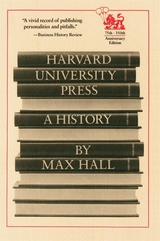 Harvard University Press: A History
Max Hall
Harvard University Press, 1986 A university press is a curious institution, dedicated to the dissemination of learning yet apart from the academic structure; a publishing firm that is in business, but not to make money; an arm of the university that is frequently misunderstood and occasionally attacked by faculty and administration. Max Hall here chronicles the early stages and first sixty years of Harvard University Press in a rich and entertaining book that is at once Harvard history, publishing history, printing history, business history, and intellectual history.
The tale begins in 1638 when the first printing press arrived in British North America. It became the property of Harvard College and remained so for nearly half a century. Hall sketches the various forerunners of the “real” Harvard University Press, founded in 1913, and then follows the ups and downs of its first six decades, during which the Press published steadily if not always serenely a total of 4,500 books. He describes the directors and others who left their stamp on the Press or guided its fortunes during these years. And he gives the stories behind such enduring works as Lovejoy’s Great Chain of Being, Giedion’s Space, Time and Architecture, Langer’s Philosophy in a New Key, and Kelly’s Eleanor of Aquitaine and the Four Kings.
 The Harvard–MIT Division of Health Sciences and Technology: The First 25 Years, 1970–1995
Walter H. Abelmann
Harvard University Press, 2004 Since 1970 a medical sciences curriculum has been taught jointly by Harvard Medical School and the Massachusetts Institute of Technology. In 1978, a doctoral program was founded to prepare physical scientists and engineers to address research at the interface of technology and clinical medicine. This volume describes, analyzes, and evaluates those first 25 years of the largest lasting collaborative educational and research program between two neighboring research universities.
Containing introductory comments by the presidents of both institutions at the time of the inauguration of the program, this volume presents historiographic and autobiographical chapters by senior officials and faculty of both universities who helped to guide it through its first quarter century. Evaluation of the program and follow-up data on the first graduates are included as well. Courses are listed in the appendices, as are curricula, faculty, theses topics, and major research projects.
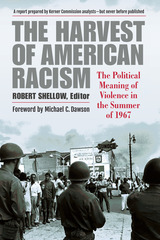 The Harvest of American Racism: The Political Meaning of Violence in the Summer of 1967
Robert Shellow
University of Michigan Press, 2018 In the summer of 1967, in response to violent demonstrations that rocked 164 U.S. cities, the National Advisory Commission on Civil Disorders, a.k.a. the Kerner Commission, was formed. The Commission sought reasons for the disturbances, including the role that law enforcement played. Chief among its research projects was a study of 23 American cities, headed by social psychologist Robert Shellow. An early draft of the scientists’ analysis, titled “The Harvest of American Racism: The Political Meaning of Violence in the Summer of 1967,” provoked the Commission’s staff in November 1967 by uncovering political causes for the unrest; the team of researchers was fired, and the controversial report remained buried at the LBJ Presidential Library until now.
The first publication of the Harvest report half a century later reveals that many of the issues it describes are still with us, including how cities might more effectively and humanely react to groups and communities in protest. In addition to the complete text of the suppressed Harvest report, the book includes an introduction by Robert Shellow that provides useful historical context; personal recollections from four of the report’s surviving social scientists, Robert Shellow, David Boesel, Gary T. Marx, and David O. Sears; and an appendix outlining the differences between the unpublished Harvest analysis and the well-known Kerner Commission Report that followed it.
“The [Harvest of American Racism] report was rejected by Johnson administration functionaries as being far too radical—politically ‘unviable’… Social science can play an extremely positive role in fighting racial and other injustice and inequality, but only if it is matched with a powerful political will to implement the findings. That will has never come from within an American presidential administration—that will has only been forged in black and other radical communities’ movements for justice. The political power for change, as incremental as it has been, has come from within those communities. Washington responds, it does not lead."
—from the Foreword by Michael C. Dawson
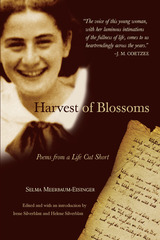 Harvest of Blossoms: Poems from a Life Cut Short
Selma Meerbaum-Eisinger
Northwestern University Press, 2008 A rediscovered poetry collection from a lost voice of the Holocaust Revealing an artist of remarkable talent and enduring hope, this collection of poetry will join Anne Frank's diary as a touching reminder of what the world has lost by a life cut short. The poems written by Selma Meerbaum-Eisinger are astonishing for their beauty; it is equally astonishing that they have survived at all. Selma Meerbaum-Eisinger was born in Czernowitz, Romania, now Chernivtsi, Ukraine. Czernowitz, known for its vibrant mix of languages and ethnicities, was famously described by Selma's cousin, poet Paul Celan, as a city "where human beings and books used to live." Her childhood friends speak of Selma's liveliness and irreverence, her sparkling and mischievous personality, her charming, careless appearance, and her independence. Selma was passionate about ideas, literature, music, and art. As the storm of hatred gripping Europe broke in earnest, Selma expressed her desires and fears in poetry. Between the ages of fifteen and seventeen, Selma wrote fifty-two poems and five translations—two from French, two from Yiddish, one from Romanian—that are published here. Selma's verse addressed the longings of a young woman in love; in equal measure, it confronted the incomprehensible violence engulfing Europe. Selma found beauty in the fragility of chestnuts, comfort in the loneliness of rain, grief in rural poverty, and, with despairing courage, faced a diminishing and terrifying future. Selma grew up during a time of rising anti-Semitic and nationalist sentiments. When the Germans and their Romanian allies entered Czernowitz in 1941, Jews faced the brutality associated with fascism: a cruelty that would have preferred that she--and her entire history and culture--be erased. After being quarantined to a ghetto in October, 1941, Jewish Romanians were deported to work camps by Romanian officials. In July of 1942, Selma and her family were sent to Michailowka, a labor camp in Ukraine, where they worked as slaves in unspeakable conditions. Remarkably, some records of Selma's experience have survived; because of them, we know that even in the camp Selma held the beauty of language in her heart along with an aching desire to return to her home. Selma's last piece of writing, a letter to her dear friend, Renee Abramvici-Michaeli, is a record of Selma's abiding courage and her bleak hope that a better world would follow. Selma died of typhus on December 16, 1942, her death reported in the diary of an artist who was with Selma in the labor camp. She was only eighteen. Selma left behind a powerful trace of her life and world in this poetry album. The album's survival is a story in itself. Selma gave the album to Renee to give to Selma's friend Leiser Fichman. Leiser passed the album on to Abramovici-Michaeli before he died when his boat to Palestine was torpedoed and sank. Renee Abramovici-Michaeli traveled to Israel across rivers, mountains, and political borders, losing every piece of luggage except for the backpack that held Selma's album. The album then remained with Renee for thirty years, until Czernowitzers in Israel and family abroad financed a private publication. Selma's work first reached a broader audience, however, after Paul Celan insisted that Selma's "Poem" be printed next to his piece in a 1968 German anthology. An interested journalist, after traveling to Israel to see if he could find out more, brought the poems back to Germany, where the first edition was published in 1980. Now, in this first English translation, Selma's life and her magnificent album can reach out to a new audience that seeks a fuller picture of what was lost. A rich introduction explains the historical context and the story of Selma's life. That these poems exist is stunning enough; that they are as touching and universal as they are is a revelation.
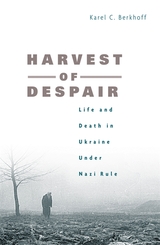 Harvest of Despair: Life and Death in Ukraine under Nazi Rule
Karel C. Berkhoff
Harvard University Press, 2008 “If I find a Ukrainian who is worthy of sitting at the same table with me, I must have him shot,” declared Nazi commissar Erich Koch. To the Nazi leaders, the Ukrainians were Untermenschen—subhumans. But the rich land was deemed prime territory for Lebensraum expansion. Once the Germans rid the country of Jews, Roma, and Bolsheviks, the Ukrainians would be used to harvest the land for the master race.
Karel Berkhoff provides a searing portrait of life in the Third Reich’s largest colony. Under the Nazis, a blend of German nationalism, anti-Semitism, and racist notions about the Slavs produced a reign of terror and genocide. But it is impossible to understand fully Ukraine’s response to this assault without addressing the impact of decades of repressive Soviet rule. Berkhoff shows how a pervasive Soviet mentality worked against solidarity, which helps explain why the vast majority of the population did not resist the Germans. He also challenges standard views of wartime eastern Europe by treating in a more nuanced way issues of collaboration and local anti-Semitism.
Berkhoff offers a multifaceted discussion that includes the brutal nature of the Nazi administration; the genocide of the Jews and Roma; the deliberate starving of Kiev; mass deportations within and beyond Ukraine; the role of ethnic Germans; religion and national culture; partisans and the German response; and the desperate struggle to stay alive. Harvest of Despair is a gripping depiction of ordinary people trying to survive extraordinary events.
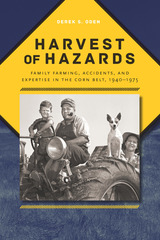 Harvest of Hazards: Family Farming, Accidents, and Expertise in the Corn Belt, 1940-1975
Derek S. Oden
University of Iowa Press, 2017 Farming has always been a dangerous occupation. In the middle of the twentieth century, as farmers adopted a wide array of new technologies, from tractors to pesticides and fertilizers, the dangers became more acute. The economic pressures that agriculture faced in this period compounded the perils of these powerful new tools, as farmers struggled to stay profitable in the face of widespread consolidation.
In this study of the farm safety movement in the Corn Belt, historian Derek Oden examines why agriculture was so dangerous and why improvements were so difficult to achieve. Because farmers were self-employed business owners whose employees were mainly family members; because they lived far from aid such as hospitals and fire stations; and because they had to manage such a diverse array of new technologies, they could not easily adopt the workplace safety and public health reforms designed for factories and urban settings. In response, beginning in the 1940s, farmers and a new breed of farm safety specialists relied upon an increasingly elaborate educational campaign to lessen injuries and illnesses on the farm.
Several government, business, and nonprofit organizations—from the US Department of Agriculture to the National Safety Council and 4-H and the Future Farmers of America—worked together to publicize both the dangers of farming and the information farmers needed to stay safe while driving tractors, applying anhydrous ammonia, or repairing machinery. By the 1960s, however, the partnership began to break down, and by the 1970s the safety movement became increasingly contested as professional and policy divisions emerged. This groundbreaking study incorporates agriculture into the histories of occupational safety and public health.
 Harvest of the Palm: Ecological Change in Eastern Indonesia
James J. Fox
Harvard University Press, 1977 Paradoxically, at a time when hunting and gathering societies are almost a thing of the past, a subsistence system based on gathering is not only persisting but actually gaining ground in southeastern Indonesia. The economy of the small islands of Roti and Savu is centered on the intensive use of the lontar palm tree, whose juice is the staple of the people's diet and whose leaves, leafstalks, and trunks provide the wherewithal for their housing and most of their needs.
This economy, marvelously stable and adaptive, is described in detail by James Fox, and is contrasted with that of the large neighboring islands, Timor and Sumba; there slash-and-burn agriculture has led to steady ecological deterioration, in the wake of which the lontar economy of the smaller islands has gained a foothold and is gradually expanding. How these developments came about is revealed by an examination of the history of the islands over several hundred years and the effects of the policies of successive colonial governments. The historical perspective adds depth to the ethnographic presentation and is vital to the anthropological analysis of social change.
In preparation for the writing of this book the author spent three years in the Timor area, especially on Roti; learned Dutch, Indonesian, and several local island dialects; and had done intensive historical research in Indonesia and in archives in the Netherlands.
A Harvest Truce: A Play
Serhiy Zhadan
Harvard University Press, 2024 Brothers Anton and Tolik reunite at their family home to bury their recently deceased mother. An otherwise natural ritual unfolds under extraordinary circumstances: their house is on the front line of a war ignited by Russian-backed separatists in eastern Ukraine. Isolated without power or running water, the brothers’ best hope for success and survival lies in the declared cease fire—the harvest truce. But such hopes are swiftly dashed, as it becomes apparent that the conflagration of war will not abate.
With echoes of Waiting for Godot, Serhiy Zhadan’s A Harvest Truce stages a tragicomedy in which the commonplace experiences of death, birth, and the cycles of life marked by the practices of growing and harvesting food are rendered futile and farcical in the wake of the indifferent juggernaut of war.
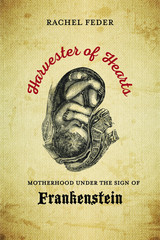 Harvester of Hearts: Motherhood under the Sign of Frankenstein
Rachel Feder
Northwestern University Press, 2018 In the period between 1815 and 1820, Mary Shelley wrote her most famous novel, Frankenstein; or, The Modern Prometheus, as well as its companion piece, Mathilda, a tragic incest narrative that was confiscated by her father, William Godwin, and left unpublished until 1959. She also gave birth to four—and lost three—children. In this hybrid text, Rachel Feder interprets Frankenstein and Mathilda within a series of provocative frameworks including Shelley’s experiences of motherhood and maternal loss, twentieth-century feminists’ interests in and attachments to Mary Shelley, and the critic’s own experiences of pregnancy, childbirth, and motherhood. Harvester of Hearts explores how Mary Shelley’s exchanges with her children—in utero, in birth, in life, and in death—infuse her literary creations. Drawing on the archives of feminist scholarship, Feder theorizes “elective affinities,” a term she borrows from Goethe to interrogate how the personal attachments of literary critics shape our sense of literary history. Feder blurs the distinctions between intellectual, bodily, literary, and personal history, reanimating the classical feminist discourse on Frankenstein by stepping into the frame. The result—at once an experimental book of literary criticism, a performative foray into feminist praxis, and a deeply personal lyric essay—not only locates Mary Shelley’s monsters within the folds of maternal identity but also illuminates the connections between the literary and the quotidian.
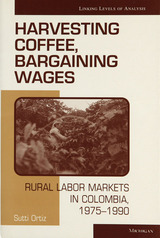 Harvesting Coffee, Bargaining Wages: Rural Labor Markets in Colombia, 1975-1990
Sutti Ortiz
University of Michigan Press, 1999 Harvesting Coffee, Bargaining Wages offers an insightful scrutiny of rural market behavior and a convincing explanation of why farmers fail sometimes to manage their laborers in ways predicted by market models--and how power imbalances and social conditions can impair the ability of laborers to attain a fair market contract during lax labor market periods. This empirical study, based on interviews with both farmers and laborers, covers a fifteen-year period characterized by the modernization of production. Ortiz compares three localized coffee labor markets, expanding the analysis by contrasting the strategies used by the coffee farmers in her study areas with those that farmers in other parts of the world adopt in order to cope with similar problems. Her data challenge prevalent generalizations about the consequences of agricultural modernization on laboring families by showing that management practices and contractual arrangements are ultimately molded by local conditions--cultural perceptions of a fair exchange, familial obligations and roles, availability of housing, bargaining power in the home and in the market, kin networks, and information flows--in interaction with national and global influences. Harvesting Coffee, Bargaining Wages will be of primary interest to anthropologists and sociologists, geographers, political scientists interested in explicit and implicit contract formats, and economists intrigued by the possibility of integrating social variables as contextual aspects of management strategies. Sutti Ortiz is Associate Professor Emerita of Anthropology, Boston University.
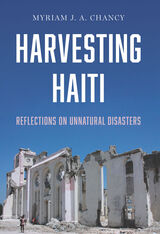 Harvesting Haiti: Reflections on Unnatural Disasters
Myriam J.A. Chancy
University of Texas Press, 2023 2024 Isis Duarte Book Prize, Haiti/ Dominican Republic Section, Latin American Studies Association
2024 Longlist, OCM Bocas Prize for Caribbean Literature, Bocas Lit Fest This collection ponders the personal and political implications for Haitians at home and abroad resulting from the devastating 2010 earthquake.
The 7.0 magnitude earthquake that struck Haiti in January 2010 was a debilitating event that followed decades of political, social, and financial issues. Leaving over 250,000 people dead, 300,000 injured, and 1.5 million people homeless, the earthquake has had lasting repercussions on a struggling nation. As the post-earthquake political situation unfolded, Myriam Chancy worked to illuminate on-the-ground concerns, from the vulnerable position of Haitian women to the failures of international aid. Originally presented at invited campus talks, published as columns for a newspaper in Trinidad and Tobago, and circulated in other ways, her essays and creative responses preserve the reactions and urgencies of the years following the disaster. In Harvesting Haiti, Chancy examines the structures that have resulted in Haiti's post-earthquake conditions and reflects at key points after the earthquake on its effects on vulnerable communities. Her essays make clear the importance of sustaining and supporting the dignity of Haitian lives and of creating a better, contextualized understanding of the issues that mark Haitians’ historical and present realities, from gender parity to the vexed relationship between Haiti and the Dominican Republic.
 Harvestmen: The Biology of Opiliones
Ricardo Pinto-da-Rocha
Harvard University Press, 2007 This is the first comprehensive treatment of a major order of arachnids featuring more than 6,000 species worldwide, familiar in North America as daddy-longlegs but known scientifically as the Opiliones, or harvestmen. The 25 authors provide a much-needed synthesis of what is currently known about these relatives of spiders, focusing on basic conceptual issues in systematics and evolutionary ecology, making comparisons with other well-studied arachnid groups, such as spiders and scorpions.
Broad in scope, the volume is aimed at raising relevant questions from a diversity of fields, indicating areas in which additional research is needed. The authors focus on both the unique attributes of harvestmen biology, as well as on biological studies conducted with harvestmen species that contribute to the understanding of behavior and evolutionary biology in general. By providing a broad taxonomic and ecological background for understanding this major arachnid group, the book should give field biologists worldwide the means to identify specimens and provide an invaluable reference for understanding harvestmen diversity and biology.
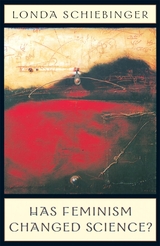 Has Feminism Changed Science?
Londa Schiebinger
Harvard University Press, 2001 Do women do science differently? And how about feminists--male or female? The answer to this fraught question, carefully set out in this provocative book, will startle and enlighten every faction in the "science wars."
Has Feminism Changed Science? is at once a history of women in science and a frank assessment of the role of gender in shaping scientific knowledge. Science is both a profession and a body of knowledge, and Londa Schiebinger looks at how women have fared and performed in both instances. She first considers the lives of women scientists, past and present: How many are there? What sciences do they choose--or have chosen for them? Is the professional culture of science gendered? And is there something uniquely feminine about the science women do? Schiebinger debunks the myth that women scientists--because they are women--are somehow more holistic and integrative and create more cooperative scientific communities. At the same time, she details the considerable practical difficulties that beset women in science, where domestic partnerships, children, and other demanding concerns can put women's (and increasingly men's) careers at risk.
But what about the content of science, the heart of Schiebinger's subject? Have feminist perspectives brought any positive changes to scientific knowledge? Schiebinger provides a subtle and nuanced gender analysis of the physical sciences, medicine, archaeology, evolutionary biology, primatology, and developmental biology. She also shows that feminist scientists have developed new theories, asked new questions, and opened new fields in many of these areas.
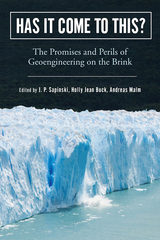 Has It Come to This?: The Promises and Perils of Geoengineering on the Brink
J.P. Sapinski
Rutgers University Press, 2021 Geoengineering is the deliberate and large-scale intervention in the Earth's climate system in an attempt to mitigate the adverse effects of global warming. Now that climate emergency is upon us, claims that geoengineering is inevitable are rapidly proliferating. How did we get into this situation where the most extreme path now seems a plausible development? Is it an accurate representation of where we are at? Who is this “we” who is talking? What options make it onto the table? Which are left out? Whom does geoengineering serve? Why is the ensemble of projects that goes by that name so salient, even though the community of researchers and advocates is remarkably small? These are some of the questions that the thinkers contributing to this volume are exploring from perspectives ranging from sociology and geography to ethics and Indigenous studies. The editors set out this diverse collection of voices not as a monolithic, unified take on geoengineering, but as a place where creative thinkers, students, and interested environmental and social justice advocates can explore nuanced ideas in more than 240 characters.
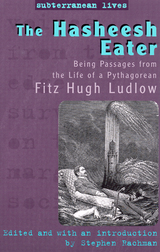 The Hasheesh Eater: Being Passages from the Life of a Pythagorean
Rachman, Stephen
Rutgers University Press, 2006 Fitz-Hugh Ludlow was a recent graduate of Union College in Schenectady, New York, when he vividly recorded his hasheesh-induced visions, experiences, adventures, and insights. During the mid-nineteenth century, the drug was a legal remedy for lockjaw and Ludlow had a friend at school from whom he received a ready supply. He consumed such large quantities at each sitting that his hallucinations have been likened to those experienced by opium addicts. Throughout the book, Ludlow colorfully describes his psychedelic journey that led to extended reflections on religion, philosophy, medicine, and culture. First published in 1857, The Hasheesh Eater was the first full-length American example of drug literature. Yet despite the scandal that surrounded it, the book quickly became a huge success. Since then, it has become a cult classic, first among Beat writers in the 1950s and 1960s, and later with San Francisco Bay area hippies in the 1970s.
In this first scholarly edition, editor Stephen Rachman positions Ludlow's enduring work as not just a chronicle of drug use but also as a window into the budding American bohemian literary scene. A lucid introduction explores the breadth of Ludlow's classical learning as well as his involvement with the nineteenth-century subculture that included fellow revelers such as Walt Whitman and the pianist Louis Gottshalk. With helpful annotations guiding readers through the text's richly allusive qualities and abundance of references, this edition is ideal for classroom use as well as for general readers.
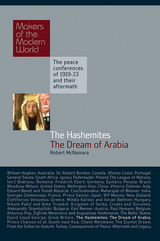 The Hashemites: The Dream of Arabia
Robert McNamara
Haus Publishing, 2010 The story of the Arab Revolt and the Hashemite princes who led it during the First World War is inextricably linked in modern eyes to the legend of Lawrence of Arabia as portrayed in David Lean's 1962 film. But behind this romantic image lies a harsher reality of wartime expediency, double-dealing and dynastic ambition, which shaped the modern Middle East and laid the foundations of many of the conflicts that rack the region to this day. Arab nationalists claim that British instigation for the Arab Revolt against the Ottoman Empire was a commitment to independence for the Arab people, but in this book Robert McNamara shows how the British cultivated the Hashemite Sherifs of Mecca more as an alternative focus during the First World War for Muslim loyalty from the Ottoman Sultan, who as Caliph had declared a jihad against the Allies when the Turks joined the Central Powers, than a leader of an independent and united Arabia. At the same time, the Sykes-Picot Agreement divided up the Middle East between British and French spheres of influence. The sense of betrayal that this caused has coloured Arab nationalists' views of the West ever since. The main countries of the Middle East —Jordan, Syria and Iraq—are all the creations of the post-First World War settlement worked out at the Paris Peace Conference. The story of the Hashemite dynasty at the Paris Peace Conference is the story of the birth of the modern history of a region that is now more than ever at the centre of world affairs.
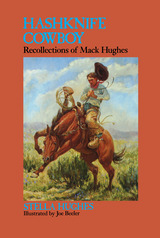 Hashknife Cowboy: Recollections of Mack Hughes
Stella Hughes; Illustrated by Joe Beeler
University of Arizona Press, 1984 "Age and size ain't got nothin' to do with it," Mack's daddy once said. "You gotta want to be a cowboy." Mack Hughes wanted to be a cowboy, all right, and he was just twelve years old when he went to work for the famous Hashknife spread in northern Arizona. Growing up on the range, Mack lived a life about which modern boys can only wonder. He spins yarns of bad horses and the men who rode them, tells of wild dogs that ravaged young calves, and recalls lonely winter weeks spent at a remote camp-where his home was a shack so flimsy that snow blew through the cracks and covered his bed. Stella Hughes, author of the best-selling Chuck Wagon Cookin' and a cowhand in her own right, has compiled from her husband's reminiscences an authentic look both at Arizona history and at cowboying as it really was. Illustrated by Joe Beeler, founding member of the Cowboy Artists of America.
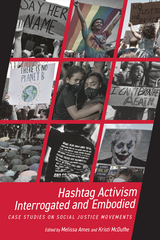 Hashtag Activism Interrogated and Embodied: Case Studies on Social Justice Movements
edited by Melissa Ames & Kristi McDuffie
Utah State University Press, 2022 Hashtag Activism Interrogated and Embodied analyzes the ways that hashtags repurpose and reclaim societal narratives, considering how these digital interactions carry over into external spaces and are embodied by both participants and spectators alike. A diverse set of contributors from a range of disciplines utilize a variety of methodologies to interrogate the lifespan and trajectories of specific hashtag campaigns, study rhetorical strategies engaged by online communities, and analyze how hashtags are employed for particular purposes. The chapters capture twenty-first-century digital activism unfolding in different social and geopolitical climates. Delving into hashtag activism in various forms (tweets, memes, and personal narratives) and spaces (Twitter, Facebook, and in-person protests), these chapters reveal how participants question and construct online and offline identities and imagined and actualized communities. They also showcase the complicated ways hashtag activism intersects with consumer, popular, and celebrity cultures. Hashtag Activism Interrogated and Embodied calls for broader inclusion in what is considered hashtag activism, such as digital fandom, how hashtags are co-opted for nefarious purposes, the effects of anti-activism, and the role of journalism and the media. It will appeal to a range of disciplines including rhetoric and composition, internet studies, communication studies, media studies, feminist studies, affect studies, cultural studies, technical communication, and sociology. Contributors: Robert Barry, André Brock, Elizabeth Buchanan, Rosemary Clark-Parsons, Gabriel I. Green, Neha Gupta, Jeffrey J. Hall, Kyesha Jennings, Morgan K. Johnson, Salma Kalim, Megan McIntyre, Sean Milligan, Avishek Ray, Sarah Riddick, Stephanie Vie, Erin B. Waggoner, Holly M. Wells, William I. Wolff You can use only one pair of em dashes in a sentence. :(
Hasidic People: A Place in the New World
Jerome Mintz
Harvard University Press, 1992 In this engrossing social history of the New York Hasidic community based on extensive interviews, observation, newspaper files, and court records, Jerome Mintz combines historical study with tenacious investigation to provide a vivid account of social and religious dynamics. Hasidic People takes the reader from the various neighborhood settlements through years of growth to today’s tragic incidents and conflicts. In an engaging style, rich with personal insight, Mintz invites us into this old world within the new, a way of life at once foreign and yet intrinsic to the American experience.
Hasidism: Continuity or Innovation?
Bezalel Safran
Harvard University Press, 1988 This volume is a major reassessment of scholarly commonplaces about the origins and nature of early Hasidism, the mystical movement which engulfed east European Jewry in the latter half of the eighteenth century. Through the use of divergent methodologies—historical reconstruction, literary analysis, philological examination—four distinguished scholars contribute new research to what has been a most popular concern of Jewish historical study. Shmuel Etinger, Emanuel Etkes, Jacob Hisdai, and Bezalel Safran explore such provocative questions as: Was there indeed a Sabbatian influence on Hasidism? How real was the opposition of the Mitnagdim? How original were Hasidic ideas?
Hasidism on the Margin: Reconciliation, Antinomianism, and Messianism
Shaul Magid
University of Wisconsin Press, 2003 Hasidism on the Margin explores one of the most provocative and radical traditions of Hasidic thought, the school of Izbica and Radzin that Rabbi Gershon Henokh originated in nineteenth-century Poland. Shaul Magid traces the intellectual history of this strand of Judaism from medieval Jewish philosophy through centuries of Kabbalistic texts to the nineteenth century and into the present. He contextualizes the Hasidism of Izbica-Radzin in the larger philosophy and history of religions and provides a model for inquiry into other forms of Hasidism.
 Hasidism: Writings on Devotion, Community, and Life in the Modern World
Edited by Ariel Evan Mayse Editor and Sam Berrin Shonkoff
Brandeis University Press, 2020 Hasidism has attracted, repelled, and bewildered philosophers, historians, and theologians since its inception in the eighteenth century. In Hasidism: Writings on Devotion, Community, and Life in the Modern World, Ariel Evan Mayse and Sam Berrin Shonkoff present students and scholars with a vibrant and polyphonic set of Hasidic confrontations with the modern world. In this collection, they show that the modern Hasid marks not only another example of a Jewish pietist, but someone who is committed to an ethos of seeking wisdom, joy, and intimacy with the divine.
While this volume focuses on Hasidism, it wrestles with a core set of questions that permeate modern Jewish thought and religious thought more generally: What is the relationship between God and the world? What is the relationship between God and the human being? But Hasidic thought is cast with mystical, psychological, and even magical accents, and offers radically different answers to core issues of modern concern. The editors draw selections from an array of genres including women’s supplications; sermons and homilies; personal diaries and memoirs; correspondence; stories; polemics; legal codes; and rabbinic response. These selections consciously move between everyday lived experience and the most ineffable mystical secrets, reflecting the multidimensional nature of this unusual religious and social movement. The editors include canonical texts from the first generation of Hasidic leaders up through present-day ultra-orthodox, as well as neo-Hasidic voices and, in so doing, demonstrate the unfolding of a rich and complex phenomenon that continues to evolve today.
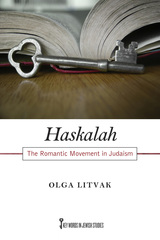 Haskalah: The Romantic Movement in Judaism
Litvak, Olga
Rutgers University Press, 2012 Commonly translated as the “Jewish Enlightenment,” the Haskalah propelled Jews into modern life. Olga Litvak argues that the idea of a Jewish modernity, championed by adherents of this movement, did not originate in Western Europe’s age of reason. Litvak contends that the Haskalah spearheaded a Jewish religious revival, better understood against the background of Eastern European Romanticism. Based on imaginative and historically grounded readings of primary sources, Litvak presents a compelling case for rethinking the relationship between the Haskalah and the experience of political and social emancipation. Most importantly, she challenges the prevailing view that the Haskalah provided the philosophical mainspring for Jewish liberalism. In Litvak’s ambitious interpretation, nineteenth-century Eastern European intellectuals emerge as the authors of a Jewish Romantic revolution. Fueled by contradictory longings both for community and for personal freedom, the poets and scholars associated with the Haskalah questioned the moral costs of civic equality and the achievement of middle-class status. In the nineteenth century, their conservative approach to culture as the cure for the spiritual ills of the modern individual provided a powerful argument for the development of Jewish nationalism. Today, their ideas are equally resonant in contemporary debates about the ramifications of secularization for the future of Judaism.
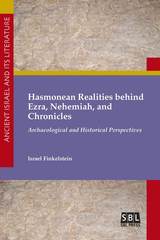 Hasmonean Realities behind Ezra, Nehemiah, and Chronicles: Archaeological and Historical Perspectives
Israel Finkelstein
SBL Press, 2018 A thorough case for a later date for of Ezra, Nehemiah, and Chronicles
In this collection of essays, Israel Finkelstein deals with key topics in Ezra, Nehemiah, and 1 and 2 Chronicles, such as the list of returnees, the construction of the city wall of Jerusalem, the adversaries of Nehemiah, the tribal genealogies, and the territorial expansion of Judah in 2 Chronicles. Finkelstein argues that the geographical and historical realities cached behind at least parts of these books fit the Hasmonean period in the late second century BCE. Seven previously published essays are supplemented by maps, updates to the archaeological material, and references to recent publications on the topics.
Features: -
Analysis of geographical chapters of Ezra, Nehemiah, and Chronicles
- Study of the Hasmonean period in the late second century BCE
- Unique arguments regarding chronology and historical background
Haste
Lisa Bickmore
Signature Books, 2023 From a life of meditation and memory, legend and language, Lisa Bickmore probes in poems intimate yet inclusive the dark spaces of experience where figures align, collapse, and realign.
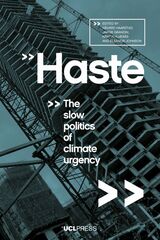 Haste: The Slow Politics of Climate Urgency
Edited by Håvard Haarstad, Jakob Grandin, Kristin Kjærås, and Eleanor Johnson
University College London, 2023 A powerful argument for not approaching climate change in a hurry, but with a slow politics of urgency.
It’s understandable that we tend to present climate change as something urgently requiring action. Every day we fail to act, the potential for catastrophe grows. But is that framing itself a problem? When we hurry, we make more mistakes. We overlook things. We get tunnel vision.
In Haste, a group of distinguished contributors makes the case for a slow politics of urgency. Rather than rushing and speeding up, he argues, the sustainable future is better served by our challenging of the dominant framings through which we understand time and change in society. While recognizing the need for certain types of urgency in climate politics, Haste directs attention to the different and alternative temporalities at play in climate and sustainability politics. Divided into short and accessible chapters, written by both established and emerging scholars from different disciplines, Haste tackles a major problem in contemporary climate change research and offers creative perspectives on pathways out of the climate emergency.
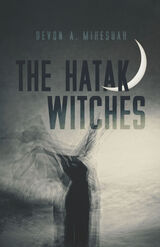 The Hatak Witches
Devon A. Mihesuah
University of Arizona Press, 2021 After a security guard is found dead and another wounded at the Children’s Museum of Science and History in Norman, Oklahoma, Detective Monique Blue Hawk and her partner Chris Pierson are summoned to investigate. They find no fingerprints, no footprints, and no obvious means to enter the locked building.
Monique discovers that a portion of an ancient and deformed skeleton had also been stolen from the neglected museum archives. Her uncle, the spiritual leader Leroy Bear Red Ears, concludes that the stolen remains are those of Hatak haksi, a witch and the matriarch of the Crow family, a group of shape-shifting Choctaws who plan to reestablish themselves as the powerful creatures they were when the tribe lived in Mississippi. Monique, Leroy, and Chris must stop the Crows, but to their dread, the entities have retreated to the dark and treacherous hollow in the center of Chalakwa Ranch. The murderous shape-shifters believe the enormous wild hogs, poisonous snakes, and other creatures of the hollow might form an adequate defense for Hatak haksi.
But what no one counts on is the unexpected appearance and power of the Old Ones who guard the lands of the Choctaw afterlife. Blending tribal beliefs and myths into a modern context, The Hatak Witches continues the storyline of Choctaw cosmology and cultural survival that are prominent in Devon A. Mihesuah’s award-winning novel, The Roads of My Relations.
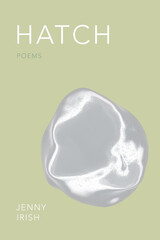 Hatch: Poems
Jenny Irish
Northwestern University Press, 2024 Groundbreaking feminist poems featuring an artificial womb and an apocalyptic future
The prose poems in Jenny Irish’s newest collection, Hatch, trace the consciousness of an artificial womb that must confront the role she has played in the continuation of the dying of the human species. This apocalyptic vision engages with the most pressing concerns of this contemporary sociopolitical moment: reproductive rights, climate crises, and mass extinction; gender and racial bias in healthcare and technology; disinformation, conspiracy theories, and pseudoscience; and the possibilities and dangers of artificial intelligence. More intimately, Hatch considers questions about how motherhood and its cultural expectations shape female identity. Working with avant strategies, Irish crafts a speculative feminist narrative, excavating and reexamining the aspects of the American experience that should have served as a call to action but have not. Part elegy and part prophecy, Hatch warns of a possible future while speaking to the present moment.
The Hatchet's Blood: Separation, Power, and Gender in Ehing Social Life
Marc R. Schloss
University of Arizona Press, 1988 Winner of the Royal Anthropological Institute’s Amaury Talbot Prize for African Anthropology
The ritual complexes of the Ehing, a farming people of southern Senegal, embody an elaborate set of prohibitions on social behavior and prescribe the general rules of Ehing social organization. Power is distributed and maintained in Ehing culture by the concept of Odieng (“hatchet”), which as a spirit acts upon human beings much as an ax does upon a tree, falling from above to punish its victims for transgression. Marc R. Schloss’s ethnography of the Ehing is a study of the meaning of Odieng’s power, explaining why its rules are so essential to the Ehing way of life.
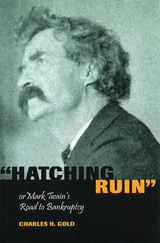 Hatching Ruin: Or Mark Twain's Road to Bankruptcy
Charles H. Gold
University of Missouri Press, 2003 In “Hatching Ruin,” Charles H. Gold provides a complete description of Samuel L. Clemens’s business relationships with Charles L. Webster and James W. Paige during the 1880s. Gold analyzes how these relationships affected Clemens as a person and an artist, most notably in A Connecticut Yankee in King Arthur’s Court. The 1880s were a time when Samuel Clemens was more businessman than author. Clemens wanted to be rich. From an early age, he had dreamed of wealth. Suspicious of his previous publisher, Clemens started a publishing company and placed Charles L. Webster, who was married to his niece, at the head of it. He also invested large sums of money with James Paige, who was developing a typesetting machine. These were to be Clemens’s instruments of success—his way to bring technology to the world and become so rich that he would never need to earn money again.
Unfortunately for him, Paige was a perfectionist and a compulsive tinkerer who never stopped working on the typesetting machine. When, after early success, the publishing company began to fail, Clemens was unable to continue his investments in the typesetter. He blamed both Webster and Paige for his failure to “get rich quick” and for his eventual bankruptcy in 1894. Gold argues that these financial changes in his life helped to shape Connecticut Yankee, an important novel and cultural statement.
At the beginning of the 1880s, while life was still good, Clemens wrote Adventures of Huckleberry Finn, in part a nostalgic look at youth and innocence in preindustrial America. A Connecticut Yankee in King Arthur’s Court, written after the author’s financial failures, is a savage condemnation of the Gilded Age, especially technology’s role in it. Gold’s “Hatching Ruin” tells for the first time the full story of Clemens’s experiences as an investor, employer, and entrepreneur during the Gilded Age.
Gold uses previously unpublished material from family correspondence and Clemens’s autobiographical dictations to present a far more complex picture of the man most people know only as Mark Twain. He also offers a fuller depiction of Charles Webster and his relationship with Clemens than was previously available, while answering many questions that have hung over that relationship. This book will have a wide appeal to both Twain students and scholars, as well as anyone interested in social history.
Hate Crime: The Global Politics of Polarization
Edited by Robert J. Kelly and Jess Maghan
Southern Illinois University Press, 1998
These twelve previously unpublished essays explore the international phenomenon of hate crime, examining the socio-psychological dynamics of these crimes and the settings in which they occur, the relationships between offenders and their victims, the emotional states of the participants, and the legal and law enforcement responses to these crimes.
The essays address religious, racial, ethnic, and sexual crimes in the United States, Latin America, Africa, Europe, and the Middle East. The essayists provide historical reviews of the problems and the ways local authorities understand and cope with the dilemmas as well as prognoses about the persistence of hate crime and the measures that can be taken to control and contain it.
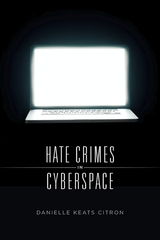 Hate Crimes in Cyberspace
Danielle Keats Citron
Harvard University Press, 2014 Most Internet users are familiar with trolling—aggressive, foul-mouthed posts designed to elicit angry responses in a site’s comments. Less familiar but far more serious is the way some use networked technologies to target real people, subjecting them, by name and address, to vicious, often terrifying, online abuse. In an in-depth investigation of a problem that is too often trivialized by lawmakers and the media, Danielle Keats Citron exposes the startling extent of personal cyber-attacks and proposes practical, lawful ways to prevent and punish online harassment. A refutation of those who claim that these attacks are legal, or at least impossible to stop, Hate Crimes in Cyberspace reveals the serious emotional, professional, and financial harms incurred by victims.
Persistent online attacks disproportionately target women and frequently include detailed fantasies of rape as well as reputation-ruining lies and sexually explicit photographs. And if dealing with a single attacker’s “revenge porn” were not enough, harassing posts that make their way onto social media sites often feed on one another, turning lone instigators into cyber-mobs.
Hate Crimes in Cyberspace rejects the view of the Internet as an anarchic Wild West, where those who venture online must be thick-skinned enough to endure all manner of verbal assault in the name of free speech protection, no matter how distasteful or abusive. Cyber-harassment is a matter of civil rights law, Citron contends, and legal precedents as well as social norms of decency and civility must be leveraged to stop it.
 Hate the Game: Economic Cheat Codes for Life, Love, and Work
Daryl Fairweather
University of Chicago Press, 2025 The secret insights of economics, translated for the rest of us.
Should I buy or rent? Do I ask for a promotion? Should I tell people I’m pregnant? What salary do I deserve? Should I just quit this job? Common anxieties about life are often grounded in economics. In an increasingly win-lose society, these economic decisions—where to work, where to live, even how to live—have a way of feeling fixed and mistakes terminal.
Daryl Fairweather is no stranger to these dynamics. As the first Black woman to receive an economics PhD from the famed University of Chicago, she saw firsthand how concepts of behavioral economics and game theory were deployed in the real world—and in her own life—to great effect. Hate the Game combines Fairweather’s elite knowledge of these principles with her singular voice in describing how they can be harnessed. Her great talent, unique among economists, is her ability to articulate economic trends in a way that is not just informative, but also accounts for life’s other anxieties.
In Hate the Game, Fairweather fixes her expertise and service on navigating the earliest economic inflection points of adult life: whether to go to college and for how long; partnering, having kids, both, or neither; getting, keeping, and changing jobs; and where to live and how to pay for it. She speaks in actionable terms about what the economy means for individual people, especially those who have the sneaking suspicion they’re losing out. Set against her own experiences and enriched with lessons from history, science, and pop culture, Fairweather instructs readers on how to use game theory and behavioral science to map out options and choose directions while offering readers a sense of control and agency in an economy where those things are increasingly rare.
 Hate the Game: Economic Cheat Codes for Life, Love, and Work
Daryl Fairweather
University of Chicago Press, 2025 This is an audiobook version of this book.
The secret insights of economics, translated for the rest of us.
Should I buy or rent? Do I ask for a promotion? Should I tell people I’m pregnant? What salary do I deserve? Should I just quit this job? Common anxieties about life are often grounded in economics. In an increasingly win-lose society, these economic decisions—where to work, where to live, even how to live—have a way of feeling fixed and mistakes terminal.
Daryl Fairweather is no stranger to these dynamics. As the first Black woman to receive an economics PhD from the famed University of Chicago, she saw firsthand how concepts of behavioral economics and game theory were deployed in the real world—and in her own life—to great effect. Hate the Game combines Fairweather’s elite knowledge of these principles with her singular voice in describing how they can be harnessed. Her great talent, unique among economists, is her ability to articulate economic trends in a way that is not just informative, but also accounts for life’s other anxieties.
In Hate the Game, Fairweather fixes her expertise and service on navigating the earliest economic inflection points of adult life: whether to go to college and for how long; partnering, having kids, both, or neither; getting, keeping, and changing jobs; and where to live and how to pay for it. She speaks in actionable terms about what the economy means for individual people, especially those who have the sneaking suspicion they’re losing out. Set against her own experiences and enriched with lessons from history, science, and pop culture, Fairweather instructs readers on how to use game theory and behavioral science to map out options and choose directions while offering readers a sense of control and agency in an economy where those things are increasingly rare.
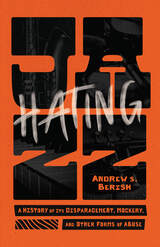 Hating Jazz: A History of Its Disparagement, Mockery, and Other Forms of Abuse
Andrew S. Berish
University of Chicago Press, 2025 A deep dive into the meaning behind the hatred of jazz.
A rock guitarist plays four notes in front of one thousand people, while a jazz guitarist plays one thousand notes in front of four people. You might laugh or groan at this jazz joke, but what is it about jazz that makes people want to disparage it in the first place?
Andrew S. Berish’s Hating Jazz listens to the voices who have denounced, disparaged, and mocked the music. By focusing on the rejection of the music, Berish says, we see more holistically jazz’s complicated place in American cultural life. Jazz is a display of Black creativity and genius, an art form that is deeply embedded in African American life. Though the explicit racial tenor of jazz jokes has become muted over time, making fun of jazz, either in a lighthearted or aggressive way, is also an engagement with the place of Blackness in America. An individual’s taste in music may seem personal, but Berish’s analysis of jazz hatred demonstrates that musical preferences and trends are a social phenomenon. Criticism of jazz has become inextricable from the ways we understand race in America, past and present. In addition to this form of criticism, Berish also considers jazz hate as a form of taste discrimination and as a conflict over genre boundaries within different jazz cultures.
Both enlightening and original, Hating Jazz shows that our response to music can be a social act, unique to our historical moment and cultural context—we react to music in certain ways because of who we are, where we are, and when we are.
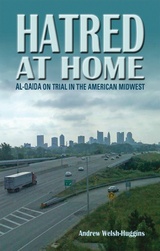 Hatred at Home: al-Qaida on Trial in the American Midwest
Andrew Welsh-Huggins
Ohio University Press, 2011 One day in 2002, three friends—a Somali immigrant, a Pakistan–born U.S. citizen, and a hometown African American—met in a Columbus, Ohio coffee shop and vented over civilian casualties in the war in Afghanistan. Their conversation triggered an investigation that would become one of the most unusual and far–reaching government probes into terrorism since the 9/11 attacks. Over several years, prosecutors charged each man with unrelated terrorist activities in cases that embodied the Bush administration’s approach to fighting terrorism at home. Government lawyers spoke of catastrophes averted; defense attorneys countered that none of the three had done anything but talk. The stories of these homegrown terrorists illustrate the paradox the government faces after September 11: how to fairly wage a war against alleged enemies living in our midst. Hatred at Home is a true crime drama that will spark debate from all political corners about safety, civil liberties, free speech, and the government’s war at home.
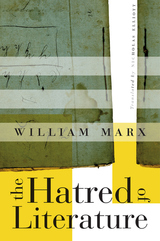 The Hatred of Literature
William Marx
Harvard University Press, 2018 For the last 2,500 years literature has been attacked, booed, and condemned, often for the wrong reasons and occasionally for very good ones. The Hatred of Literature examines the evolving idea of literature as seen through the eyes of its adversaries: philosophers, theologians, scientists, pedagogues, and even leaders of modern liberal democracies. From Plato to C. P. Snow to Nicolas Sarkozy, literature’s haters have questioned the value of literature—its truthfulness, virtue, and usefulness—and have attempted to demonstrate its harmfulness.
Literature does not start with Homer or Gilgamesh, William Marx says, but with Plato driving the poets out of the city, like God casting Adam and Eve out of Paradise. That is its genesis. From Plato the poets learned for the first time that they served not truth but merely the Muses. It is no mere coincidence that the love of wisdom (philosophia) coincided with the hatred of poetry. Literature was born of scandal, and scandal has defined it ever since.
In the long rhetorical war against literature, Marx identifies four indictments—in the name of authority, truth, morality, and society. This typology allows him to move in an associative way through the centuries. In describing the misplaced ambitions, corruptible powers, and abysmal failures of literature, anti-literary discourses make explicit what a given society came to expect from literature. In this way, anti-literature paradoxically asserts the validity of what it wishes to deny. The only threat to literature’s continued existence, Marx writes, is not hatred but indifference.
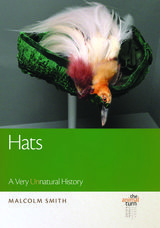 Hats: A Very UNnatural History
Malcolm Smith
Michigan State University Press, 2020 For such simple garments, hats have had a devastating impact on wildlife throughout their long history. Made of wild-caught mammal furs, decorated with feathers or whole stuffed birds, historically they have driven many species to near extinction. By the turn of the twentieth century, egrets, shot for their exuberant white neck plumes, had been decimated; the wild ostrich, killed for its feathers until the early 1900s, was all but extirpated; and vast numbers of birds of paradise from New Guinea and hummingbirds from the Americas were just some of the other birds killed to decorate ladies’ hats. At its peak, the hat trade was estimated to be killing 200 million birds a year. At the end of the nineteenth century, it was a trade valued at £20 million (over $25 million) a year at the London feather auctions. Weight for weight, exotic feathers were more valuable than gold. Today, while no wild birds are captured for feather decoration, some wild animals are still trapped and killed for hatmaking. A fascinating read, Hats will have you questioning the history of your headwear.
Hattie and Huey: An Arkansas Tour
David Malone
University of Arkansas Press, 1990 During the first eight scorching days of August in 1932, U.S. Senator Huey P. Long of Louisiana campaigned in Arkansas for the election of Hattie Caraway to the U.S. Senate. Caraway easily defeated six well-known opponents in a race she was not expected to win and became the first woman to be elected to the U.S. Senate. This volume is a textbook of politics and a sweeping picture of the Great Depression, as if those perilous times had been compressed into a week and a day. It is a fascinating look at two extremely different people caught briefly in a common purpose.
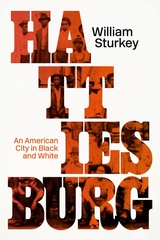 Hattiesburg: An American City in Black and White
William Sturkey
Harvard University Press, 2019 Winner of the Zócalo Public Square Book Prize
Benjamin L. Hooks Award Finalist
“An insightful, powerful, and moving book.”
—Kevin Boyle, author of Arc of Justice
“Sturkey’s clear-eyed and meticulous book pulls off a delicate balancing act. While depicting the terrors of Jim Crow, he also shows how Hattiesburg’s black residents, forced to forge their own communal institutions, laid the organizational groundwork for the civil rights movement.”
—New York Times
If you really want to understand Jim Crow—what it was and how African Americans rose up to defeat it—you should start by visiting Mobile Street in Hattiesburg, Mississippi, the heart of the historic black downtown. There you can still see remnants of the shops and churches where, amid the violence and humiliation of segregation, men and women gathered to build a remarkable community. Hattiesburg takes us into the heart of this divided town and deep into the lives of families on both sides of the racial divide to show how the fabric of their existence was shaped by the changing fortunes of the Jim Crow South.
“Sturkey’s magnificent portrait reminds us that Mississippi is no anachronism. It is the dark heart of American modernity.”
—Robin D. G. Kelley, author of Thelonious Monk
“When they are at their best, historians craft powerful, compelling, often genre-changing pieces of history…William Sturkey is one of those historians…A brilliant, poignant work.”
—Charles W. McKinney, Jr., Journal of African American History
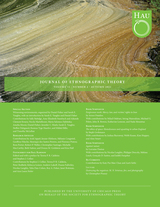 HAU: Journal of Ethnographic Theory, volume 11 number 2 (Autumn 2021)
The University of Chicago Press
University of Chicago Press Journals, 2021 This is volume 11 issue 2 of HAU: Journal of Ethnographic Theory. HAU: Journal of Ethnographic Theory, is an international journal which aims to situate ethnography as the prime heuristic of anthropology, and return it to the forefront of conceptual developments in the discipline. The journal is motivated by the need to reinstate ethnographic theorization in contemporary anthropology as a potent alternative to its "explanation" or "contextualization" by philosophical arguments, moves which have resulted in a loss of the discipline's distinctive theoretical nerve. By drawing out its potential to critically engage and challenge Western cosmological assumptions and conceptual determinations, HAU aims to provide an exciting new arena for evaluating ethnography as a daring enterprise for 'worlding' alien terms and forms of life, by exploiting their potential for rethinking humanity and alterity.
 HAU: Journal of Ethnographic Theory, volume 11 number 3 (Winter 2021)
The University of Chicago Press
University of Chicago Press Journals, 2021 This is volume 11 issue 3 of HAU: Journal of Ethnographic Theory. HAU: Journal of Ethnographic Theory, is an international journal which aims to situate ethnography as the prime heuristic of anthropology, and return it to the forefront of conceptual developments in the discipline. The journal is motivated by the need to reinstate ethnographic theorization in contemporary anthropology as a potent alternative to its "explanation" or "contextualization" by philosophical arguments, moves which have resulted in a loss of the discipline's distinctive theoretical nerve. By drawing out its potential to critically engage and challenge Western cosmological assumptions and conceptual determinations, HAU aims to provide an exciting new arena for evaluating ethnography as a daring enterprise for 'worlding' alien terms and forms of life, by exploiting their potential for rethinking humanity and alterity.
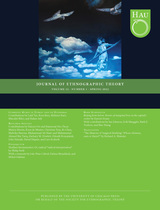 HAU: Journal of Ethnographic Theory, volume 12 number 1 (Spring 2022)
The University of Chicago Press
University of Chicago Press Journals, 2022 This is volume 12 issue 1 of HAU: Journal of Ethnographic Theory. HAU: Journal of Ethnographic Theory, is an international journal which aims to situate ethnography as the prime heuristic of anthropology, and return it to the forefront of conceptual developments in the discipline. The journal is motivated by the need to reinstate ethnographic theorization in contemporary anthropology as a potent alternative to its "explanation" or "contextualization" by philosophical arguments, moves which have resulted in a loss of the discipline's distinctive theoretical nerve. By drawing out its potential to critically engage and challenge Western cosmological assumptions and conceptual determinations, HAU aims to provide an exciting new arena for evaluating ethnography as a daring enterprise for 'worlding' alien terms and forms of life, by exploiting their potential for rethinking humanity and alterity.
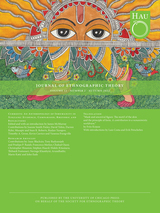 HAU: Journal of Ethnographic Theory, volume 12 number 2 (Autumn 2022)
The University of Chicago Press
University of Chicago Press Journals, 2022 This is volume 12 issue 2 of HAU: Journal of Ethnographic Theory. HAU: Journal of Ethnographic Theory, is an international journal which aims to situate ethnography as the prime heuristic of anthropology, and return it to the forefront of conceptual developments in the discipline. The journal is motivated by the need to reinstate ethnographic theorization in contemporary anthropology as a potent alternative to its "explanation" or "contextualization" by philosophical arguments, moves which have resulted in a loss of the discipline's distinctive theoretical nerve. By drawing out its potential to critically engage and challenge Western cosmological assumptions and conceptual determinations, HAU aims to provide an exciting new arena for evaluating ethnography as a daring enterprise for 'worlding' alien terms and forms of life, by exploiting their potential for rethinking humanity and alterity.
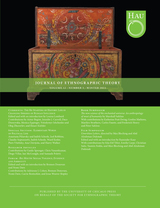 HAU: Journal of Ethnographic Theory, volume 12 number 3 (Winter 2022)
The University of Chicago Press
University of Chicago Press Journals, 2022 This is volume 12 issue 3 of HAU: Journal of Ethnographic Theory. HAU: Journal of Ethnographic Theory, is an international journal which aims to situate ethnography as the prime heuristic of anthropology, and return it to the forefront of conceptual developments in the discipline. The journal is motivated by the need to reinstate ethnographic theorization in contemporary anthropology as a potent alternative to its "explanation" or "contextualization" by philosophical arguments, moves which have resulted in a loss of the discipline's distinctive theoretical nerve. By drawing out its potential to critically engage and challenge Western cosmological assumptions and conceptual determinations, HAU aims to provide an exciting new arena for evaluating ethnography as a daring enterprise for 'worlding' alien terms and forms of life, by exploiting their potential for rethinking humanity and alterity.
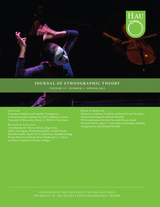 HAU: Journal of Ethnographic Theory, volume 13 number 1 (Spring 2023)
The University of Chicago Press
University of Chicago Press Journals, 2023 This is volume 13 issue 1 of HAU: Journal of Ethnographic Theory. HAU: Journal of Ethnographic Theory, is an international journal which aims to situate ethnography as the prime heuristic of anthropology, and return it to the forefront of conceptual developments in the discipline. The journal is motivated by the need to reinstate ethnographic theorization in contemporary anthropology as a potent alternative to its "explanation" or "contextualization" by philosophical arguments, moves which have resulted in a loss of the discipline's distinctive theoretical nerve. By drawing out its potential to critically engage and challenge Western cosmological assumptions and conceptual determinations, HAU aims to provide an exciting new arena for evaluating ethnography as a daring enterprise for 'worlding' alien terms and forms of life, by exploiting their potential for rethinking humanity and alterity.
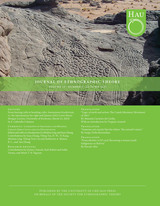 HAU: Journal of Ethnographic Theory, volume 13 number 2 (Autumn 2023)
The University of Chicago Press
University of Chicago Press Journals, 2023 This is volume 13 issue 2 of HAU: Journal of Ethnographic Theory. HAU: Journal of Ethnographic Theory, is an international journal which aims to situate ethnography as the prime heuristic of anthropology, and return it to the forefront of conceptual developments in the discipline. The journal is motivated by the need to reinstate ethnographic theorization in contemporary anthropology as a potent alternative to its "explanation" or "contextualization" by philosophical arguments, moves which have resulted in a loss of the discipline's distinctive theoretical nerve. By drawing out its potential to critically engage and challenge Western cosmological assumptions and conceptual determinations, HAU aims to provide an exciting new arena for evaluating ethnography as a daring enterprise for 'worlding' alien terms and forms of life, by exploiting their potential for rethinking humanity and alterity.
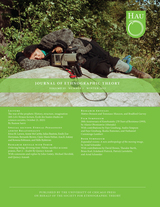 HAU: Journal of Ethnographic Theory, volume 13 number 3 (Winter 2023)
The University of Chicago Press
University of Chicago Press Journals, 2023 This is volume 13 issue 3 of HAU: Journal of Ethnographic Theory. HAU: Journal of Ethnographic Theory, is an international journal which aims to situate ethnography as the prime heuristic of anthropology, and return it to the forefront of conceptual developments in the discipline. The journal is motivated by the need to reinstate ethnographic theorization in contemporary anthropology as a potent alternative to its "explanation" or "contextualization" by philosophical arguments, moves which have resulted in a loss of the discipline's distinctive theoretical nerve. By drawing out its potential to critically engage and challenge Western cosmological assumptions and conceptual determinations, HAU aims to provide an exciting new arena for evaluating ethnography as a daring enterprise for 'worlding' alien terms and forms of life, by exploiting their potential for rethinking humanity and alterity.
 HAU: Journal of Ethnographic Theory, volume 14 number 1 (Spring 2024)
The University of Chicago Press
University of Chicago Press Journals, 2024 This is volume 14 issue 1 of HAU: Journal of Ethnographic Theory. HAU: Journal of Ethnographic Theory, is an international journal which aims to situate ethnography as the prime heuristic of anthropology, and return it to the forefront of conceptual developments in the discipline. The journal is motivated by the need to reinstate ethnographic theorization in contemporary anthropology as a potent alternative to its "explanation" or "contextualization" by philosophical arguments, moves which have resulted in a loss of the discipline's distinctive theoretical nerve. By drawing out its potential to critically engage and challenge Western cosmological assumptions and conceptual determinations, HAU aims to provide an exciting new arena for evaluating ethnography as a daring enterprise for 'worlding' alien terms and forms of life, by exploiting their potential for rethinking humanity and alterity.
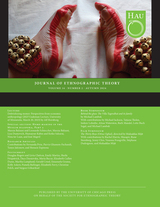 HAU: Journal of Ethnographic Theory, volume 14 number 2 (Autumn 2024)
The University of Chicago Press
University of Chicago Press Journals, 2024 This is volume 14 issue 2 of HAU: Journal of Ethnographic Theory. HAU: Journal of Ethnographic Theory, is an international journal which aims to situate ethnography as the prime heuristic of anthropology, and return it to the forefront of conceptual developments in the discipline. The journal is motivated by the need to reinstate ethnographic theorization in contemporary anthropology as a potent alternative to its "explanation" or "contextualization" by philosophical arguments, moves which have resulted in a loss of the discipline's distinctive theoretical nerve. By drawing out its potential to critically engage and challenge Western cosmological assumptions and conceptual determinations, HAU aims to provide an exciting new arena for evaluating ethnography as a daring enterprise for 'worlding' alien terms and forms of life, by exploiting their potential for rethinking humanity and alterity.
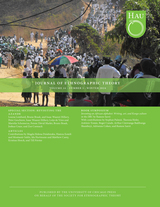 HAU: Journal of Ethnographic Theory, volume 14 number 3 (Winter 2024)
The University of Chicago Press
University of Chicago Press Journals, 2024 This is volume 14 issue 3 of HAU: Journal of Ethnographic Theory. HAU: Journal of Ethnographic Theory, is an international journal which aims to situate ethnography as the prime heuristic of anthropology, and return it to the forefront of conceptual developments in the discipline. The journal is motivated by the need to reinstate ethnographic theorization in contemporary anthropology as a potent alternative to its "explanation" or "contextualization" by philosophical arguments, moves which have resulted in a loss of the discipline's distinctive theoretical nerve. By drawing out its potential to critically engage and challenge Western cosmological assumptions and conceptual determinations, HAU aims to provide an exciting new arena for evaluating ethnography as a daring enterprise for 'worlding' alien terms and forms of life, by exploiting their potential for rethinking humanity and alterity.
 HAU: Journal of Ethnographic Theory, volume 15 number 1 (Spring 2025)
The University of Chicago Press
University of Chicago Press Journals, 2025 This is volume 15 issue 1 of HAU: Journal of Ethnographic Theory. HAU: Journal of Ethnographic Theory, is an international journal which aims to situate ethnography as the prime heuristic of anthropology, and return it to the forefront of conceptual developments in the discipline. The journal is motivated by the need to reinstate ethnographic theorization in contemporary anthropology as a potent alternative to its "explanation" or "contextualization" by philosophical arguments, moves which have resulted in a loss of the discipline's distinctive theoretical nerve. By drawing out its potential to critically engage and challenge Western cosmological assumptions and conceptual determinations, HAU aims to provide an exciting new arena for evaluating ethnography as a daring enterprise for 'worlding' alien terms and forms of life, by exploiting their potential for rethinking humanity and alterity.
 HAU: Journal of Ethnographic Theory, volume 15 number 2 (Autumn 2025)
The University of Chicago Press
University of Chicago Press Journals, 2025 This is volume 15 issue 2 of HAU: Journal of Ethnographic Theory. HAU: Journal of Ethnographic Theory, is an international journal which aims to situate ethnography as the prime heuristic of anthropology, and return it to the forefront of conceptual developments in the discipline. The journal is motivated by the need to reinstate ethnographic theorization in contemporary anthropology as a potent alternative to its "explanation" or "contextualization" by philosophical arguments, moves which have resulted in a loss of the discipline's distinctive theoretical nerve. By drawing out its potential to critically engage and challenge Western cosmological assumptions and conceptual determinations, HAU aims to provide an exciting new arena for evaluating ethnography as a daring enterprise for 'worlding' alien terms and forms of life, by exploiting their potential for rethinking humanity and alterity.
HAU vol 10 num 1
The University of Chicago Press
University of Chicago Press Journals, 2020
HAU vol 10 num 2
The University of Chicago Press
University of Chicago Press Journals, 2020 This is volume 10 issue 2 of HAU: Journal of Ethnographic Theory. HAU: Journal of Ethnographic Theory, is an international journal which aims to situate ethnography as the prime heuristic of anthropology, and return it to the forefront of conceptual developments in the discipline. The journal is motivated by the need to reinstate ethnographic theorization in contemporary anthropology as a potent alternative to its "explanation" or "contextualization" by philosophical arguments, moves which have resulted in a loss of the discipline's distinctive theoretical nerve. By drawing out its potential to critically engage and challenge Western cosmological assumptions and conceptual determinations, HAU aims to provide an exciting new arena for evaluating ethnography as a daring enterprise for 'worlding' alien terms and forms of life, by exploiting their potential for rethinking humanity and alterity.
HAU vol 10 num 3
The University of Chicago Press
University of Chicago Press Journals, 2020
HAU vol 8 num 12
The University of Chicago Press
University of Chicago Press Journals, 2018
HAU vol 8 num 3
The University of Chicago Press
University of Chicago Press Journals, 2018
HAU vol 9 num 1
The University of Chicago Press
University of Chicago Press Journals, 2019 This is volume 9 issue 1 of HAU: Journal of Ethnographic Theory. HAU: Journal of Ethnographic Theory, is an international journal which aims to situate ethnography as the prime heuristic of anthropology, and return it to the forefront of conceptual developments in the discipline. The journal is motivated by the need to reinstate ethnographic theorization in contemporary anthropology as a potent alternative to its "explanation" or "contextualization" by philosophical arguments, moves which have resulted in a loss of the discipline's distinctive theoretical nerve. By drawing out its potential to critically engage and challenge Western cosmological assumptions and conceptual determinations, HAU aims to provide an exciting new arena for evaluating ethnography as a daring enterprise for 'worlding' alien terms and forms of life, by exploiting their potential for rethinking humanity and alterity.
HAU vol 9 num 2
The University of Chicago Press
University of Chicago Press Journals, 2019
HAU vol 9 num 3
The University of Chicago Press
University of Chicago Press Journals, 2019
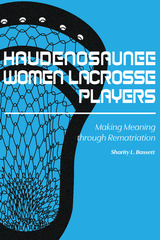 Haudenosaunee Women Lacrosse Players: Making Meaning through Rematriation
Sharity L. Bassett
Michigan State University Press, 2024 Since the 1970s lacrosse has become one of the fastest-growing sports in North America, and Haudenosaunee communities have worked at the international level to claim lacrosse as an important part of Haudenosaunee culture and tradition. Lacrosse is also known as the medicine game as it is part of a medicine ceremony named in creation narratives and the Great Law of Peace that binds the six nations of the Haudenosaunee Confederacy Six Nations. The number of Haudenosaunee women and girls playing the sport has burgeoned since the 1980s. This book roots lacrosse as a Haudenosaunee sport both within and outside of these communities. It shows how the concept of rematriation—a culturally relevant framework that articulates the work Haudenosaunee peoples are doing to reconnect to the power imbued with matrilineal and matrifocal societies—situates Haudenosaunee women who play lacrosse within a complex understanding of contemporary, traditional, and medicinal lacrosse. Because they cannot seamlessly claim this as their medicine game, as the Haudenosaunee Nationals and other men’s teams do, Haudenosaunee women players must articulate some of the most nuanced understandings of tradition and medicine. These articulations connect to larger conversations within Haudenosaunee communities regarding the power that women hold and the rematriation of that power to define and uphold tradition. Haudenosaunee Women Lacrosse Players demonstrates how the cycle of action and articulation—with the intergenerational help of female leadership—firmly roots lacrosse within Haudenosaunee cultural fabric.
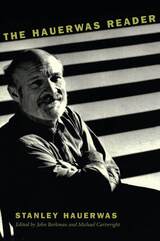 The Hauerwas Reader
Stanley Hauerwas
Duke University Press, 2001 Stanley Hauerwas is one of the most widely read and oft-cited theologians writing today. A prolific lecturer and author, he has been at the forefront of key developments in contemporary theology, ranging from narrative theology to the “recovery of virtue.” Yet despite his prominence and the esteem reserved for his thought, his work has never before been collected in a single volume that provides a sense of the totality of his vision.
The editors of The Hauerwas Reader, therefore, have compiled and edited a volume that represents all the different periods and phases of Hauerwas’s work. Highlighting both his constructive goals and penchant for polemic, the collection reflects the enormous variety of subjects he has engaged, the different genres in which he has written, and the diverse audiences he has addressed. It offers Hauerwas on ethics, virtue, medicine, and suffering; on euthanasia, abortion, and sexuality; and on war in relation to Catholic and Protestant thought. His essays on the role of religion in liberal democracies, the place of the family in capitalist societies, the inseparability of Christianity and Judaism, and on many other topics are included as well.
Perhaps more than any other author writing on religious topics today, Hauerwas speaks across lines of religious traditions, appealing to Methodists, Jews, Anabaptists or Mennonites, Catholics, Episcopalians, and others.
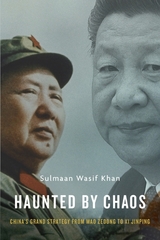 Haunted by Chaos: China’s Grand Strategy from Mao Zedong to Xi Jinping
Sulmaan Wasif Khan
Harvard University Press, 2018 An American Interest Top Book of the Year
“Khan has unraveled the mystery of Chinese grand strategy, showing why insecurity lies at the root of Chinese power projection… Readers will not find a shrewder analysis as to why the Chinese act as they do.”
—Robert D. Kaplan, author of The Revenge of Geography
Before the Chinese Communist Party came to power, China lay broken and fragmented. Today it is a force on the global stage, and yet its leaders have continued to be haunted by the past. Drawing on an array of sources, Sulmaan Wasif Khan chronicles the grand strategies that have sought not only to protect China from aggression but also to ensure it would never again experience the powerlessness of the late Qing and Republican eras.
The dramatic variations in China’s modern history have obscured the commonality of purpose that binds the country’s leaders. Analyzing the calculus behind their decision making, Khan explores how they wove diplomatic, military, and economic power together to keep a fragile country safe in a world they saw as hostile. Dangerous and shrewd, Mao Zedong made China whole and succeeded in keeping it so, while the caustic, impatient Deng Xiaoping dragged China into the modern world. Jiang Zemin and Hu Jintao served as cautious custodians of the Deng legacy, but the powerful and deeply insecure Xi Jinping has shown an assertiveness that has raised both fear and hope across the globe.
For all their considerable costs, China’s grand strategies have been largely successful. But the country faces great challenges today. Its population is aging, its government is undermined by corruption, its neighbors are arming out of concern over its growing power, and environmental degradation threatens catastrophe. A question Haunted by Chaos raises is whether China’s time-tested approach can respond to the looming threats of the twenty-first century.
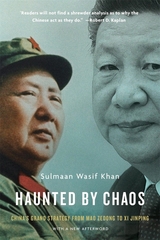 Haunted by Chaos: China’s Grand Strategy from Mao Zedong to Xi Jinping, With a New Afterword
Sulmaan Wasif Khan
Harvard University Press, 2022 An American Interest Book of the Year
“Readers will not find a shrewder analysis as to why the Chinese act as they do.”
—Robert D. Kaplan
“An outstanding contribution to our understanding of that most urgent of contemporary geopolitical questions: what does China want?”
—Rana Mitter
Before the Chinese Communist Party came to power, China lay broken and fragmented. Today it dominates the global stage, and yet its leaders have continued to be haunted by the past. Analyzing the calculus behind decision making at the highest levels, Sulmaan Wasif Khan explores how China’s leaders have harnessed diplomatic, military, and economic power to keep a fragile country safe in a hostile world. At once shrewd and dangerous, Mao Zedong made China whole and succeeded in keeping it so while the caustic Deng Xiaoping dragged China into the modern world. Jiang Zemin and Hu Jintao were cautious custodians of Deng’s legacy, but Xi Jinping has shown a mounting assertiveness that has raised concern across the globe.
China’s grand strategies, while costly, have been largely successful. But will this time-tested approach be enough to tackle the looming threats of our age?
“Written with verve and insight, this will become the go-to book for anyone interested in the foundations of China’s grand strategy under Communist rule.”
—Odd Arne Westad, author of The Cold War
“Khan’s brilliant analysis will help policymakers understand the critical rise of China…Crucial if we are to avoid conflict with this emerging superpower.”
—Admiral James Stavridis, former Supreme Allied Commander of NATO
“Khan argues that since before the People’s Republic of China’s founding, Chinese rulers have held remarkably consistent objectives, even as their definition of security has expanded.”
—Mira Rapp-Hooper, War on the Rocks
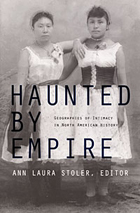 Haunted by Empire: Geographies of Intimacy in North American History
Ann Laura Stoler, ed.
Duke University Press, 2006 A milestone in U.S. historiography, Haunted by Empire brings postcolonial critiques to bear on North American history and draws on that history to question the analytic conventions of postcolonial studies. The contributors to this innovative collection examine the critical role of “domains of the intimate” in the consolidation of colonial power. They demonstrate how the categories of difference underlying colonialism—the distinctions advanced as the justification for the colonizer’s rule of the colonized—were enacted and reinforced in intimate realms from the bedroom to the classroom to the medical examining room. Together the essays focus attention on the politics of comparison—on how colonizers differentiated one group or set of behaviors from another—and on the circulation of knowledge and ideologies within and between imperial projects. Ultimately, this collection forces a rethinking of what historians choose to compare and of the epistemological grounds on which those choices are based. Haunted by Empire includes Ann Laura Stoler’s seminal essay “Tense and Tender Ties” as well as her bold introduction, which carves out the exciting new analytic and methodological ground animated by this comparative venture. The contributors engage in a lively cross-disciplinary conversation, drawing on history, anthropology, literature, philosophy, and public health. They address such topics as the regulation of Hindu marriages and gay sexuality in the early-twentieth-century United States; the framing of multiple-choice intelligence tests; the deeply entangled histories of Asian, African, and native peoples in the Americas; the racial categorizations used in the 1890 U.S. census; and the politics of race and space in French colonial New Orleans. Linda Gordon, Catherine Hall, and Nancy F. Cott each provide a concluding essay reflecting on the innovations and implications of the arguments advanced in Haunted by Empire. Contributors. Warwick Anderson, Laura Briggs, Kathleen Brown, Nancy F. Cott, Shannon Lee Dawdy, Linda Gordon, Catherine Hall, Martha Hodes, Paul A. Kramer, Lisa Lowe, Tiya Miles, Gwenn A. Miller, Emily S. Rosenberg, Damon Salesa, Nayan Shah, Alexandra Minna Stern, Ann Laura Stoler, Laura Wexler
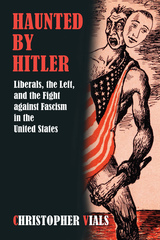 Haunted by Hitler: Liberals, the Left, and the Fight against Fascism in the United States
Christopher Vials
University of Massachusetts Press, 2014 Although fascism is typically associated with Europe, the threat of fascism in the United States haunted the imaginations of activists, writers, and artists, spurring them to create a rich, elaborate body of cultural and political work. Traversing the Popular Front of the 1930s, the struggle against McCarthyism in the 1950s, the Black Power movement of the 1960s, and the AIDS activism of the 1980s, Haunted by Hitler highlights the value of "antifascist" cultural politics, showing how it helped to frame the national discourse.
Christopher Vials examines the ways in which anxieties about fascism in the United States have been expressed in the public sphere, through American television shows, Off-Broadway theater, party newspapers, bestselling works of history, journalism, popular sociology, political theory, and other media. He argues that twentieth-century liberals and leftists were more deeply unsettled by the problem of fascism than those at the center or the right and that they tirelessly and often successfully worked to counter America's fascist equivalents.
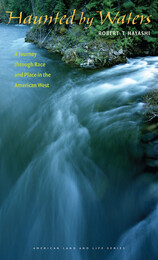 Haunted by Waters: A Journey through Race and Place in the American West
Robert T. Hayashi
University of Iowa Press, 2007 Even though race influenced how Americans envisioned, represented, and shaped the American West, discussions of its history devalue the experiences of racial and ethnic minorities. In this lyrical history of marginalized peoples in Idaho, Robert T. Hayashi views the West from a different perspective by detailing the ways in which they shaped the western landscape and its meaning. As an easterner, researcher, angler, and third-generation Japanese American traveling across the contemporary Idaho landscape—where his grandfather died during internment during World War II—Hayashi reconstructs a landscape that lured emigrants of all races at the same time its ruling forces were developing cultured processes that excluded nonwhites. Throughout each convincing and compelling chapter, he searches for the stories of dispossessed minorities as patiently as he searches for trout. Using a wide range of materials that include memoirs, oral interviews, poetry, legal cases, letters, government documents, and even road signs, Hayashi illustrates how Thomas Jefferson’s vision of an agrarian, all-white, and democratic West affected the Gem State’s Nez Perce, Chinese, Shoshone, Mormon, and particularly Japanese residents. Starting at the site of the Corps of Discovery’s journey into Idaho, he details the ideological, aesthetic, and material manifestations of these intertwined notions of race and place. As he ?y-?shes Idaho’s fabled rivers and visits its historical sites and museums, Hayashi reads the contemporary landscape in light of this evolution.
Haunted By Waters: Fly Fishing In North American Literature
Mark Browning
Ohio University Press, 1998 Four essential questions: Why does one fish? How should one properly fish? What relations are created in fishing? And what effects does fishing have on the future? Haunted by Waters is a self-examination by the author as he constructs his own narrative and tries to answer these questions for himself. But it is also a thorough examination of the answers he uncovers in the course of reading what's been written on the subject.
As his own story unfolds, Mark Browning analyzes angling literature from the Bible to Norman Maclean, always bringing his inquiry back to the same source: the enigma of this sport.
Haunted by Waters is an exploration of the apparent compulsion of those who fish not only to read about the sport, but to write about it as well. Mark Browning's personal account as a fly fisherman and his perspective as a critic make him uniquely qualified to navigate these waters.
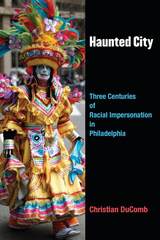 Haunted City: Three Centuries of Racial Impersonation in Philadelphia
Christian DuComb
University of Michigan Press, 2017 Haunted City explores the history of racial impersonation in Philadelphia from the late eighteenth century through the present day. The book focuses on select historical moments, such as the advent of the minstrel show and the ban on blackface makeup in the Philadelphia Mummers Parade, when local performances of racial impersonation inflected regional, national, transnational, and global formations of race.
Mummers have long worn blackface makeup during winter holiday celebrations in Europe and North America; in Philadelphia, mummers’ blackface persisted from the colonial period well into the twentieth century. The first annual Mummers Parade, a publicly sanctioned procession from the working-class neighborhoods of South Philadelphia to the city center, occurred in 1901. Despite a ban on blackface in the Mummers Parade after civil rights protests in 1963–64, other forms of racial and ethnic impersonation in the parade have continued to flourish unchecked. Haunted City combines detailed historical research with the author’s own experiences performing in the Mummers Parade to create a lively and richly illustrated narrative. Through its interdisciplinary approach, Haunted City addresses not only theater history and performance studies but also folklore, American studies, critical race theory, and art history. It also offers a fresh take on the historiography of the antebellum minstrel show.
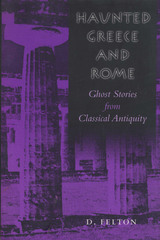 Haunted Greece and Rome: Ghost Stories from Classical Antiquity
By D. Felton
University of Texas Press, 1998 Stories of ghostly spirits who return to this world to warn of danger, to prophesy, to take revenge, to request proper burial, or to comfort the living fascinated people in ancient times just as they do today. In this innovative, interdisciplinary study, the author combines a modern folkloric perspective with literary analysis of ghost stories from classical antiquity to shed new light on the stories' folk roots. The author begins by examining ancient Greek and Roman beliefs about death and the departed and the various kinds of ghost stories which arose from these beliefs. She then focuses on the longer stories of Plautus, Pliny, and Lucian, which concern haunted houses. Her analysis illuminates the oral and literary transmission and adaptation of folkloric motifs and the development of the ghost story as a literary form. In her concluding chapter, the author also traces the influence of ancient ghost stories on modern ghost story writers, a topic that will interest all readers and scholars of tales of hauntings.
 Haunted Heart: A Biography of Susannah McCorkle
Linda Dahl
University of Michigan Press, 2006 "In this comprehensive biography, compiled from meticulous research and interviews with many of McCorkle's confidants . . . Dahl reconstructs a career distinguished by great promise and great sadness . . . doing her best to address a large, looming 'Why?' that can never be completely answered."
—New York Times "A compelling, sympathetic but often chilling view not only of McCorkle's complexities but also of the difficult business of music itself and of the widespread always potentially fatal illness now better known as bipolar disorder, which the singer hid from so many, even from herself for many years."
—Newsweek “Susannah's life was dark and daunting. Her music was suave and sunny. Both are honored in this remarkably well-researched and constantly revealing keyhole peek into a haunted life that is both chilling and exhilarating. I could not put it down.”
—Rex Reed “Susannah McCorkle was a mesmerizing singer with a dark side she hid even from her closest friends. Now, thanks to this probing and courageous biography, we can understand the gut ambition that took her to the top of her field and the turmoil that brought her down.”
—James Gavin, author of Deep in a Dream: The Long Night of Chet Baker “Haunted Heart strikingly resembles the woman it describes: it is vivacious, tender, saturnine, industrious, and deeply intelligent. Like Susannah's way with certain ballads, it opens a wound and begins the work of healing it. I am grateful for Linda Dahl's diligence and sympathy.”
—Leon Wieseltier Linda Dahl is the author of Stormy Weather: The Music and Lives of a Century of Jazzwomen and Morning Glory: A Biography of Mary Lou Williams. Visit the author’s website at www.dahljazz.com.
Haunted Heartland
Michael Norman
University of Wisconsin Press, 2017 A fleeting figure dressed in a white party dress roams the streets of southwest Chicago. A long-dead Iowa college student treads the staircase in an old building. A ghostly, plaid-shirted workman plays peek-a-boo with a ticket seller in a Minnesota theater. A phantom wolf prowls Ohio's Jackson and Pike Counties.
For decades, journalist Michael Norman has been tracking down spine-tingling tales that seem to arise from authentic incidents in Illinois, Indiana, Iowa, Kansas, Michigan, Minnesota, Missouri, Nebraska, Ohio, and Wisconsin. In Haunted Heartland he offers more than eighty entertaining, eerie stories. Are they true in the world that we know, or only in a dark vale of twilight?
 Haunted Homes
Dahlia Schweitzer
Rutgers University Press, 2021 Haunted Homes is a short but groundbreaking study of homes in horror film and television. While haunted houses can be fun and thrilling, Hollywood horror tends to focus on haunted homes, places where the suburban American dream of safety and comfort has turned into a nightmare. From classic movies like The Old Dark House to contemporary works like Hereditary and the Netflix series The Haunting of Hill House, Dahlia Schweitzer explores why haunted homes have become a prime stage for dramatizing anxieties about family, gender, race, and economic collapse. She traces how the haunted home film was intertwined with the expansion of American suburbia, but also explores works like The Witch and The Babadook, which transport the genre to different times and places. This lively and readable study reveals how and why an increasing number of films imagine that home is where the horror is. Watch a video of the author discussing the topic Haunted Homes (https://youtu.be/_irTEfvtZfQ).
Haunted Life: Visual Culture and Black Modernity
Marriott, David
Rutgers University Press, 2007 In Haunted Life, David Marriott examines the complex interplay between racial fears and anxieties and the political-visual cultures of suspicion and state terror. He compels readers to consider how media technologies are "haunted" by the phantom of racial slavery. Through examples from film and television, modernist literature, and philosophy, he shows how the ideological image of a brutal African past is endlessly recycled and how this perpetuation of historical catastrophe stokes our nation's race-conscious paranoia. Drawing on a range of comparative readings by writers, theorists, and filmmakers, including John Edgar Wideman, Frantz Fanon, Richard Wright, Issac Julien, Alain Locke, and Sidney Poitier, Haunted Life is a bold and original exploration of the legacies of black visual culture and the political, deeply sexualized violence that lies buried beneath it.
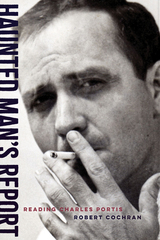 Haunted Man's Report: Reading Charles Portis
Robert Cochran
University of Arkansas Press, 2024 Robert Cochran’s Haunted Man’s Report is a pioneering study of the novels and other writings of Arkansan Charles Portis (1933–2020), best known for the novel True Grit and its film adaptations. Hailed by one critic as “the author of classics on the order of a twentieth-century Mark Twain” and as America’s “least-known great novelist,” Portis has garnered a devoted fan base with his ear for language, picaresque characters, literary Easter eggs, and talent for injecting comedy into even the smallest turn of phrase. As a former Marine who served on the front lines of the Korean War and as a journalist who observed firsthand the violent resistance to the civil rights movement, Portis reported on atrocities that came to inform his fiction profoundly. His novels take aim at colonialism and notions of American exceptionalism, focusing on ordinary people, often vets, searching for safe havens in a fallen world.
Haunted Man’s Report, a deeply insightful literary exploration of Portis’s singular and underexamined oeuvre, celebrates this novelist’s great achievement and is certain to prove a valuable guide for readers new to Portis as well as aficionados.
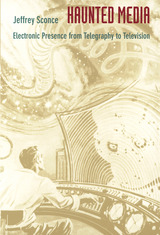 Haunted Media: Electronic Presence from Telegraphy to Television
Jeffrey Sconce
Duke University Press, 2000 In Haunted Media Jeffrey Sconce examines American culture’s persistent association of new electronic media—from the invention of the telegraph to the introduction of television and computers—with paranormal or spiritual phenomena. By offering a historical analysis of the relation between communication technologies, discourses of modernity, and metaphysical preoccupations, Sconce demonstrates how accounts of “electronic presence” have gradually changed over the decades from a fascination with the boundaries of space and time to a more generalized anxiety over the seeming sovereignty of technology.
Sconce focuses on five important cultural moments in the history of telecommunication from the mid-nineteenth century to the present: the advent of telegraphy; the arrival of wireless communication; radio’s transformation into network broadcasting; the introduction of television; and contemporary debates over computers, cyberspace, and virtual reality. In the process of examining the trajectory of these technological innovations, he discusses topics such as the rise of spiritualism as a utopian response to the electronic powers presented by telegraphy and how radio, in the twentieth century, came to be regarded as a way of connecting to a more atomized vision of the afterlife. Sconce also considers how an early preoccupation with extraterrestrial radio communications tranformed during the network era into more unsettling fantasies of mediated annihilation, culminating with Orson Welles’s legendary broadcast of War of the Worlds. Likewise, in his exploration of the early years of television, Sconce describes how programs such as The Twilight Zone and The Outer Limits continued to feed the fantastical and increasingly paranoid public imagination of electronic media. Finally, Sconce discusses the rise of postmodern media criticism as yet another occult fiction of electronic presence, a mythology that continues to dominate contemporary debates over television, cyberspace, virtual reality, and the Internet.
As an engaging cultural history of telecommunications, Haunted Media will interest a wide range of readers including students and scholars of media, history, American studies, cultural studies, and literary and social theory.
The Haunted Monastery: A Judge Dee Mystery
Robert van Gulik
University of Chicago Press, 1961 A delightfully clever and cozy mystery starring the beloved detective Judge Dee, whom the Los Angeles Times ranked with Sherlock Holmes
Judge Dee and his entourage, seeking refuge from a mountain storm, become trapped in a Taoist monastery, where the Abbott Jade mysteriously dies after delivering an ecstatic sermon. The monks call it a supernatural experience, but the judge calls it murder. Recalling the allegedly accidental deaths of three young women in the same monastery, Judge Dee seeks clues in the eyes of a cat to solve cases of impersonation and murder. A painting by one of the victims reveals the truth about the killings, propelling the judge on a quest for justice and revenge.
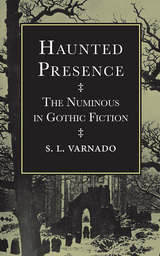 Haunted Presence: The Numinous in Gothic Fiction
S. L. Varnado
University of Alabama Press, 1987 Are ghosts, vampires, and other forms of “haunted presence” related to universal religious instincts? Are emotions that play a part in religious ritual and narrative similar to those in classical works of Gothic fiction such as Dracula, Frankenstein, The Turn of the Screw, and the tales of Edgar Allan Poe? Haunted Presence: The Numinous in Gothic Fiction reveals the intersection of Gothic literature and contemporary theories about the psychology of religious experience, positing that the two share the concept of the numinous, the human response of awe in the face of the eternal.
Varnado offers a fresh and audacious analysis of the literature of the supernatural by employing insights derived from the philosophy of religious experience. Ranging from the Gothic novel of the eighteenth century to ghostly tales from the nineteenth and twentieth centuries, Varnado frames ghost stories as ontological challenge to the reader. The challenge is not in the form of philosophical proposition, however. Rather it is in the form of feelings and emotions that maintain a connection with the sense of reality. It is this area of reality that Rudolph Otto called the numinous—the feeling of the supernatural—that stands at the center of Gothic literature.
An understanding of this unique category of experience, aligned with its associated concept of “the sacred and the profane,” exposes the purpose of ghostly literature and demonstrates the enduring relevance of this mesmerizing genre.
The Haunted Stage: The Theatre as Memory Machine
Marvin Carlson
University of Michigan Press, 2003 Throughout theatrical history, almost every element in stage production has been recycled. Indeed any regular theatergoer is familiar with the experience of a performance that conjures the ghosts of previous productions. The Haunted Stage explores this theatrical déjà vu, and examines how it stimulates the spectator's memory. Relating the dynamics of reception to the interaction between theater and memory, The Haunted Stage uncovers the ways in which the memory of the spectator informs the process of theatrical reception.
Marvin Carlson is Sidney E. Cohn Distinguished Professor of Theatre and Comparative Literature at the City University of New York.
 Haunted Wisconsin
Michael Norman
University of Wisconsin Press, 2011 Grab a cozy blanket, light a few flickering candles, and enjoy the unnerving tales of Haunted Wisconsin. Gathered from personal interviews with credible eyewitnesses, on-site explorations, historical archives, newspaper reports, and other sources, these scores of reports date from Wisconsin’s early settlement days to recent inexplicable events.
You’ll read about Wisconsin’s most famous haunted house, Summerwind; three Milwaukee men who encountered the beautiful ghost of National Avenue; a phantom basketball player; a spectral horse that signaled death in the pioneer era of the Wisconsin Dells; a poltergeist in St. Croix County who attracted a crowd of more than three hundred spectators; the Ridgeway Ghost who haunts the driftless valleys of southwestern Wisconsin; a swinging railroad lantern held by unseen hands; the Ghost Island of the Chippewa Flowage; and many others. Are ghosts real? That’s for you to decide!
Now available in a Third Edition with updates and several new accounts, Haunted Wisconsin remains a favorite collection of unexplained midwestern tales, enjoyed by readers of all ages.
The Haunting
Cate Peebles
Tupelo Press, 2025 A collection of poems concerned with how the living and the dead coexist, how to survive trauma, and the power of persistence.
The Haunting is a book of feminist-horror visitations, incantations, and possessions embodied in unruly forms that subvert genre and generic definitions of poetry and prose. This is a collection that is concerned with how the living and the dead coexist, how to survive trauma, and the power of persistence. Drawing from a variety of texts including Mary Shelley’s Frankenstein, Emily Bronte’s Wuthering Heights, twentieth-century horror films, the Velvet Underground, and Ovid, The Haunting explores the anxieties of ancestral and artistic inheritance, rage, transformation, motherhood, maternal ambivalence, and the drive to create.
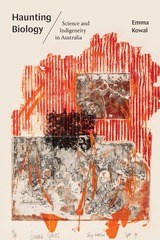 Haunting Biology: Science and Indigeneity in Australia
Emma Kowal
Duke University Press, 2023 In Haunting Biology Emma Kowal recounts the troubled history of Western biological studies of Indigenous Australians and asks how we now might see contemporary genomics, especially that conducted by Aboriginal and Torres Strait Islander scientists. Kowal illustrates how the material persistence of samples over decades and centuries folds together the fates of different scientific methodologies. Blood, bones, hair, comparative anatomy, human biology, physiology, and anthropological genetics all haunt each other across time and space, together with the many racial theories they produced and sustained. The stories Kowal tells feature a variety of ghostly presences: a dead anatomist, a fetishized piece of hair hidden away in a war trunk, and an elusive white Indigenous person. By linking this history to contemporary genomics and twenty-first-century Indigeneity, Kowal outlines the fraught complexities, perils, and potentials of studying Indigenous biological difference in the twenty-first century.
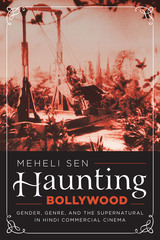 Haunting Bollywood: Gender, Genre, and the Supernatural in Hindi Commercial Cinema
By Meheli Sen
University of Texas Press, 2017 Haunting Bollywood is a pioneering, interdisciplinary inquiry into the supernatural in Hindi cinema that draws from literary criticism, postcolonial studies, queer theory, history, and cultural studies. Hindi commercial cinema has been invested in the supernatural since its earliest days, but only a small segment of these films have been adequately explored in scholarly work; this book addresses this gap by focusing on some of Hindi cinema’s least explored genres. From Gothic ghost films of the 1950s to snake films of the 1970s and 1980s to today’s globally influenced zombie and vampire films, Meheli Sen delves into what the supernatural is and the varied modalities through which it raises questions of film form, history, modernity, and gender in South Asian public cultures. Arguing that the supernatural is dispersed among multiple genres and constantly in conversation with global cinematic forms, she demonstrates that it is an especially malleable impulse that routinely pushes Hindi film into new formal and stylistic territories. Sen also argues that gender is a particularly accommodating stage on which the supernatural rehearses its most basic compulsions; thus, the interface between gender and genre provides an exceptionally productive lens into Hindi cinema’s negotiation of the modern and the global. Haunting Bollywood reveals that the supernatural’s unruly energies continually resist containment, even as they partake of and sometimes subvert Hindi cinema’s most enduring pleasures, from songs and stars to myth and melodrama.
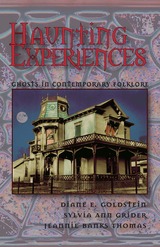 Haunting Experiences: Ghosts in Contemporary Folklore
Diane E. Goldstein, Sylvia Ann Grider, and Jeannie Banks Thomas
Utah State University Press, 2007 Ghosts and other supernatural phenomena are widely represented throughout modern culture. They can be found in any number of entertainment, commercial, and other contexts, but popular media or commodified representations of ghosts can be quite different from the beliefs people hold about them, based on tradition or direct experience. Personal belief and cultural tradition on the one hand, and popular and commercial representation on the other, nevertheless continually feed each other. They frequently share space in how people think about the supernatural.
In Haunting Experiences, three well-known folklorists broaden the discussion of ghost lore by examining it from a variety of angles in various modern contexts. Diane E. Goldstein, Sylvia Ann Grider, and Jeannie Banks Thomas take ghosts seriously, as they draw on contemporary scholarship that emphasizes both the basis of belief in experience (rather than fantasy) and the usefulness of ghost stories. They look closely at the narrative role of such lore in matters such as socialization and gender, and unravel the complex mix of mass media, commodification, and popular culture that today puts old spirits into new contexts.
The Haunting of Sylvia Plath
Jacqueline Rose
Harvard University Press, 1992 Since her death in 1963 at the age of thirty, Sylvia Plath has become a strange icon---an object of intense speculation, fantasy, repulsion, and desire. Jacqueline Rose stands back from the debates and looks instead at the swirl of controversy, recognizing it as a phenomenon in itself--one with much to tell us about how a culture selects and judges writers; how we hear women's voices; and how we receive messages from, to, and about our unconscious selves.
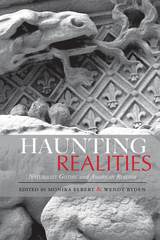 Haunting Realities: Naturalist Gothic and American Realism
Edited by Monika Elbert and Wendy Ryden
University of Alabama Press, 2017 An innovative collection of essays examining the sometimes paradoxical alignment of Realism and Naturalism with the Gothic in American literature to highlight their shared qualities
Following the golden age of British Gothic in the late eighteenth century, the American Gothic’s pinnacle is often recognized as having taken place during the decades of American Romanticism. However, Haunting Realities explores the period of American Realism—the end of the nineteenth century—to discover evidence of fertile ground for another age of Gothic proliferation.
At first glance, “Naturalist Gothic” seems to be a contradiction in terms. While the Gothic is known for its sensational effects, with its emphasis on horror and the supernatural, the doctrines of late nineteenth-century Naturalism attempted to move away from the aesthetics of sentimentality and stressed sobering, mechanistic views of reality steeped in scientific thought and the determinism of market values and biology. Nonetheless, what binds Gothicism and Naturalism together is a vision of shared pessimism and the perception of a fearful, lingering presence that ominously haunts an impending modernity. Indeed, it seems that in many Naturalist works reality is so horrific that it can only be depicted through Gothic tropes that prefigure the alienation and despair of modernism.
In recent years, research on the Gothic has flourished, yet there has been no extensive study of the links between the Gothic and Naturalism, particularly those which stem from the early American Realist tradition. Haunting Realities is a timely volume that addresses this gap and is an important addition to scholarly work on both the Gothic and Naturalism in the American literary tradition.
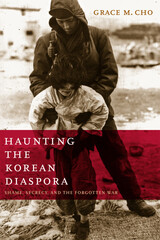 Haunting the Korean Diaspora: Shame, Secrecy, and the Forgotten War
Grace M. Cho
University of Minnesota Press, 2008 An engrossing encounter with lingering ghosts of the Korean War Since the Korean War—the forgotten war—more than a million Korean women have acted as sex workers for U.S. servicemen. More than 100,000 women married GIs and moved to the United States. Through intellectual vigor and personal recollection, Haunting the Korean Diaspora explores the repressed history of emotional and physical violence between the United States and Korea and the unexamined reverberations of sexual relationships between Korean women and American soldiers. Grace M. Cho exposes how Koreans in the United States have been profoundly affected by the forgotten war and uncovers the silences and secrets that still surround it, arguing that trauma memories have been passed unconsciously through a process psychoanalysts call “transgenerational haunting.” Tracing how such secrets have turned into “ghosts,” Cho investigates the mythic figure of the yanggongju, literally the “Western princess,” who provides sexual favors to American military personnel. She reveals how this figure haunts both the intimate realm of memory and public discourse, in which narratives of U.S. benevolence abroad and assimilation of immigrants at home go unchallenged. Memories of U.S. violence, Cho writes, threaten to undo these narratives—and so they have been rendered unspeakable.At once political and deeply personal, Cho’s wide-ranging and innovative analysis of U.S. neocolonialism and militarism under contemporary globalization brings forth a new way of understanding—and remembering—the impact of the Korean War.
 Haunting Violations: Feminist Criticism and the Crisis of the "Real"
Edited by Wendy S. Hesford and Wendy Kozol
University of Illinois Press, 2000
Feminist critics place a premium on the "real" stories told by the victimized and the oppressed. Haunting Violations offers a corrective to such uncritical acceptance of the "real" in confessional, testimonial, and ethnographic narratives. Through close readings of a wide variety of texts, contributors argue that depictions of the "real" are inherently performative, crafted within the limits and in the interests of specific personal, political, or social projects.
Haunting Violations explores the inseparability of discourse and politics in quasi-autobiographical works such as I, Rigoberta Menchú and When Heaven and Earth Changed Places. Contributors consider how the Sri Lankan Mother's Front movement exploits the sanctity of the maternal and how multiple political purposes on both sides bleed through government "documentary" photographs of Japanese-American concentration camp internees. This volume also investigates how South Asian feminists use the authority of their personal experience to critique the film Mississippi Masala and how realist narratives, such as Janet Campbell Hale's autobiographical Bloodlines, Margie Strosser's documentary film Rape Stories, and Shekur Kapur's film Bandit Queen, reexamine how assumptions about power and trauma are embedded in the promise of the real.
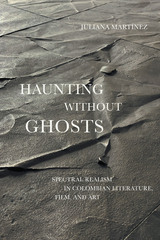 Haunting Without Ghosts: Spectral Realism in Colombian Literature, Film, and Art
By Juliana Martínez
University of Texas Press, 2020 Winner, William M. LeoGrande Prize, Center for Latin American and Latino Studies at American University, 2022 For half a century, cultural production in Colombia has labored under the weight of magical realism—above all, the works of Gabriel García Márquez—where ghosts told stories about the country’s violent past and warned against a similarly gruesome future. Decades later, the story of violence in Colombia is no less horrific, but the critical resources of magical realism are depleted. In their wake comes "spectral realism." Juliana Martínez argues that recent Colombian novelists, filmmakers, and artists—from Evelio Rosero and William Vega to Beatriz González and Erika Diettes—share a formal and thematic concern with the spectral but shift the focus from what the ghost is toward what the specter does. These works do not speak of ghosts. Instead, they use the specter to destabilize reality by challenging the authority of human vision and historical chronology. By introducing the spectral into their work, these artists decommodify well-worn modes of representing violence and create a critical space from which to seek justice for the dead and disappeared. A Colombia-based study, Haunting without Ghosts brings powerful insight to the politics and ethics of spectral aesthetics, relevant for a variety of sociohistorical contexts.
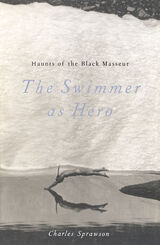 Haunts Of the Black Masseur: The Swimmer as Hero
Charles Sprawson
University of Minnesota Press, 2000 In a masterful work of cultural history, Charles Sprawson, himself an obsessional swimmer and fluent diver, explores the meaning that different cultures have attached to water. Sprawson compares the meaning various societies have assigned to swimming—from classical Greece and imperial Rome to nineteenth-century England and Germany and the U.S. and Japan in the last fifty years. Sprawson gives us fascinating glimpses of the great swimmer heroes: Byron leaping dramatically into the surf at Shelley’s beach funeral; Edgar Allen Poe’s lone and mysterious river-swims; Rupert Brooke swimming naked with Virginia Woolf; Hart Crane swallow-diving to his death in the Bay of Mexico; Johnny Weismuller as athlete and entertainer. Informed by the literature of Swinburne, Goethe, Scott Fitzgerald, and Yukio Mishima; the films of Reifenstahl and Vigo; the Hollywood “swimming musicals” of the 1930s; and delving in and out of Olympic history, Haunts of the Black Masseur is a celebration of swimming that explores aspects of culture in a heretofore unimagined way.
|
|

